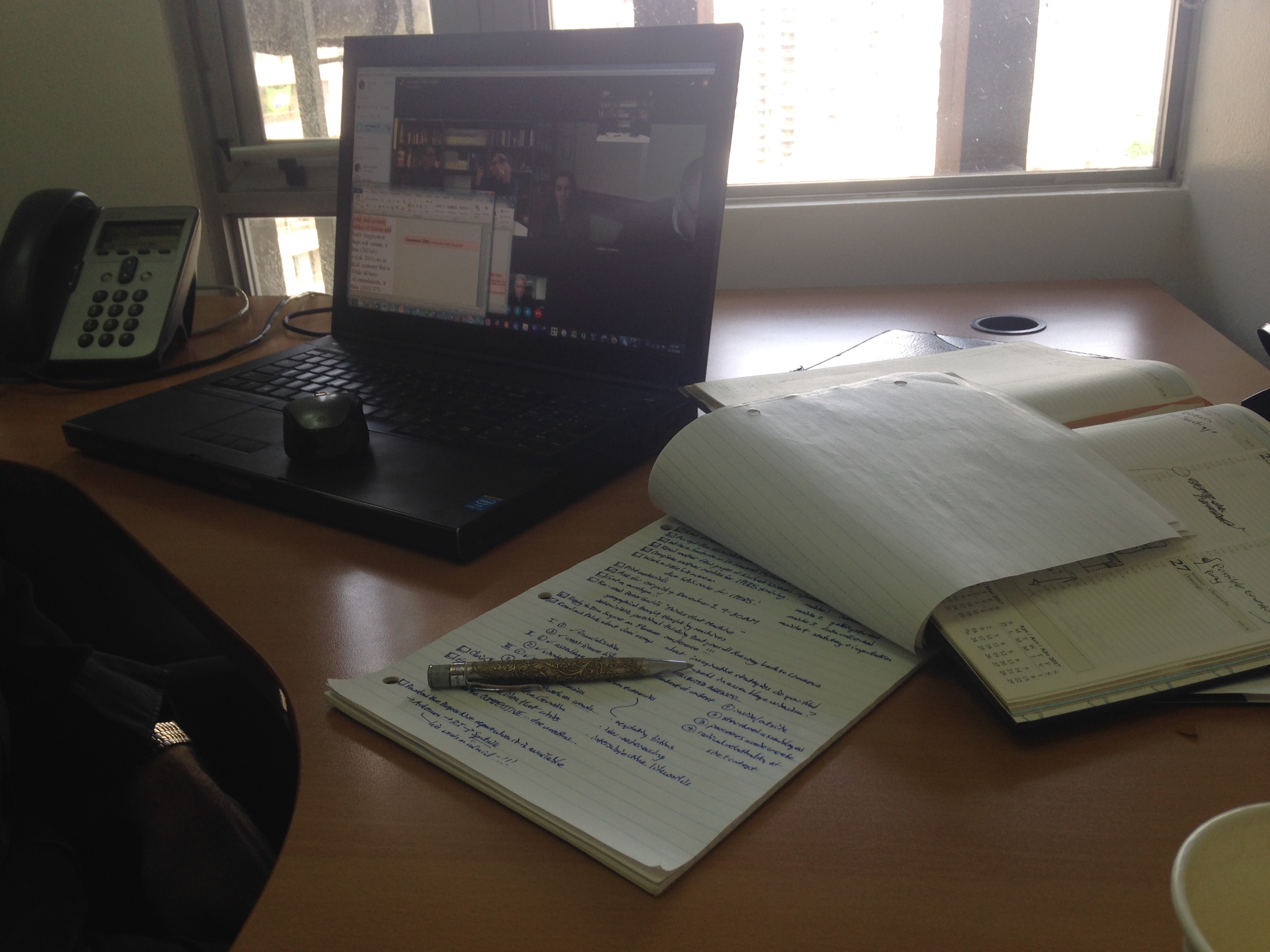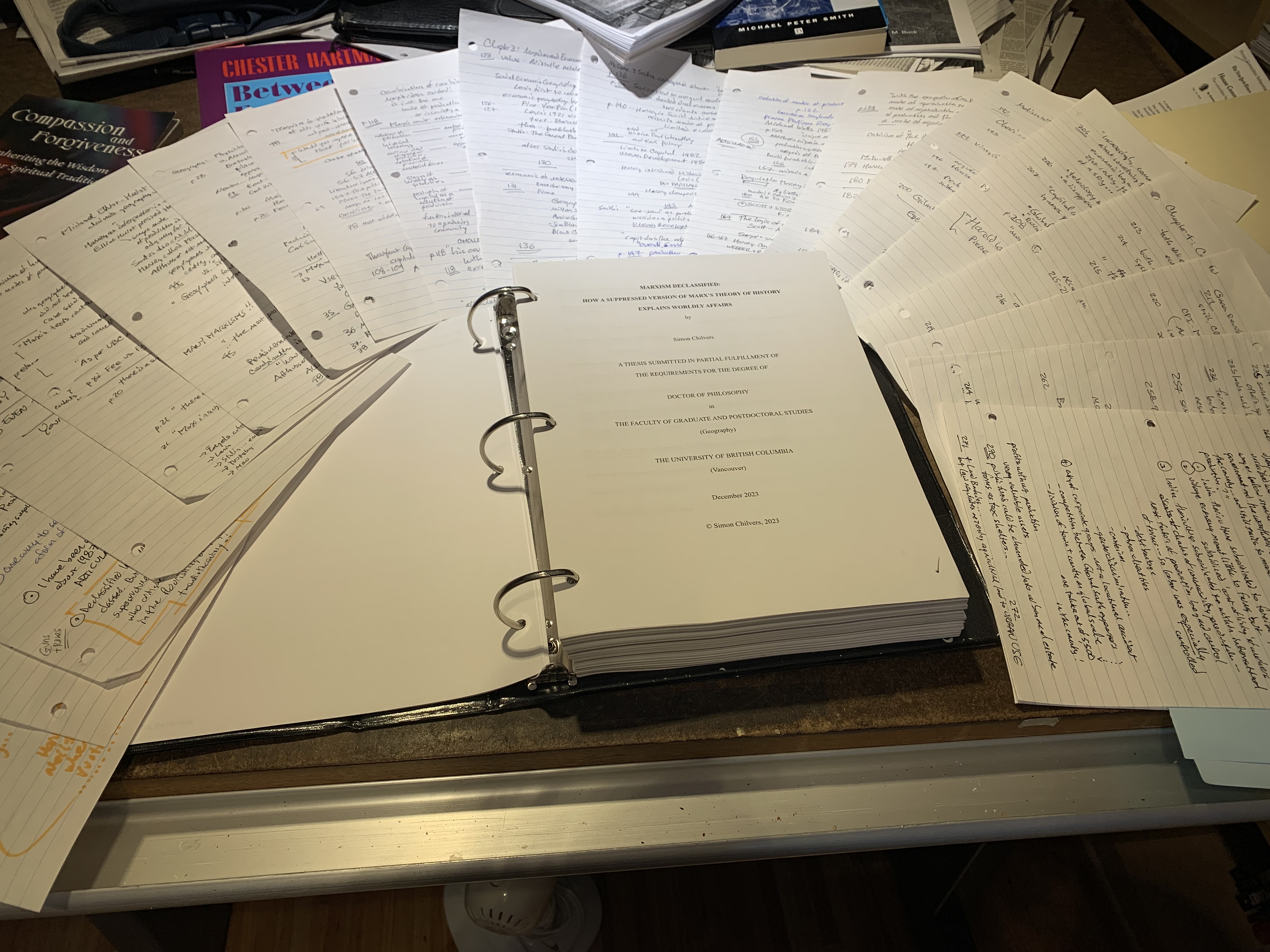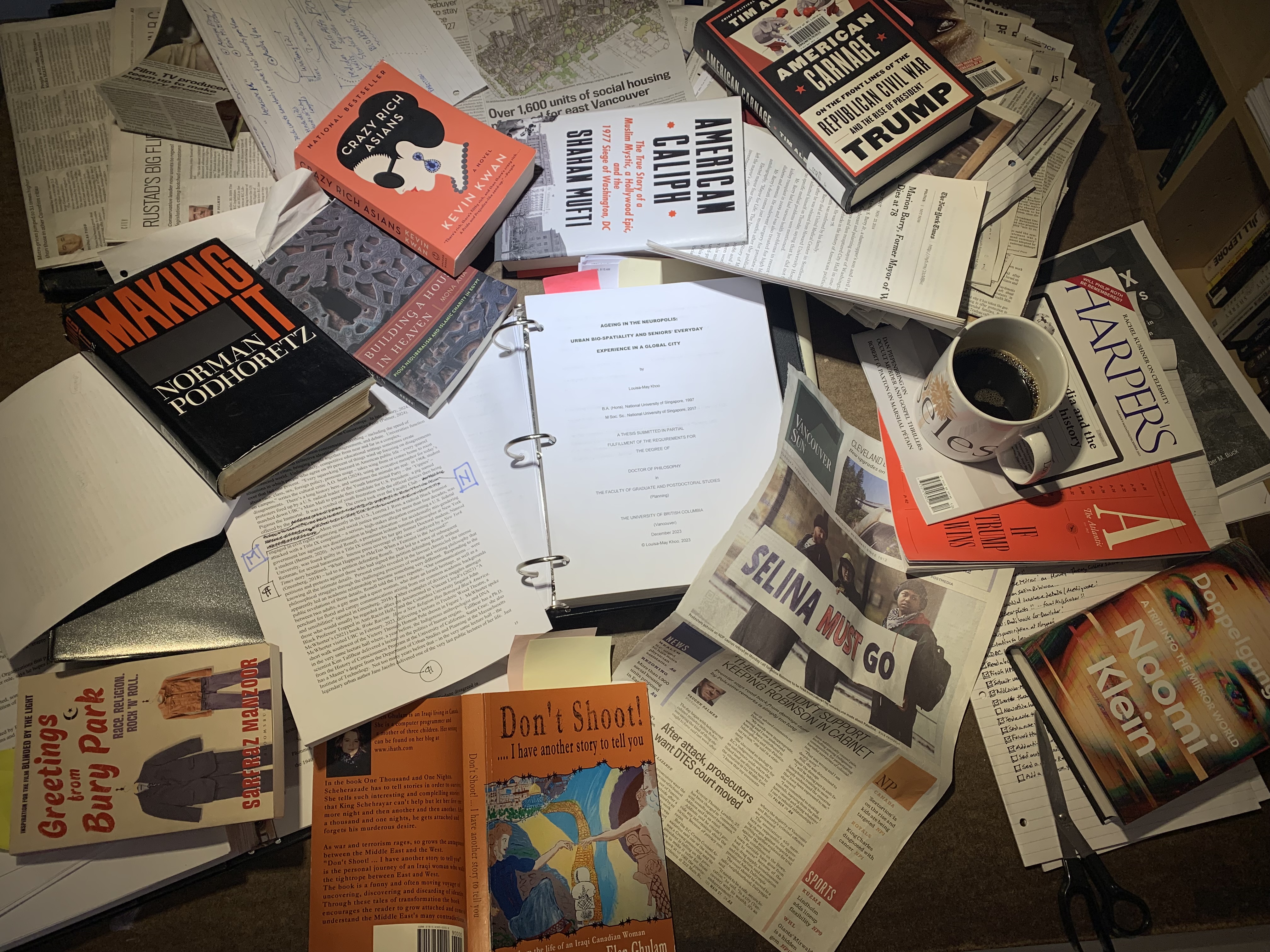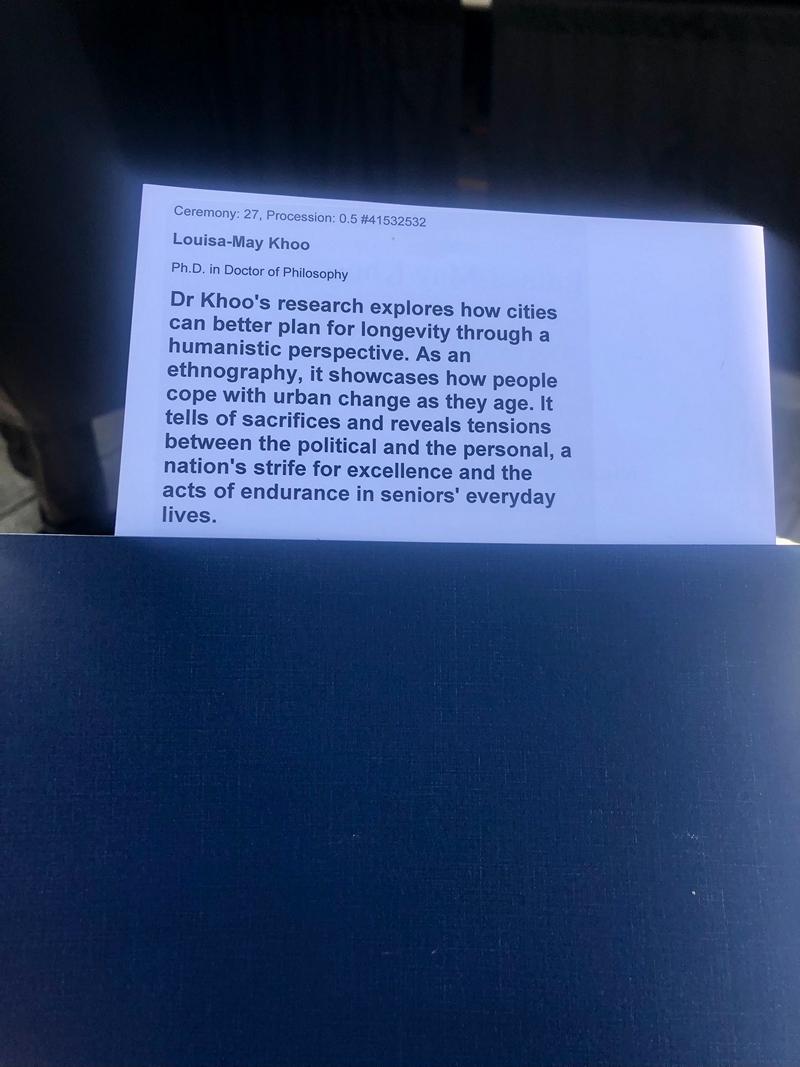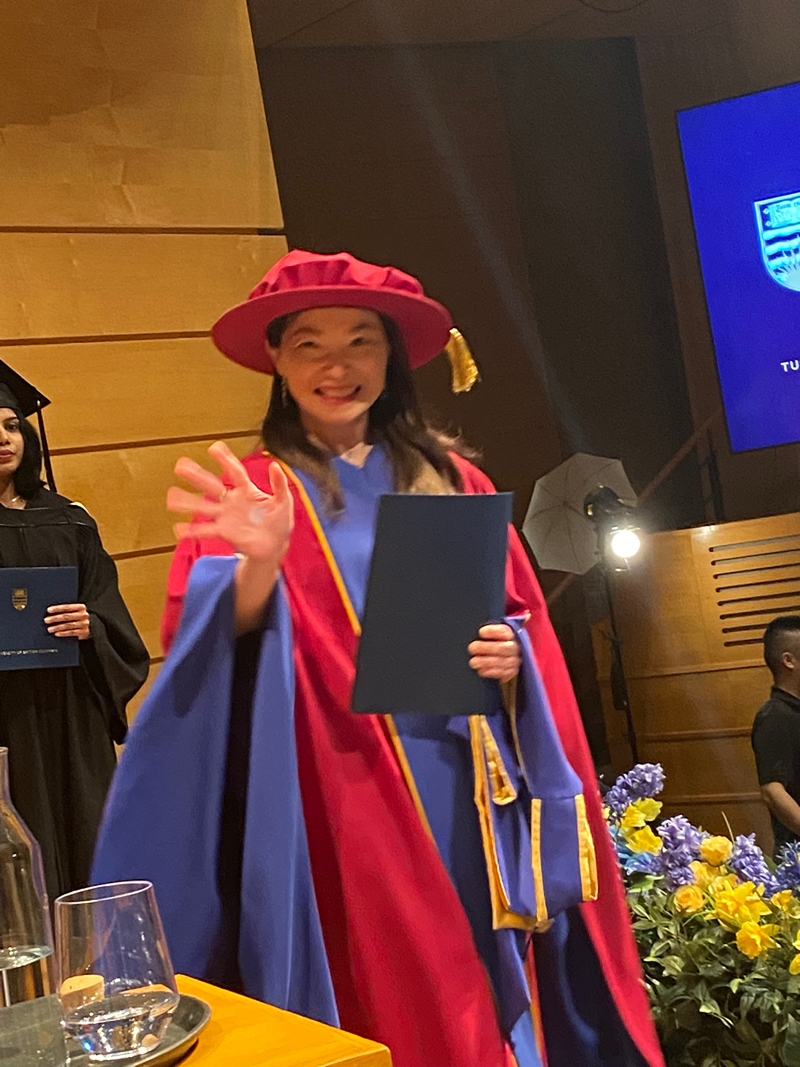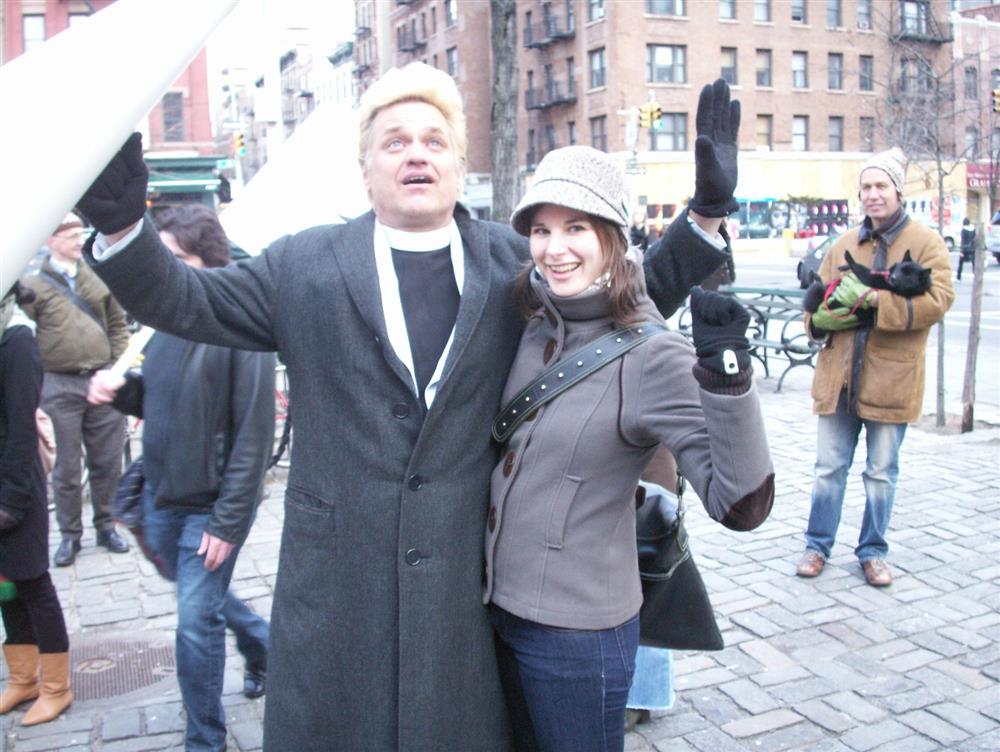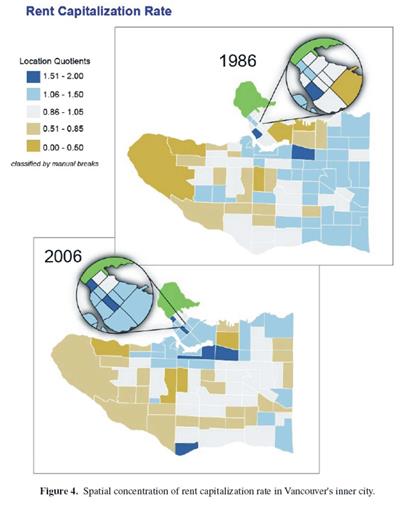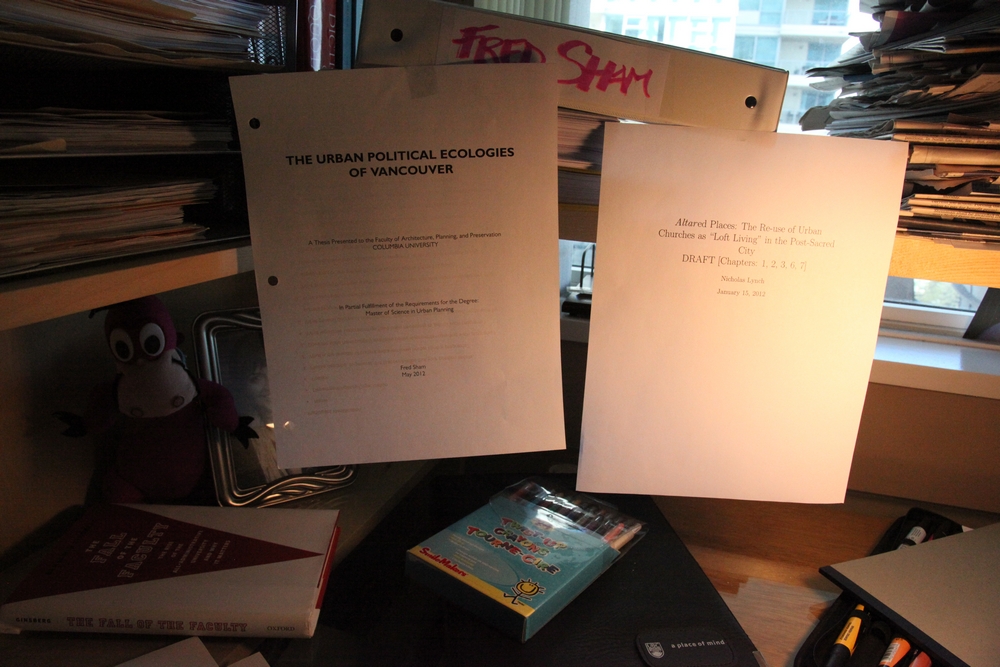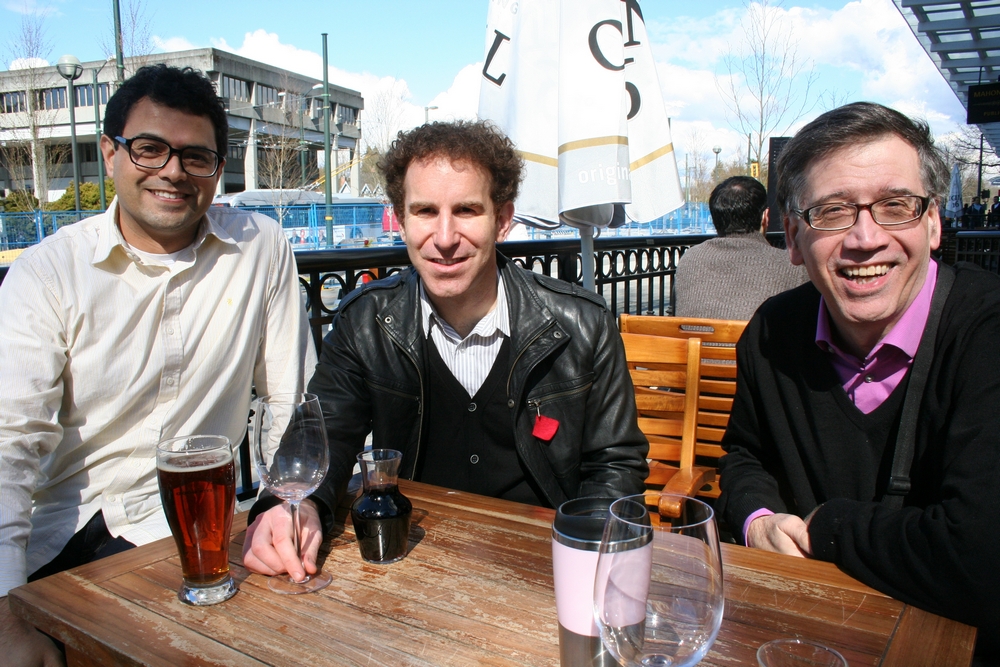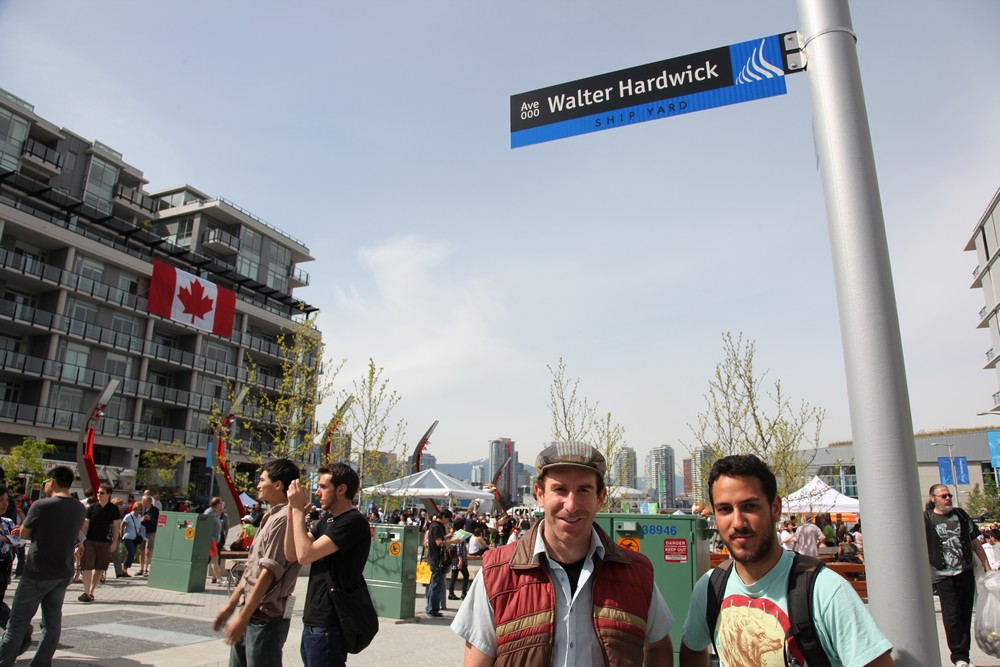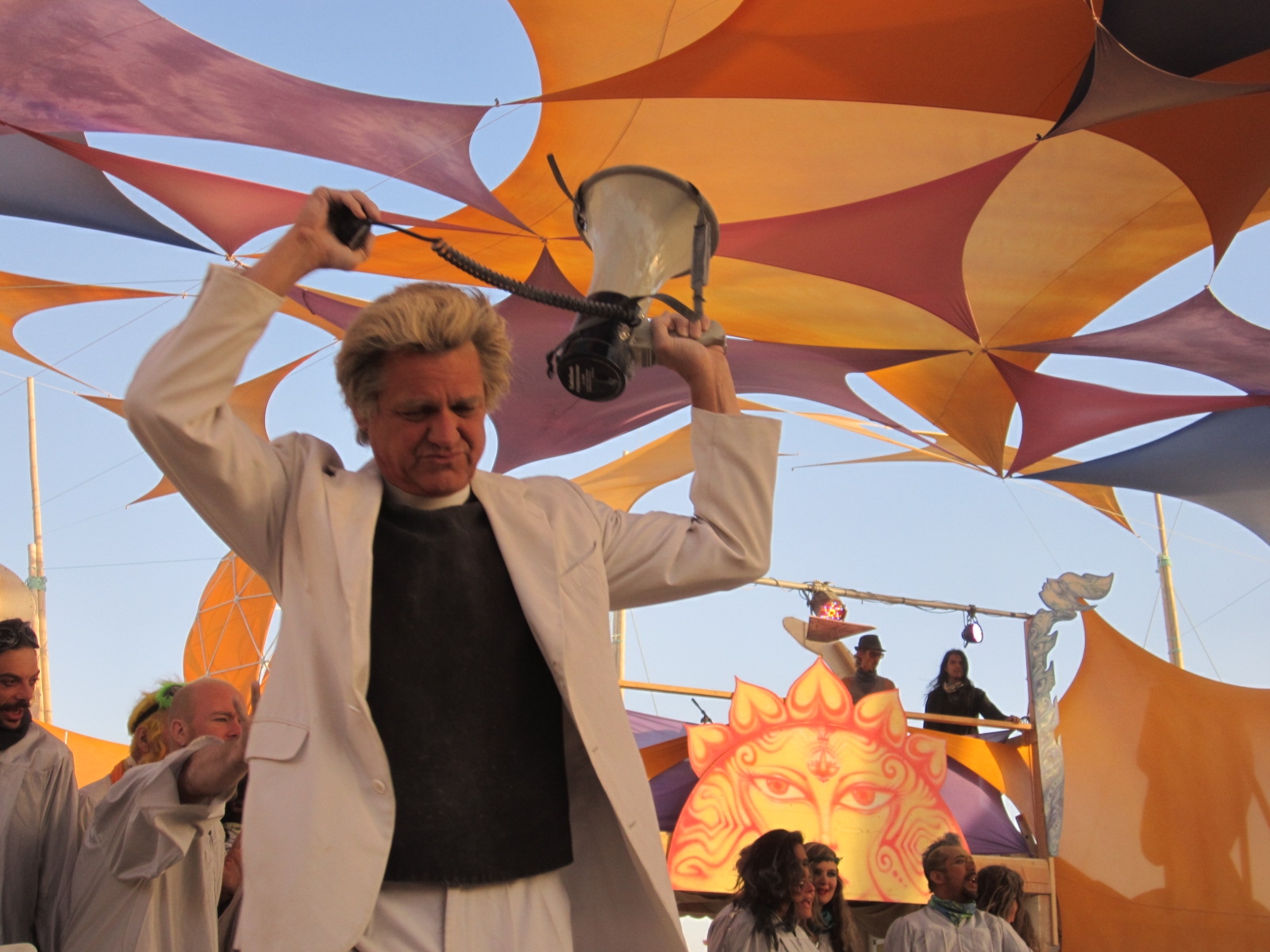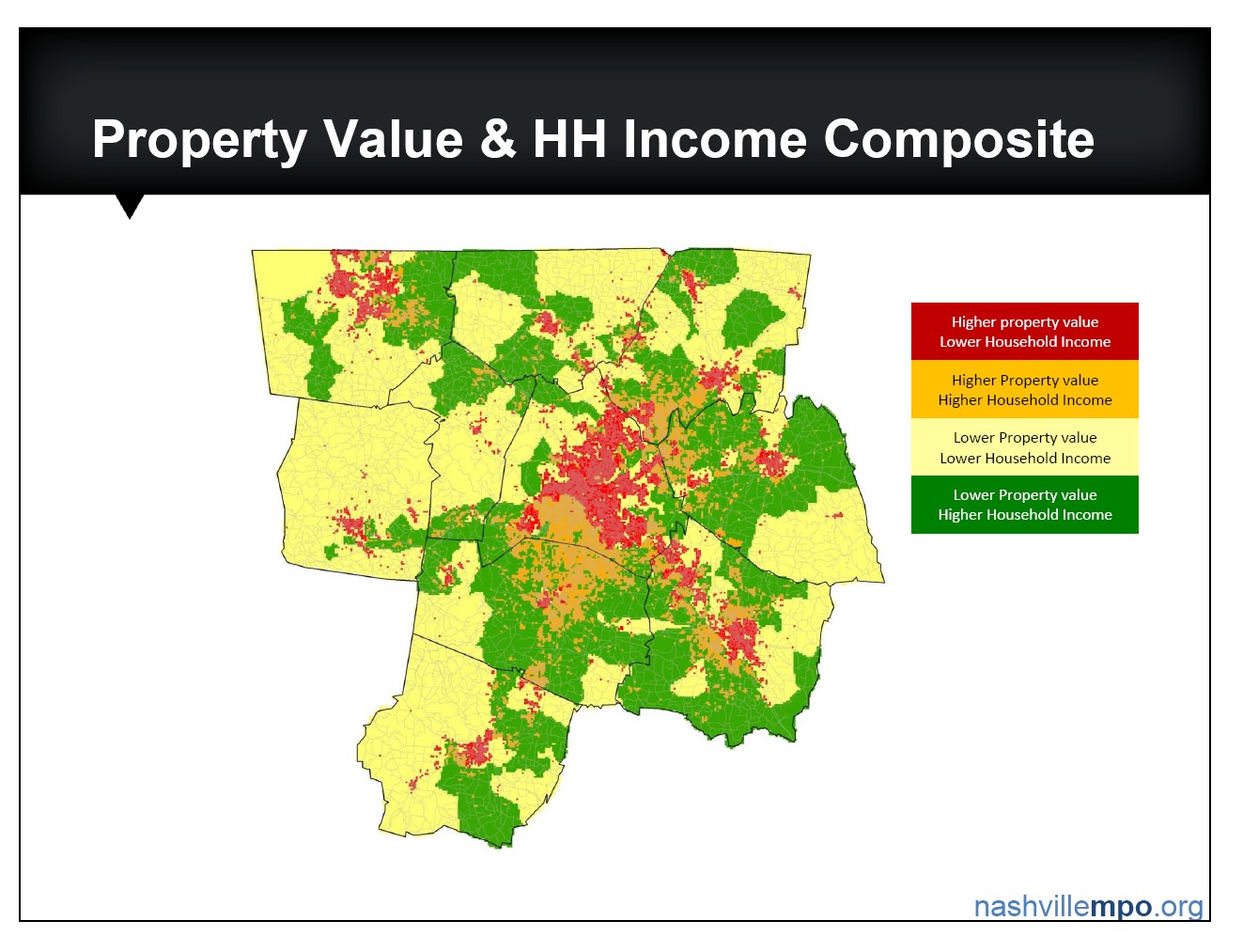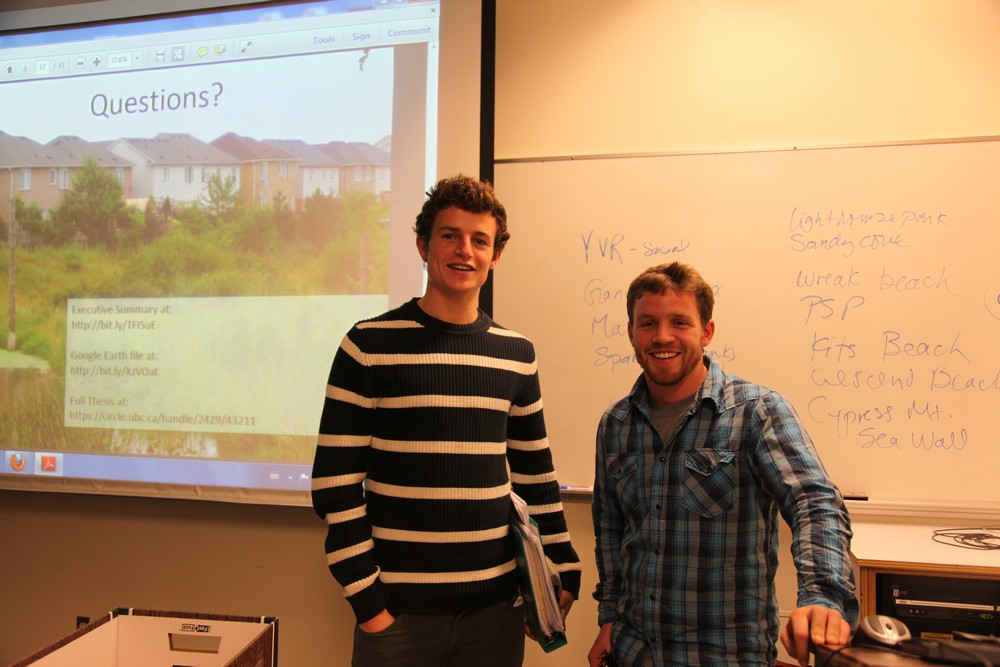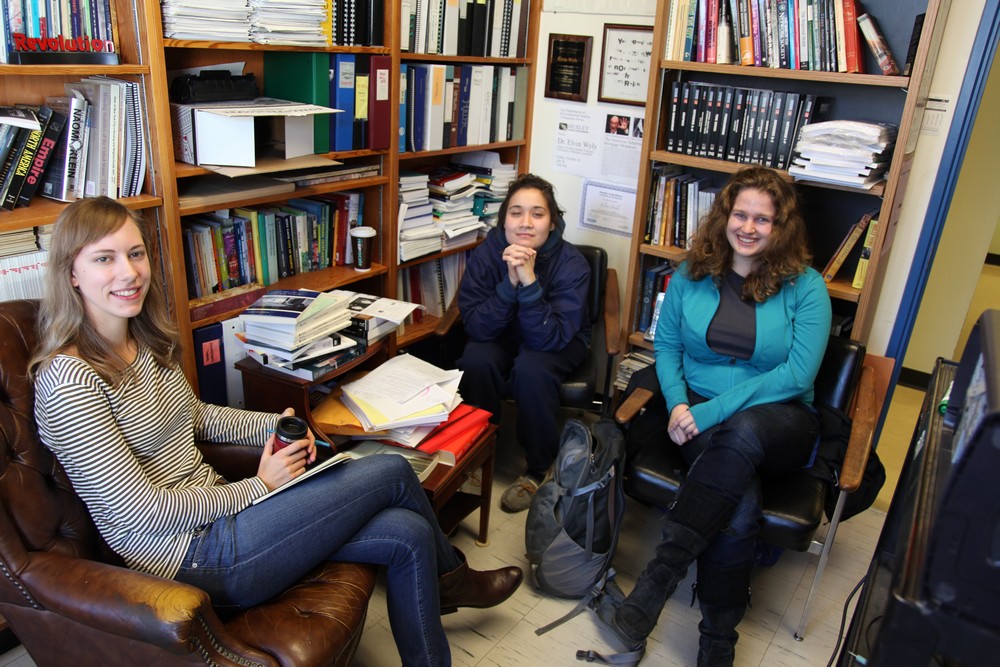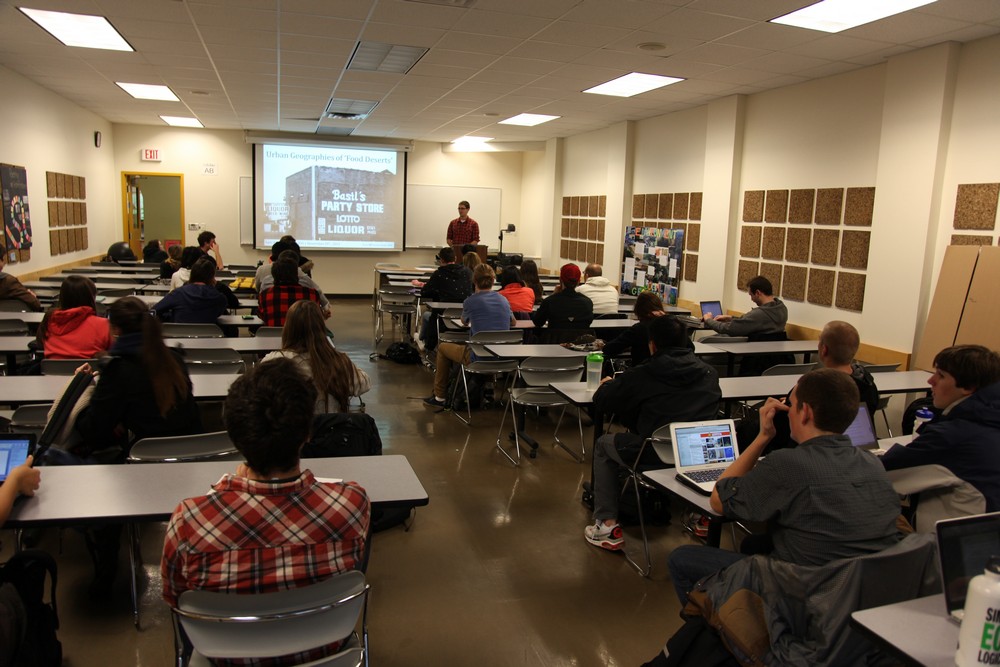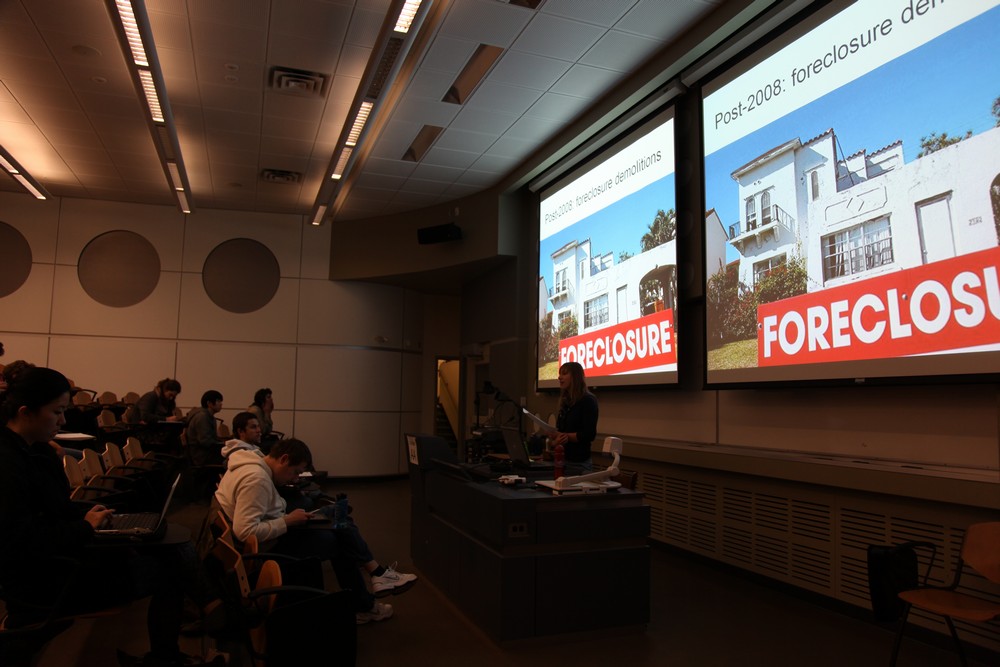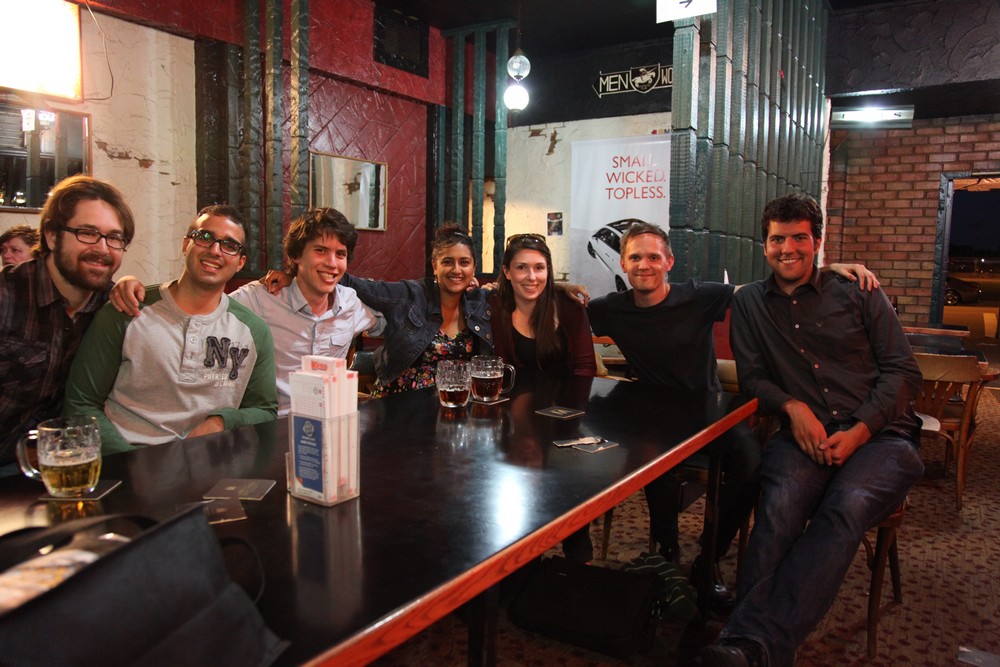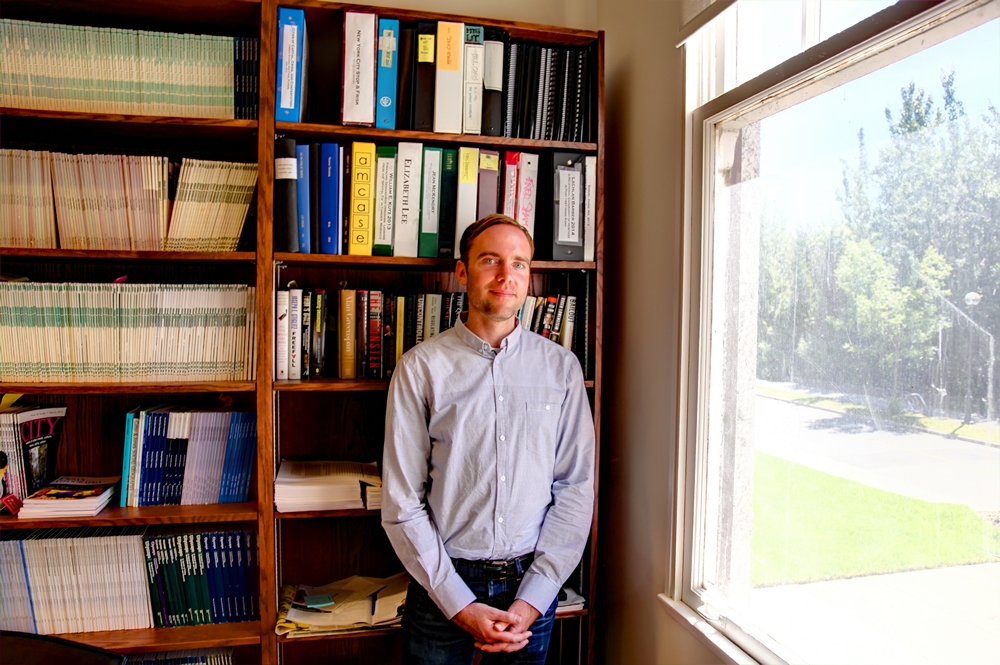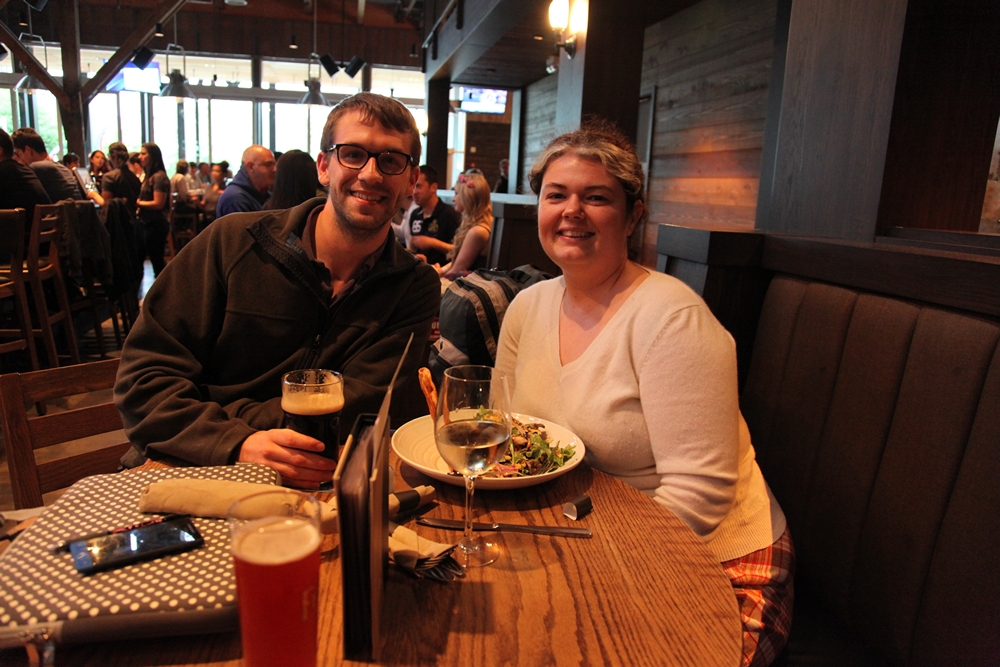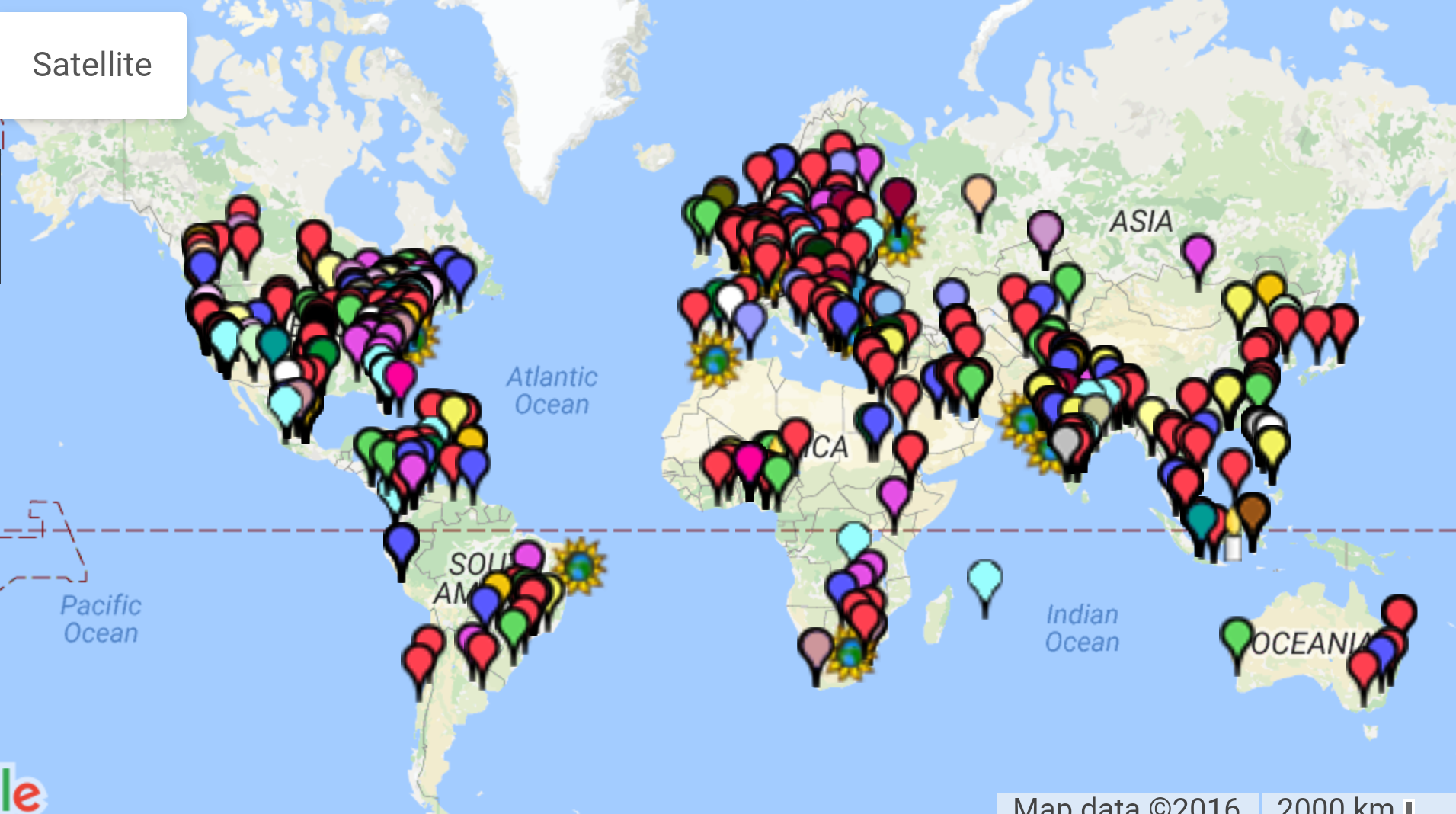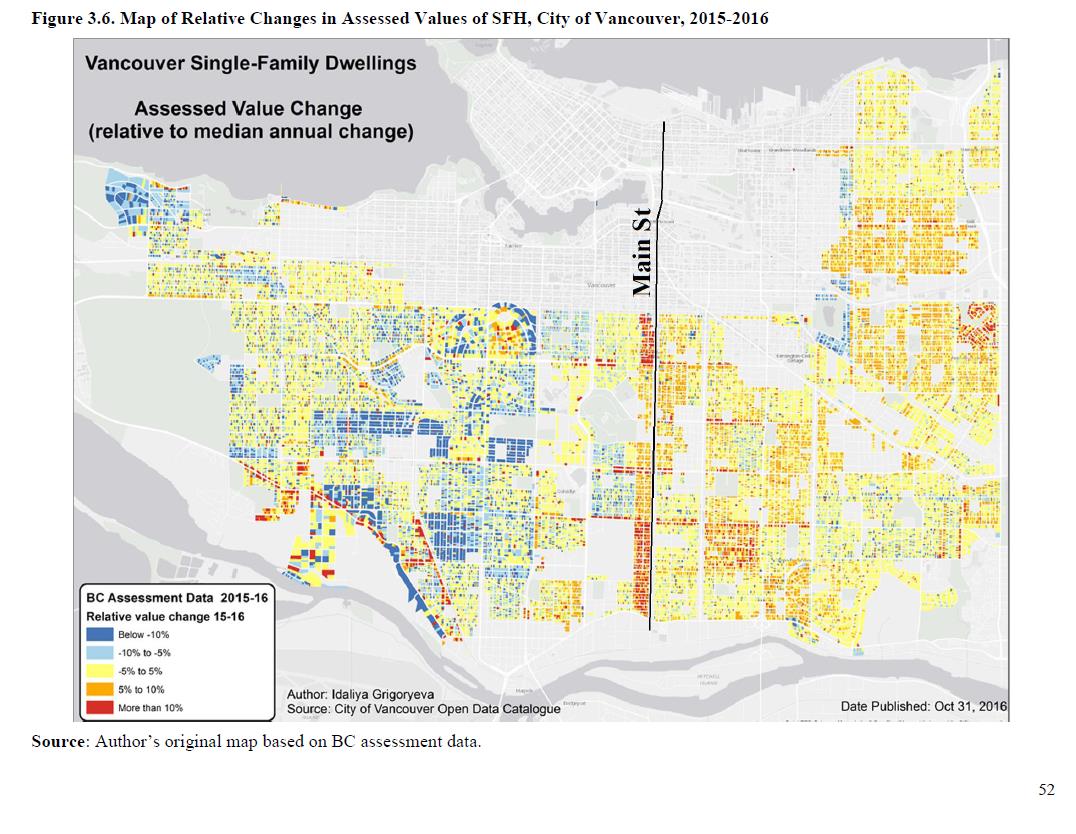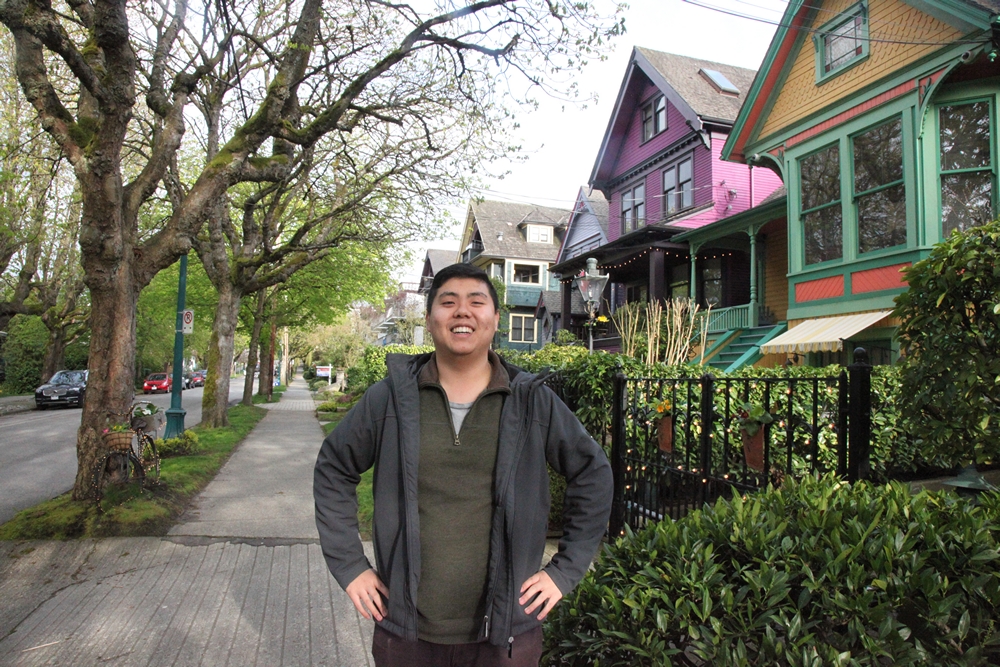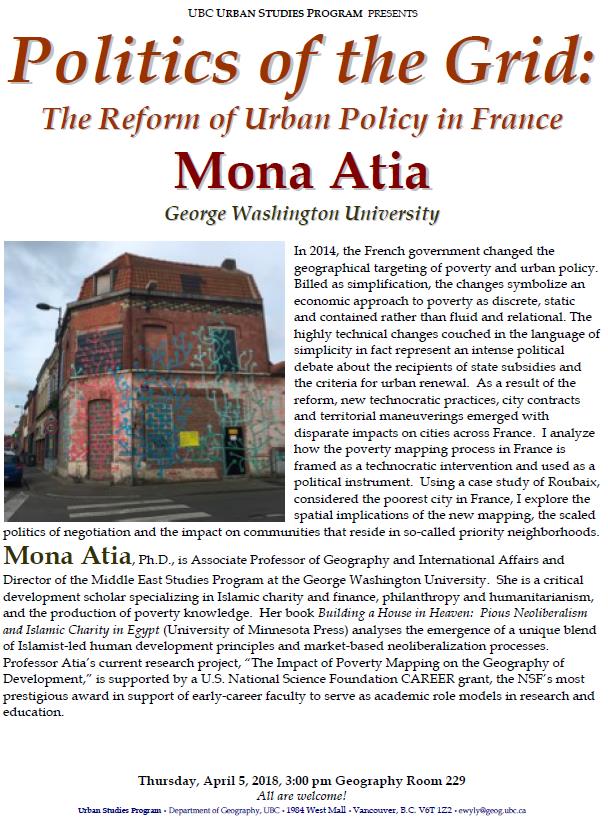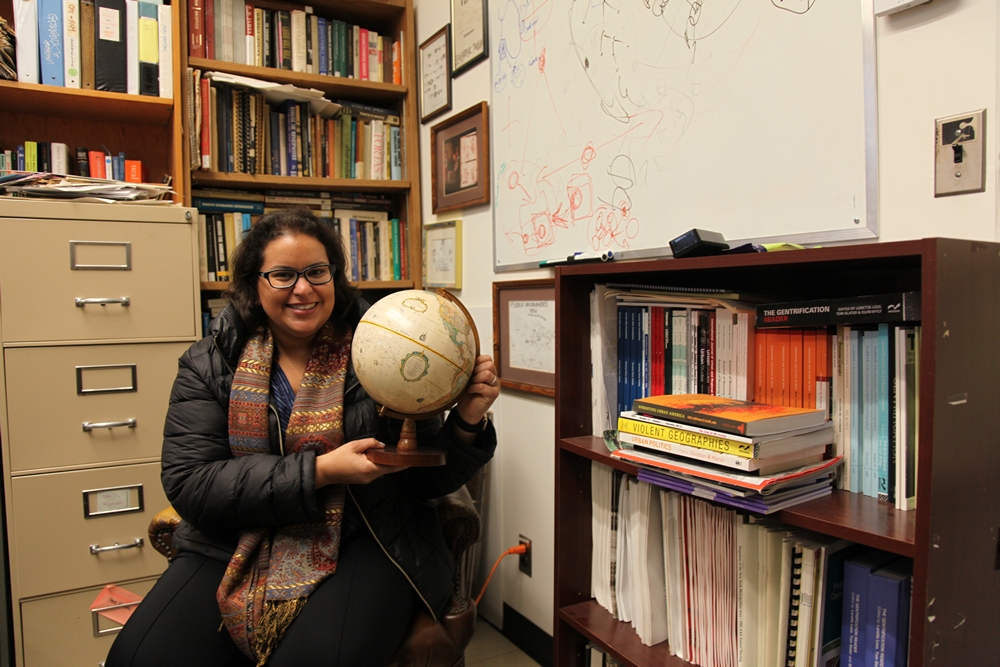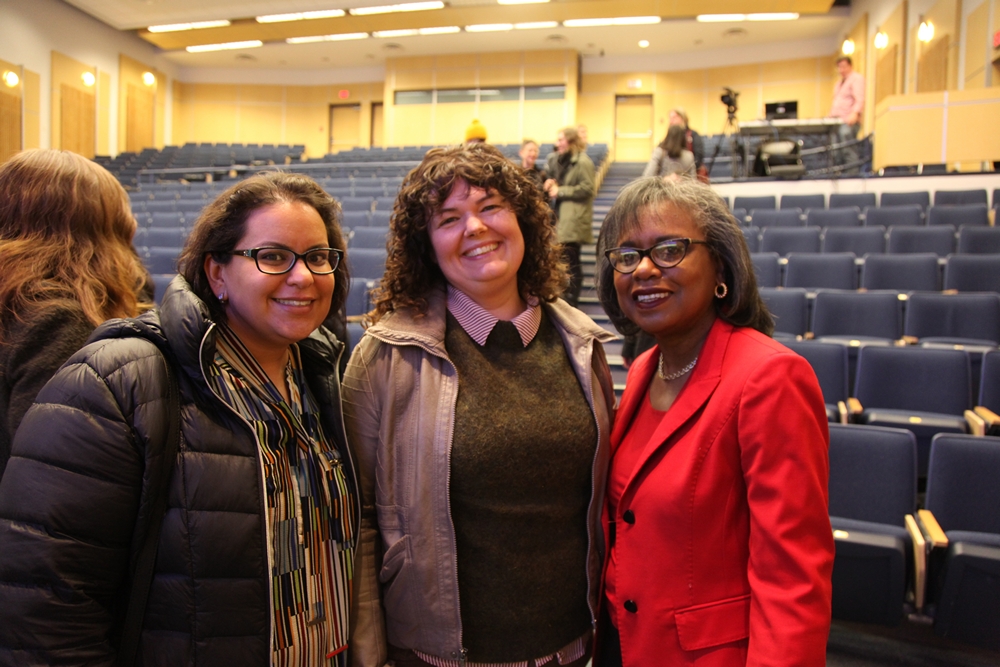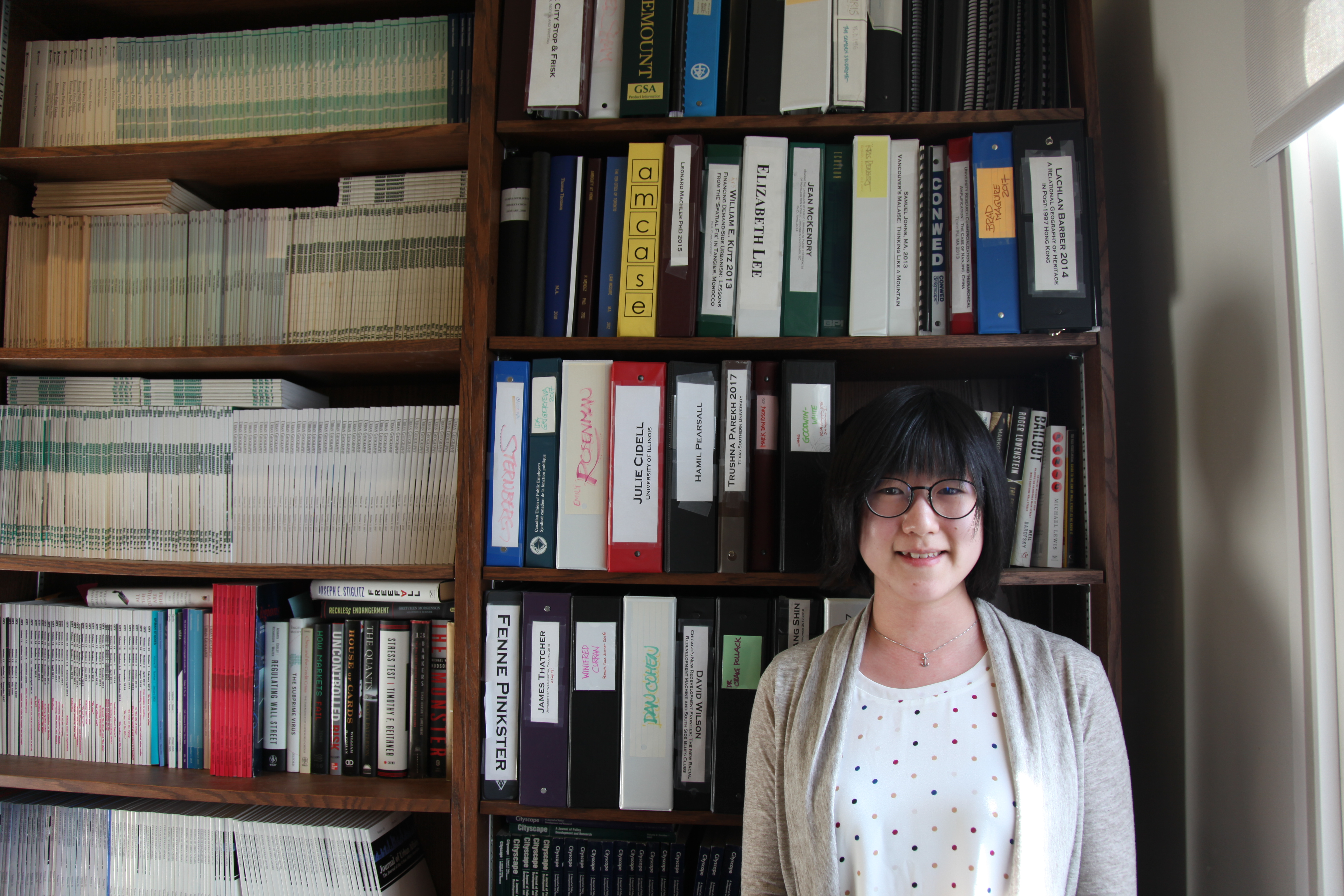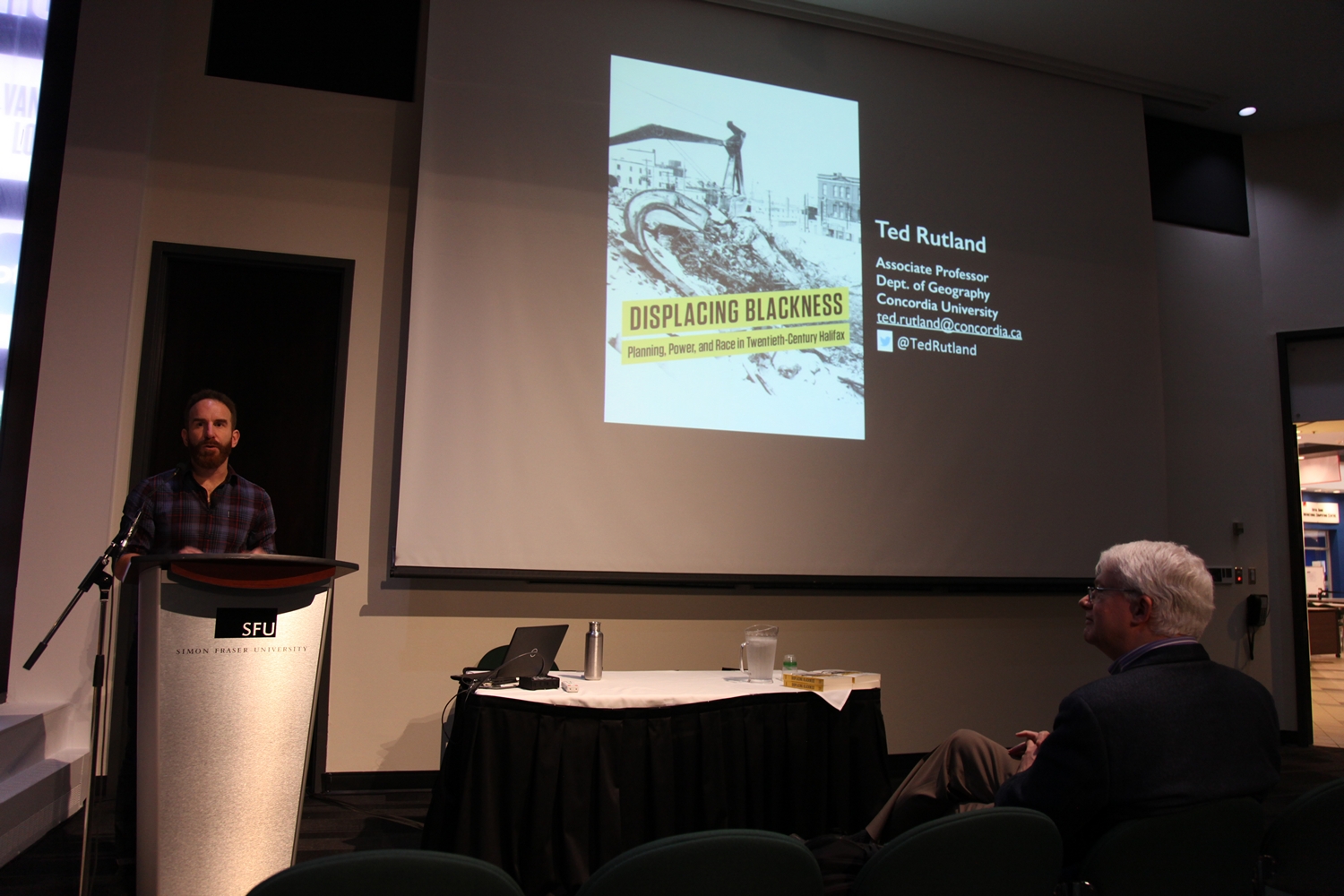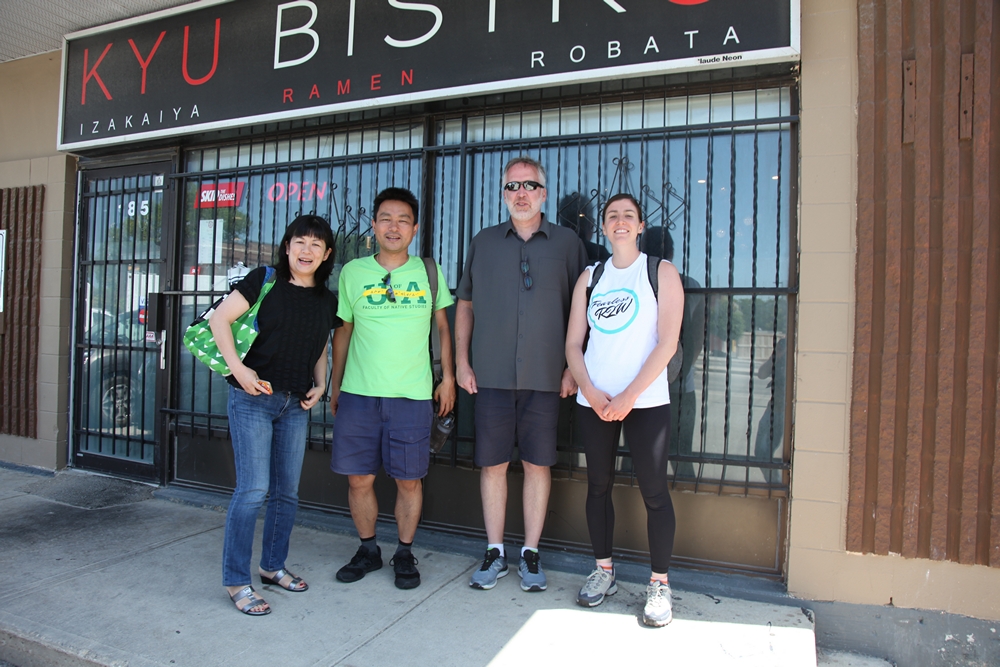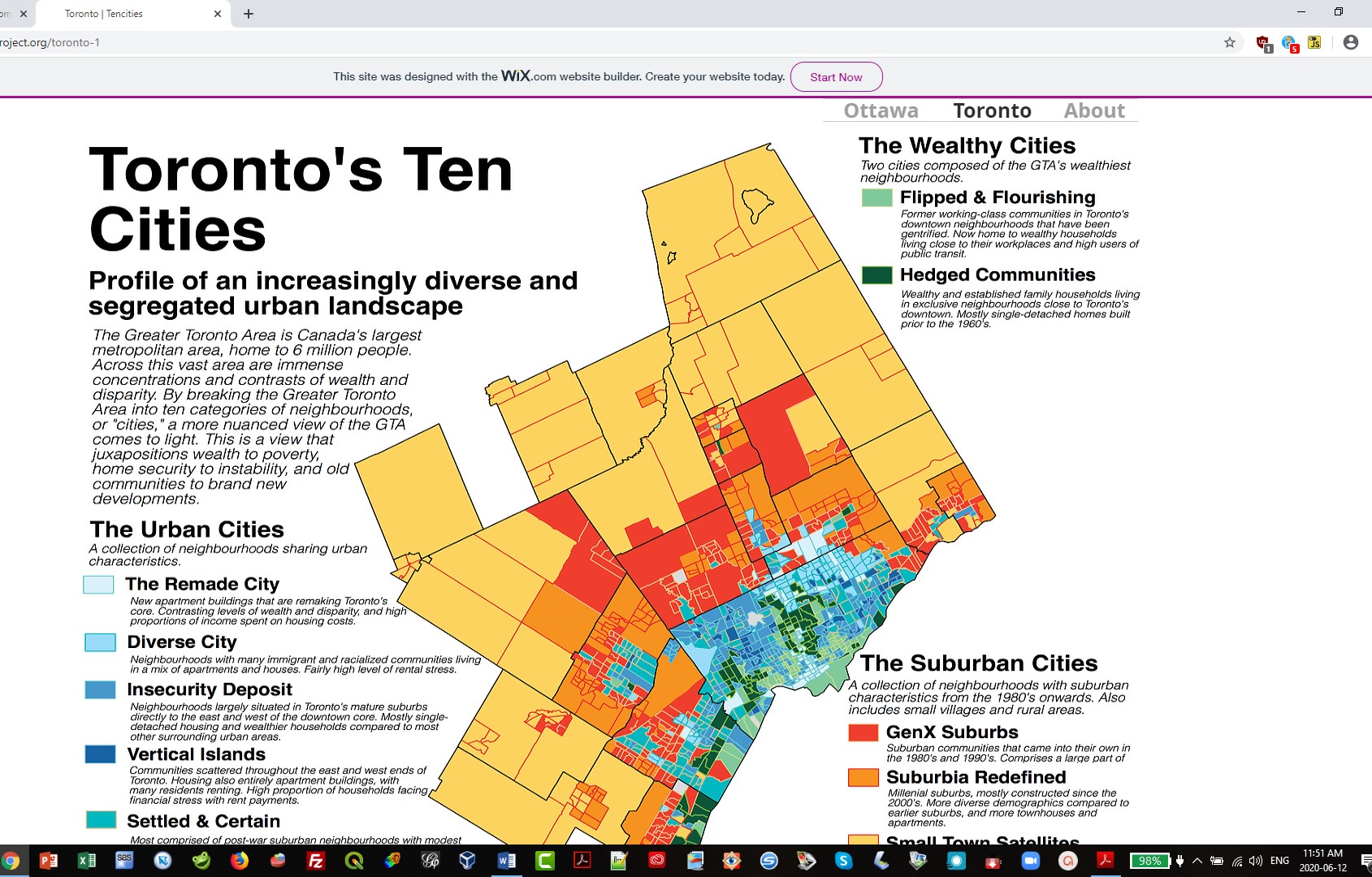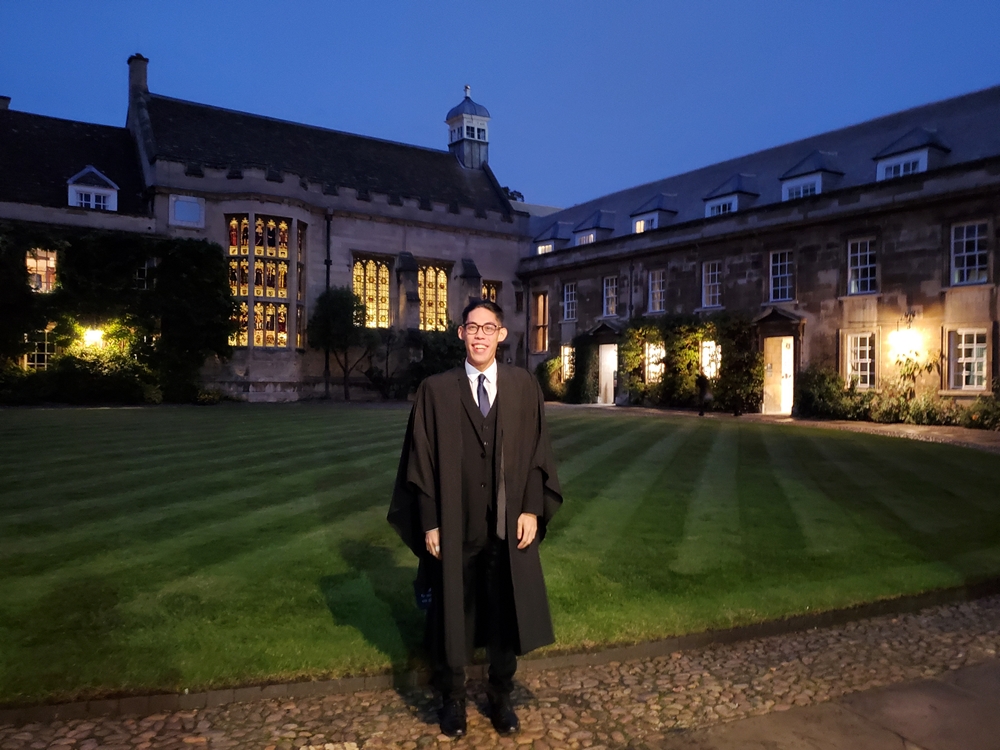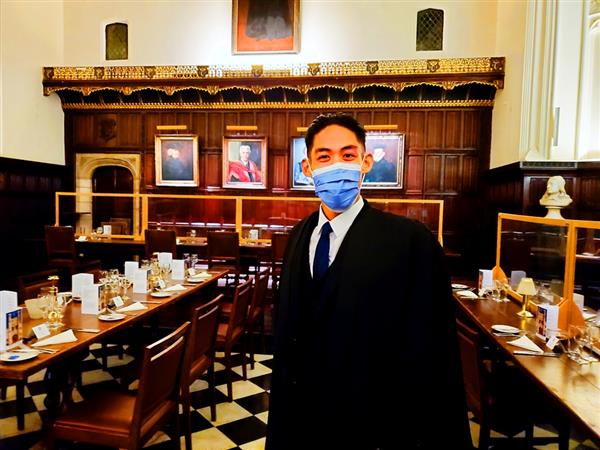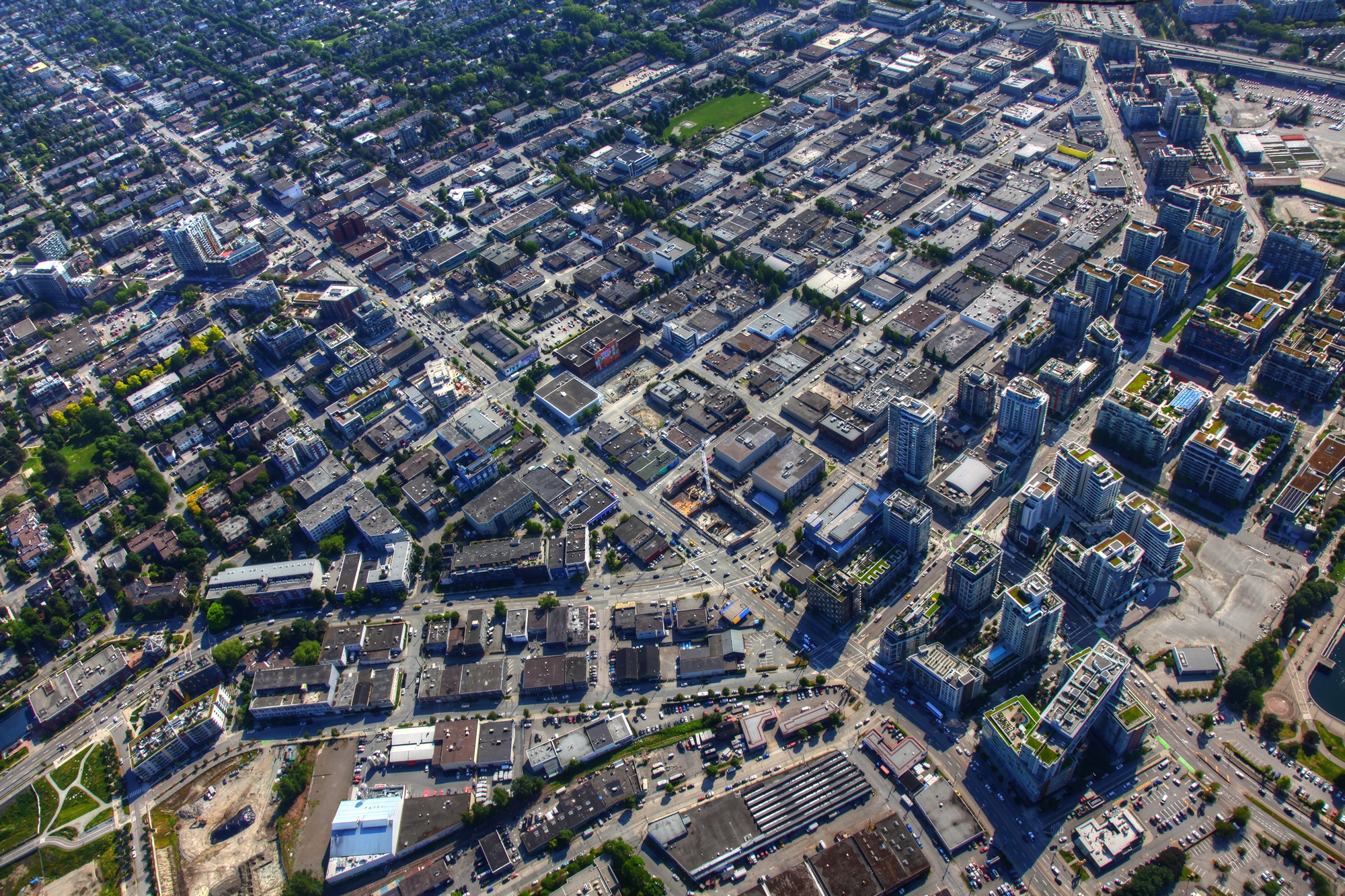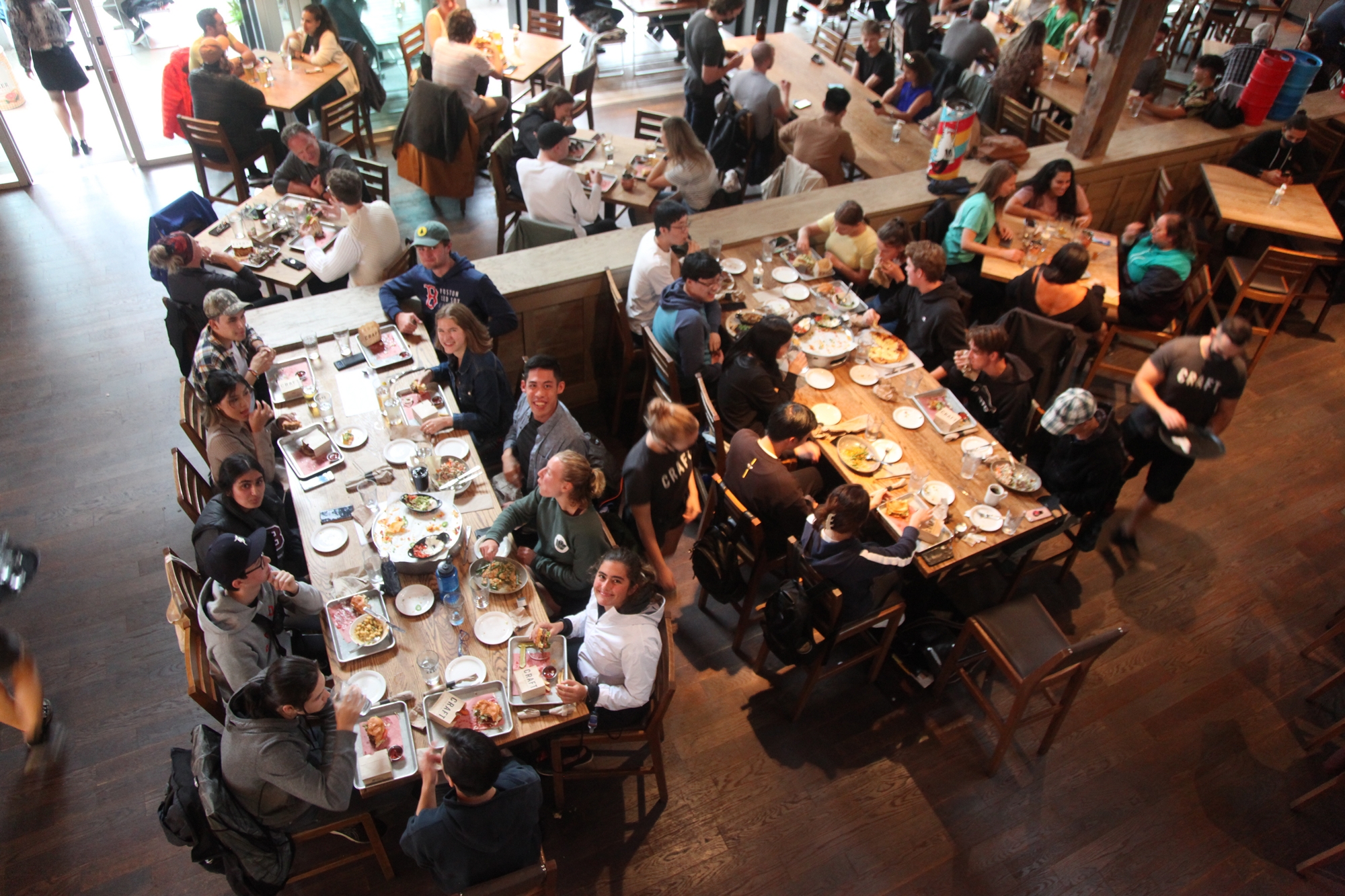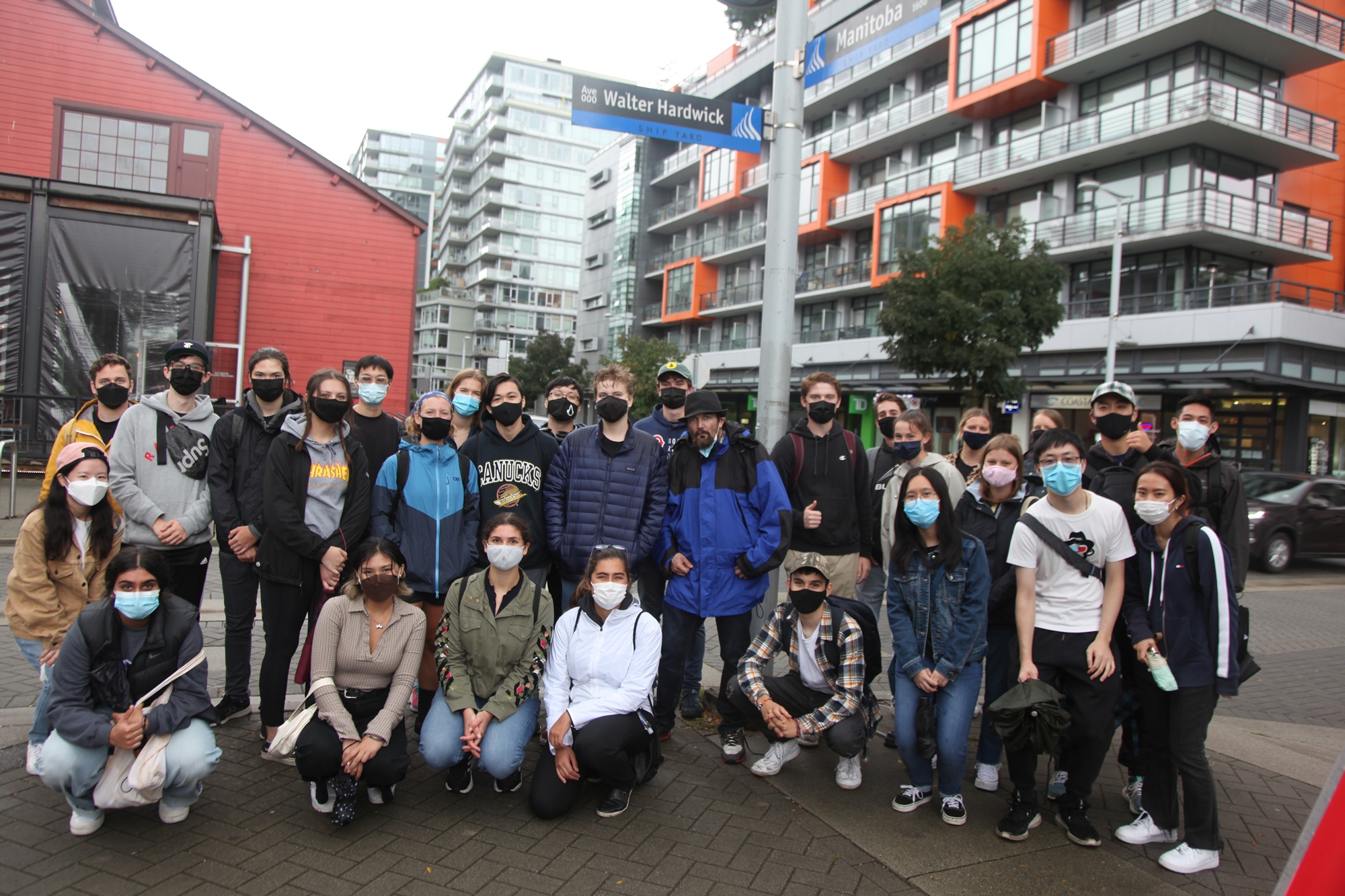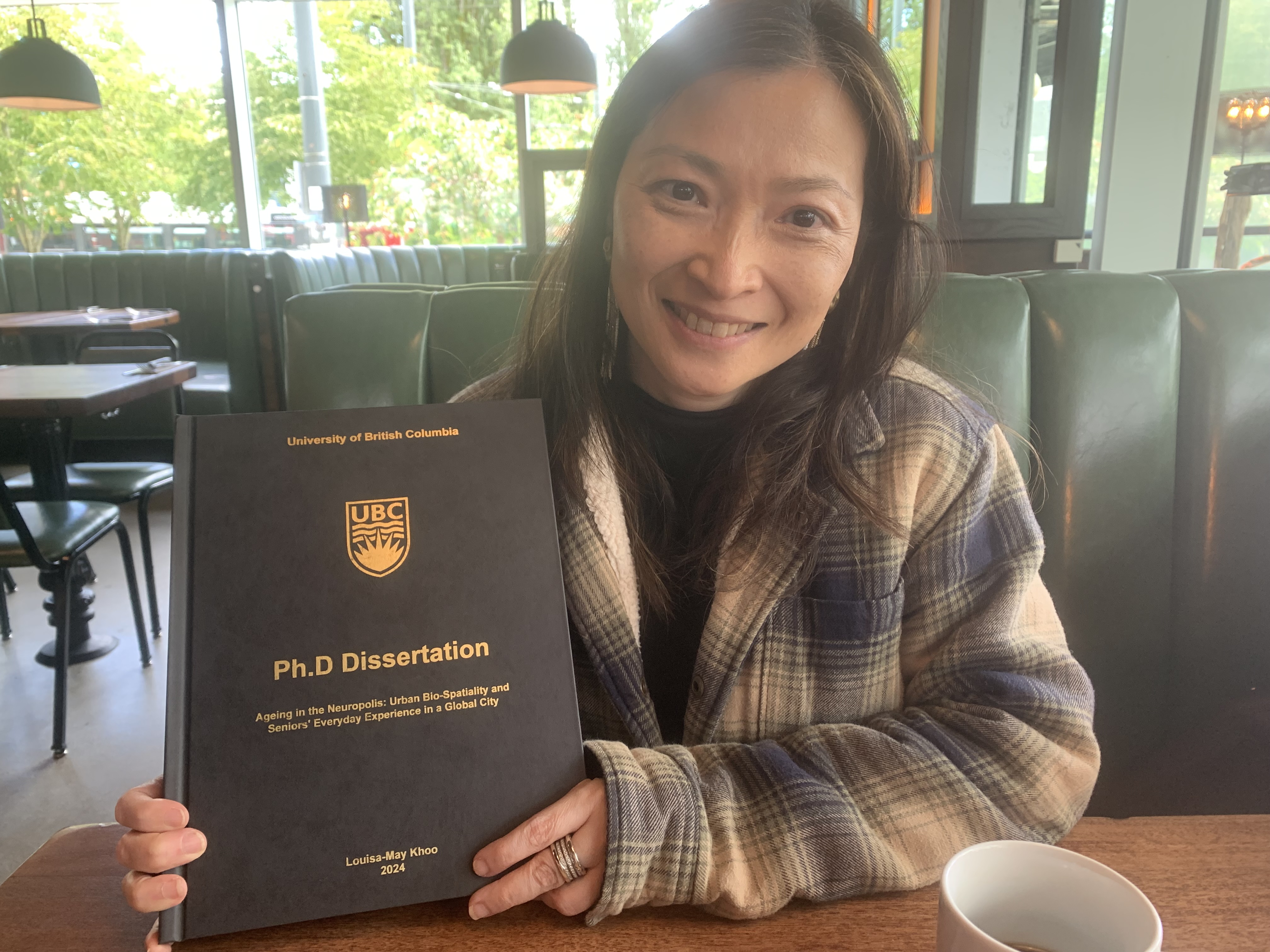

City Coattails
Adventures riding the coattails of my students on coathored publications.
In many cases, the professor lures students into collaborative research, and then adds their name as a second, or third, or fourth coauthor. But sometimes the foundations of the original contribution were built by the student, and my work served only to provide a secondary, supporting role. Here are some examples of coauthored work led by students working with me. For abstracts and such, scroll down to the full treasure-trove of student publications on the right side.
- Björn Surborg, Rob VanWynsberghe, and Elvin Wyly (2008). "Mapping the Olympic Growth Machine: Transnational Urbanism and the Growth Machine Diaspora." City 12(3), 341-355.
- Mitchell Gray and Elvin Wyly (2007). "The Terror City Hypothesis." In Derek Gregory and Allan Pred, eds., Violent Geographies: Fear, Terror, and Political Violence. London and New York: Routledge, 329-348.
- Katherine McCallum, Amy Spencer, and Elvin Wyly (2005). "The City as an Image-Creation Machine: A Critical Analysis of Vancouver's Olympic Bid." Yearbook of the Association of Pacific Coast Geographers 67, 24-46.
- Julie Silva and Elvin Wyly (2001). "Between Africa and the Abyss: Globalization, Media, and the Invisibility of a Continent." The Geographical Bulletin 43(1), 36-46.
- Keith Brown and Elvin Wyly (2000). "A New Gentrification? A Case Study of the Russification of Brighton Beach, New York." The Geographical Bulletin 42(2), 94-105.

I'm flattered but embarrassed by the image on the right: I am fortunate and privileged to be at UBC with the very best students one could ask for, and so it feels awkward and self-promotional to show what students did to surprise me one day in a graduate seminar (I was at home sick that day, so the students took a photograph of the surprise they had planned for when I was to walk in the room.) I take no credit whatsoever -- if the students like anything I try to do, then full credit should go to Peter Gould, Neil Smith, Susan Hanson, John Adams, Roger Miller, and many others who've taught me over the years (see my acknowledgments).
But here's the story behind that picture. In March, 2005, I received an extremely generous offer for the Knight Professorship of Public Policy at the University of North Carolina, Charlotte. It was quite difficult to choose between the paths of privilege laid out in Charlotte and Vancouver. Charlotte offered obscene amounts of money in a research-intensive, public-intellectual endowed Professorship, along with the opportunity to shape dynamic new doctoral programs in Public Policy and Geography. UBC counter-offered with a salary increase. Wtf? I patiently tried to explain that self-enrichment was the least of my concerns: Professors at elite universities are already sufficiently overpaid and overprivileged. So how about taking that extra salary you're throwing at me, I said, and giving it to graduate students instead? Watching the UBC bureaucracy react to this simple request, all the way up the ladder to then-President Martha Piper, was depressing and yet somehow pathologically fascinating. In a word, the answer was "no." I have succumbed to a stoic Weberian pessimism on the nature of bureaucracies. Was it Henry Kissinger who once remarked that in academia, the battles are so fierce because the stakes are so low?
But there is optimism -- and it comes from the extraordinary students here. I learn more from them than they do from me. And being at UBC is an unparalleled privilege when it allows one to do provocative collaborative research with students, such as "The Terror City Hypothesis," which I tagged along after Mitchell Gray asked me if I'd advise him on a directed studies. I directed him one way, he directed me another, and pretty soon we orchestrated a response to John Friedmann's famous "World City Hypothesis" to understand the new era of surveillant urbanism and city-systems of fear, insecurity, and xenophobia. (See Mitchell's article, "Urban Surveillance and Panopticism: Will We Recognize the Facial Recognition Society?" in the journal Surveillance and Society, and also take a look at his other essays and screenplays at www.wordmerchant.ca).
Other privileges of UBC involve the opportunity to work with graduate students who say far-too-kind things like this. I'm also privileged to serve on MA committees for many rigorous creative and rigorous scholars, like Adrienne Smith, who balanced writing notes for Manchester: A Modern Morality Play in Three Acts while leading the TA's CUPE Strike of 2003, which taught me many unpleasant lessons about this institution. And I'm fortunate to work with undergraduates who demonstrate creative mobilization like this, and who pursue principled election campaigns like this.
Advising
My pedagogy and philosophy for advising graduate students have been shaped by the gifts I've received from many people over the years. I am especially grateful for what I have learned from Peter R. Gould, Susan Hanson, Sara McLafferty, Cindi Katz, Bria Holcomb, Robin Leichenko, Neil Smith, Roger Downs, Roger Miller, Kathe Newman, Helga Leitner, Norman J. Glickman, Derek Gregory, Bob Lake, Richard Schroeder, Robin Leichenko, David Ley ...
...and John S. Adams, who was my advisor for an M.A. and Ph.D. at Minnesota. Not long ago I was asked to write in support of an award nomination, and my letter went on for a few pages, ending with this:
"I could write much more about John's hard work during the years in which I was fortunate to work with him, but I really don't have the time. We are in the crescendo of the semester. Undergraduates have the deer-in-the-headlights look that I remember all too well. Master's students are just emerging from the shock to the system otherwise known as their first term in residence at UBC. Doctoral students are preparing for qualifying exams, which in normal translation means that they are reading, not sleeping. I have to meet with a few of my students in an hour. I'm in awe of the unbounded possibilities of their brilliance, passion, and commitment to advance knowledge, policy, and practice in the years ahead. But they are under pressure, and they need guidance, support, and a measure of respectful dissent and disagreement. John sets the gold standard on how to provide these things. I'll spend the rest of my career trying to measure up, and so my students are in debt to John almost as much as I am."
The rest of the letter is here.
Exceller Urbanus
A sample of essays and projects from students who've taken my classes. Most of these are from a fourth-year interdisciplinary seminar, "The City as an Entertainment Machine," [Urban Studies 400], and some are from our second-year gateway "Cities" course [Urban Studies 200]. Unless otherwise noted, full copyright is retained by respective authors, all rights reserved.
- "Motivating Factors for Olympic Support: Analyzing Vancouver's Olympic Plebiscite Vote." Jensen Metchie, April 2009.
- "Tokyo's Megalopolis Utopia?" Douglas Haddow, April 2006.
- Update, January 2010: Douglas is now writing for the Guardian! See his Guardian profile here.
- Update, August 2007: Douglas is now working at The Aesthetic Poetic, a frequently updated local blog; "Through rigorous daily meditation, which typically involves the mingling of caffeine and information, Douglas has gained a certain amount of inner peace and is at last prepared to suffer through all of Vancouver's meteorological misery." (See http://www.theasetheticpoetic.com/about/). Douglas is working to launch a new print magazine "aimed at the broke-but-globally mobile underclass."
- "Urban and Regional Development Discourses of Sustainability at the Vancouver 2010 Olympic Games: Leftover Colonialism?" Erika Richmond, April 2006.
- "Vancouver's Contemporary State of Architecture: Spatial Productions and the Consumption of Spectacle." Christopher Chan, April 2006.
- "Parallels in Goa: International Tourism and the New Imperialism." Vikram Gill, April 2006.
- "Anxiety GAP: Jacobsonian Urbanism and the Struggle for Public Space." Scott Pennington, December 2004.
- "Re-Theorizing Vancouver's Inner City as an Entertainment Machine." Fred Sham, April, 2009.
An unpolished, disorganized scratch pad of urban research projects I'd love to do -- if only I could find the time. Care to help me pursue some of these ideas?
Image ©Copyright 2007 Holly Foxcroft
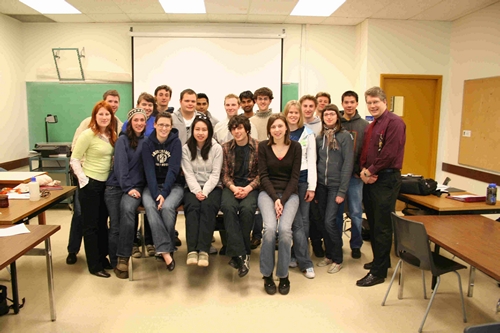
Urban Studies 400,
"The City as an Entertainment Machine," May, 2007.
The producer of this web-page is a card-carrying member of the reality-based community.
Image ©Copyright 2005 Elizabeth Lee
Why I'm glad I [went to university • applied to graduate school • applied for an academic job] when I did, 2008 Edition: "In a recent commentary in the journal Nature, two Cambridge University researchers reported that about a dozen of their colleagues had admitted to regular use of prescription drugs ... to improve their academic performance." Martha Farah, of the Center for Cognitive Neuroscience at Penn, defends the practice. "In academics, whether you're a student or a researcher, there is an element of competition, but it's secondary. The main purpose is to try to learn things, to get experience, to write papers, to do experiments. So in that case if you can do it better because you've got some drug on board, that would on the face of things seem like a plus." Benedict Corey (2008). "Brain Enhancement is Wrong, Right?" New York Times, 9 March, Week in Review, p. 1, 2, quotes from p. 1, 2. Recipe: add steroids to a bowl of the tragedy of the commons, bring to a boil until Boyle's law is apparent. Intensified competition has undermined the genuine purity, the humanity, of so many who wish simply to try to learn things. Nearly every domain of society has been invaded by incessant competition, credentialling, and the replacement of evaluations of potential by bean-counting rankings of demonstrated deliverables. As Cindi Katz has asked, how long before the baby has a curriculum vitae at birth? In such a climate, prescription proliferation promises a (near) future of steroid seminars, urine-test mid-term tests, Adderall-fueled article submissions, and many other kinds of performance-enhanced performances. Yikes.
"Among many, ... the terms 'competition technique' and 'competition mentality' are often used as pejoratives. Even Mr. Cliburn, who is loathe to say anything critical of anyone, admits that he does not like comparisons and would never feel comfortable giving rankings to contestants. 'I couldn't do it,' he said. 'I've never been on a jury. It would be the hardest thing ever for me to do. I'm too understanding of why a person did a passage this way instead of that way.'" Anthony Tommasini (2008). "Cold War, Hot Pianist: Now Add 50 Years." New York Times, March 9, Arts & Leisure, p. 1, 24-25, quote from p. 25.
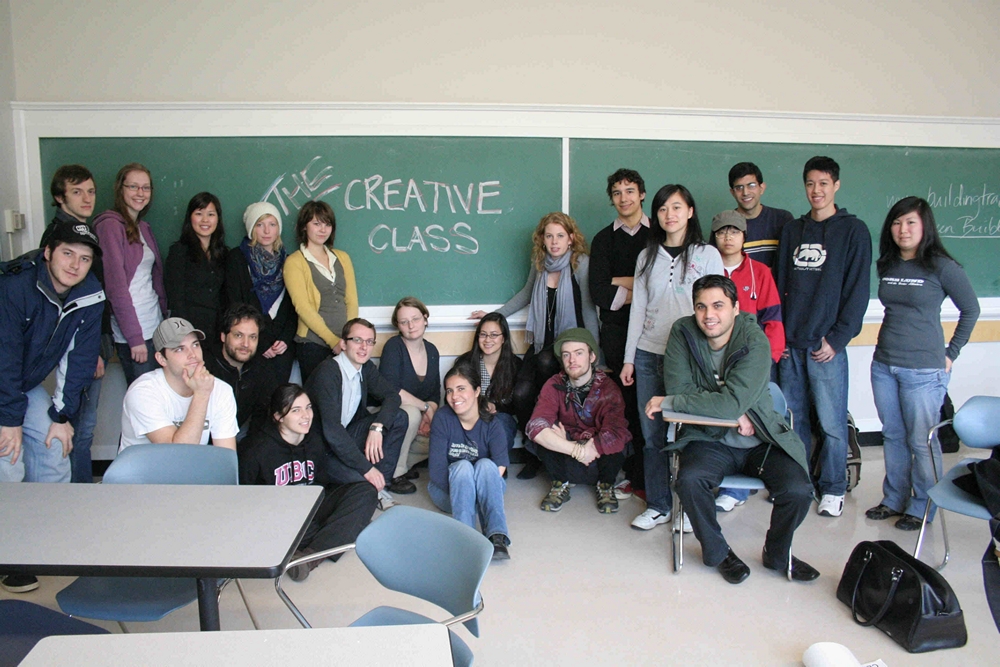
The Creative Class.
After "Struggling with the Creative Class," (Peck, 2005), we emerged from the Floridaze and found our own class consciousness. Urban Studies 400, "The City as an Entertainment Machine," April 2008.
studens quotus
Student Quotes
A Night-Light and Geographical Discovery
Lindsay Young, May, 2009
"...as your typical afraid-of-the-dark child, I requested a night-light for my bedroom. My parents obliged, getting perhaps the largest night-light ever created; they got me a globe. Not only did the globe act as a new learning tool, it was, first and foremost, an item intended to comfort me. As trivial as it may sound, running my hands across the textured Himalayas and Andes, and choosing my favourite countries based on how pretty I though they looked, was a fundamental part of who I am now. Many people I know are less than happy when confronted with a map; they balk, and usually turn it over to me. Excellent.
Maps, atlases, globes, and the like, still provide a sense of comfort to me, but now in different ways. I understand maps, which is part of why I love them. They're universal. They facilitate the flow of people throughout the world, into foreign lands, and back out again. Maps unify this incredibly diverse world. Not only is cartography a transferable language, but maps literally bring people together."
Lindsay Young (2009). Personal Statement, for Admission to Tourism Management Programs. Vancouver: Urban Studies Program, Department of Geography, May 23. Quoted with permission.
Student Publications
Here's my collection of student publications in which I have had some role. In most cases, I would like to think that my role was a positive one, but of course for reliable information you should ask them, not me! Contributions range across the entire spectrum from collaborative research to independent admiration -- all the way from articles in which I have dragged students in as full co-authors, to course papers submitted by undergraduates trying to escape my relentless harassments of, "this is good, you should get it published somewhere...," to papers authored by doctoral students who have tolerated me in a course or on a committee.
Sam Walker (2013). Growing Ideology: Urban Agriculture in Vancouver and Detroit. MA Thesis. Vancouver, BC: Department of Geography, University of British Columbia.
This thesis is an investigation of the urban agriculture movements in Vancouver, British Columbia, and Detroit, Michigan. I use both quantitative and qualitative methods and an urban political ecology theoretical framework to unpack how urban agriculture fits within the foodscapes of these two cities. My quantitative method draws on recent critique of food desert studies, avoiding an epidemiological method that seeks to statistically measure health outcomes in favor of an ecological approach with social inequalities as the primary focus of inquiry. Through the use of cluster analysis, multidimensional scaling, and local indicators of spatial association, I conclude that foodscape composition and the location of urban agriculture is influenced by the housing and land markets, income inequality, and racial segregation. Drawing on interviews conducted in both cities, in my qualitative section I seek to understand how urban agriculture is seen as a sustainable solution to the very different problems faced by these two cities. I argue that urban agriculture has an ambivalent relationship to neoliberalism: it emerged largely as a Polanyian counter-movement to urbanized inequalities, but has more recently been enrolled as a device by the local state through which sustainability planning is seen to enhance economic competitiveness. Finally, I present vignettes of individual farms and gardens that show the political potential of urban agriculture to be closely linked to theories of political change and socionatural metabolic rifts.
Sam Johns (2013). Living the Dream Atop Whistler Mountain: The Malaise of Modernity and Vancouver's Leisure Culture. MA Thesis. Vancouver, BC: Department of Geography, University of British Columbia.
Our modern age is purportedly like a mountain; high and mighty, worthy in stature and significance. Perhaps we live in the Everest era, atop the summit of achievements in science, technology, and innovation. If so, then modernity should be viewed as untroubled progress. Yet Charles Taylor's malaise of modernity presents us with a rather different view. Given the pervasive logics of individualism, instrumental reason, and a loss of freedom, the onward march of modernity should perhaps be met with more resistance. Taylor charges us to recognize such inherent contestation. The case study of a leisure culture in Vancouver, British Columbia, sheds light on this tension. An elite class of young urban professionals is observed to respond to Taylor's malaise by escaping and returning to nature, notably the Coast Mountains. Twenty in-depth interviews were conducted to examine their refusals of the metropolitan auspices of the malaise, manifest in the pursuit of heroism, awe and wonder, and vitality, all of which reify mountain culture. Yet the call and response are far from simple. Rather, a riddle of sorts emerges. Given the logics, technologies, and terrain of escape, the grip of the malaise seems as tight on the mountainside as in the metropolis. Taylor serves as a valuable guide in this fraught terrain. His 'work of retrieval' informs a pursuit of the richer sources feeding this culture. Logics of social atomism, fragmentation, and instrumentalism are examined. In doing so, a critique of radical anthropocentrism is mounted, challenging the young professionals’ attitudes towards fulfillment. Does this quest for meaning negate nature, society, history, tradition, and even God? These questions reveal potential limits to the modern frame, in its individualized, secularized, and subjectivized versions. The mountain emerges as a powerful conceptual image amidst this analysis. In times of clarity and confusion, the permanence and perspective of the mountain are to be treasured. Whilst Leopold's call of 'Thinking like a Mountain' is considered, the limitations of a mountainous group, in the Coast Mountains, atop the 21st Century informational mountain are duly noted. The hope is that Taylor's 'work of retrieval' can, after all, enlarge the frame.
Nicholas Lynch (2013). Altared Places: The Reuse of Urban Churches as Loft Living in the Post-Secular and Post-Industrial City. Ph.D. Thesis. Vancouver, BC: Department of Geography, University of British Columbia.
In recent years, numerous mainline Christian denominations throughout Canada have sold their places of worship in the real estate market in response to changes in religious membership and participation. At the same time a growing demand for creative residential spaces by a group of the new middle class encourages the redevelopment of churches into upscale lofts, a practice connected to but divergent from the post-industrial loft living made popular in cities like New York. In this thesis I explore how the reuse of churches as lofts represents a unique but conflict-laden terrain of private urban redevelopment. With an empirical focus on Toronto, I draw on the literatures of religious change, heritage policy, and gentrification theory to illustrate how ‘redundant’ worship spaces are appropriated and transformed into private domestic spaces of commodified religion and heritage. Rebuilt as ‘cool’ but exclusive places to live, I argue that church lofts are part of a secular embourgeoisement of the central city, a process that increasingly remakes the city as a place of capital reinvestment, middle class colonization and social upgrading. My central method involves semi-structured interviews with individuals from both the supply and demand side of the church loft market. On the supply side, interviews are drawn from faith groups, heritage policy makers, and urban developers. This data provides insight into why and how religious groups divest in their properties; the impacts of heritage policy on the reuse of inner city landscapes; and the practices of developers in producing and selling new terrains of loft living. On the demand side, I interview loft owners to give testimony to their real estate and lifestyle desires and explore how their decisions in the loft market help produce terrains of exclusivity and gentrification. Drawing on comparisons to Montreal and London (UK), my findings show that church reuse in Toronto need not solely focus on private loft development alone. Rather, I conclude that varying systems of ownership supported by multiple stakeholders can create a public future for redundant worship spaces, a practice that could provide much needed community and public space in the inner city.
Elizabeth Lee (2012). Foreign Born Soldiers and the Ambivalent Spaces of Citizenship. Ph.D. Thesis. Vancouver, BC: Department of Geography, University of British Columbia.
Foreign-Born Soldiers and the Ambivalent Spaces of Citizenship examines the interlocking politics of immigration and citizenship, labor and militarism, and race and gender. I explore two cases of militarized citizenship: Filipino recruits in the U.S. military and Nepalese Gurkha soldiers in the British Army. The bulk of the thesis engages the lives of Filipino migrants who enlist in the U.S. military as a collective pathway to American citizenship for themselves and their families. Filipino nationals comprise the highest percentage of foreign-born military recruits, a trend enabled by the fact that U.S. citizenship is not required to serve in the armed forces and promoted by the colonial history of the U.S. in the Philippines. Filipinos are the only foreign-born nationals permitted to enlist in the U.S. Armed Forces without having to immigrate to the United States. Filipinos, in other words, are the exception to the permanent residency requirement necessary to join the U.S. military. Citizenship is, however, granted posthumously to any “alien” or “non-citizen national” whose death occurs on active duty, providing a legal “death dividend” for surviving relatives. I observe how the working lives of these migrants illuminate the new mobility of global (militarized) labor, a form of economic discipline facilitated by the state in the era of flexible accumulation. Over a period of twelve months, I conducted a series of in-depth interviews with Filipino military families in the San Francisco Bay Area. In the cases under study, the families of U.S. military personnel killed in action refused – in political protest – the offer of posthumous citizenship. These testimonies illuminate and juxtapose mundane and spectacular instances of state violence against agents of the state and their next of kin in a way that reveals conflicts inherent to incorporation and resistance internal to enlistment.
Liam McGuire (2012). The Ten Cities of Toronto: Patterns of Socio-Economic Inequality and Polarization Throughout the Toronto Census Metropolitan Area. MA Thesis. Vancouver, BC: Department of Geography, University of British Columbia.
The Greater Toronto Area (G.T.A.), Canada’s largest urban region, is currently facing a strenuous experience of inequality and polarization. In the contexts of social, political, and economic landscapes, the Toronto region is becoming increasingly defined by a spatial divergence of social classes, a divergence that threatens the ability of many citizens to access the resources their wealthier neighbours enjoy. In the context of an increasingly unequal urban landscape, this thesis employs a critical quantitative and theoretical approach to explore the Greater Toronto Area, home to more than six million people. Following an introduction to the issues facing the G.T.A., chapter two explores the mechanics of a capitalist housing market, and examines the effects of a neoliberal urban governance strategy on the city. Chapter three outlines a multidimensional quantitative methodology to explore the presence of social inequality and polarization, whereby chapter four introduces a taxonomy of neighbourhoods, materializing social divides through the domains of housing, citizenship, wealth, and labour. Critical to this examination is the exploration of the gentrifying downtown, the declining inner suburbs, and the rapidly expanding outer suburbs. The fifth chapter more closely examines the relationship between immigration and housing in the G.T.A., mapping and analyzing the relationships between new residents and housing affordability stress. The results deepen an understanding of social inequity in the G.T.A., spatializing divisions between immigrant groups as they navigate the turbulent housing market. Finally, the thesis reflects on the challenges facing Canada’s largest urban region, arguing for new conceptualizations of our urban areas, and new conversations about urban housing strategies. These arguments strive to set a context for new urban governance strategies grounded in an interest of truly just and equal cities for all residents, challenging the existing social divisions that divide our cities today.
Björn Surborg (2011). "World Cities are Just 'Basing Points for Capital': Interacting with the World City from the Global South." Urban Forum, forthcoming, 16pp.
There has been a substantial and continuous critique of the world city concept for several years now. One of the main thrusts this critique is taking is that the world city literature is insensitive to urbanisation processes in the global south and builds its theoretical advances on the empirical examples and perspectives of the global north. This paper traces the origins of world city research before examining the more recent critique of this extensive literature on world cities. The main argument is that the concept of the world city as developed by many prominent writers on the topic is not a recent resurgence of modernisation theory in urban studies, as implicitly submitted by its critics. Instead, it is not only conceptually relevant in the context of third world urbanisation, but provides ample room for critical evaluations of urban development in Africa and the global south more generally.
Andrew Jackson (2011). "A Virtuous Circle: How Transportation Demand Management Transformed UBC, Vancouver." Plan Canada 51(1), 12-19.
In many cities, planners and policy makers are seeking effective policies to reduce "automobile dependence" and the problems associated with this phenomenon. In recent years, many universities and colleges have implemented "transportation demand management" (TDM) programs, which have significantly reduced automobile dependence among staff and students. To demonstrate the potential of TDM, this paper analyzes the implementation of a TDM program at the University of British Columbia (UBC) and documents the subsequent change in land use that this TDM program facilitated. By creating substantial "mode-shift" away from cars and by removing some parking facilities, this TDM program allowed UBC to build eight residential neighbourhoods on its Point Grey campus, which, in turn, encouraged different transportation choices. In doing so, this TDM program reversed the "vicious cycle" that transport planners refer to as "induced travel" or "induced demand." To reveal the "virtuous circle" initiated by UBC's TDM program, this paper reviews the evolution of TDM and documents its effect on campus planning at UBC, Vancouver.
Nicholas Lynch (2011). "'Converting' Space in Toronto: The Adaptive Reuse of the Former Centennial Japanese United Church to the 'Church Lofts.'" Journal for the Society for the Study of Architecture in Canada 36(1), 63-73.
This paper traces the adaptive re-use of the former Centennial Japanese United Church (CJUC) to upscale residential lofts in the city of Toronto. More than 150 years old, this redundant church, now renamed the "Church Lofts," has undergone considerable physical and aesthetic transformations. I highlight these transformations first through a description of the religious and architectural history of the building, beginning as a small Methodist church and later conversion to a larger United church. Then I explore the contemporary renovation of the building into upscale loft residences. I highlight both the architectural and symbolic re-construction of the building in order to demonstrate that the successful convesion of the CJUC requires a concomitant material and aesthetic adaptation to be marketable as a premium loft building in one of Canada's most diverse and competitive real-estate markets.
Thomas M. Thomson (2010). The Death and Life of the Little Mountain Housing Project: BC's First Public Housing Community. MA Thesis. Vancouver: Department of Geography, University of British Columbia.
Opened in 1954, Vancouver’s Little Mountain Housing Project was the first public housing project in BC and among the oldest in Canada. For more than half a century, Little Mountain provided subsidized rental housing for low and moderate income families and seniors. Throughout its years, Little Mountain was at the forefront of housing policy in BC. Little Mountain’s initial development in the 1950s spelled out how the federal-provincial public housing partnership would operate in BC. In the 1970s Little Mountain was the first public housing project in Canada managed by a committee of tenants. And today Little Mountain continues to be on the leading edge of provincial housing policy as it is the first public housing project to be privatized and redeveloped under a new province-wide policy announced in 2007. Redevelopment and privatization have involved the displacement of 194 Little Mountain households and the demolition of all but one of the buildings at Little Mountain. The displacement of the tenants and the near total clearance of the large site are among some of the disturbing similarities between the redevelopment of Little Mountain and the old urban renewal programs of the mid-twentieth century. But unlike urban renewal, the redevelopment of Little Mountain is connected to neoliberal restructuring and the erosion of the welfare state. When Little Mountain is eventually rebuilt, it will feature a mixed-income community that will combine social housing tenants and market homeowners. Redevelopment has been justified, in part, on the basis that social mixing will create more social capital for the low-income families at Little Mountain. But this thesis shows that Little Mountain was already remarkably rich in social capital. In contrast to the stereotype of the ‘troubled housing project’, Little Mountain offered a very supportive, happy, and beautiful living environment. Ironically, displacement has isolated many of the tenants. Through an analysis of the distribution of benefits and losses of redevelopment to various relevant groups, this thesis shows that the Little Mountain tenants are being squeezed out of the benefits of redevelopment while bearing significant losses.
Nicole Foth (2010). "Long-Term Change Around SkyTrain Stations in Vancouver, Canada: A Demographic Shift-Share Analysis." The Geographical Bulletin 51:37-52.
This study examines the long-term demographic implications of the SkyTrain, a light-rail rapid transit system, on surrounding neighborhoods in Vancouver, Canada. Using demographic Census data from 1981 and 2006, shift-share analysis shows the residents characteristics change over time. Results demonstrate that SkyTrain neighborhoods near stations have become physically denser, wealthier and more educated compared to vancouver as a whole. From these results, the article explores the contextual reasons why denser development occurred around the SkyTrain stations and the effect on residential demographics in the area.
Ren Thomas (2010, forthcoming). “Why can’t we get around?” Travelling under constraints in Metro Vancouver." Canadian Journal of Urban Research.19(1), Supplement, 89-110.
In recent years, many researchers have studied the decreasing prevalence of walking and cycling among children and youth. Little research has focussed on young adults, however, and studies of younger age groups tend to ignore public transit ridership even though young people show high public transit use in Canadian cities. How, where, and why do young people travel? This small-scale, exploratory study examined the non-work, non-school travel patterns of youth (17-21) and young adults (22-25) in Metro Vancouver. Focus groups and social mapping revealed several constraints upon young people’s social travel, but also demonstrated participants’ awareness of larger issues around transportation planning (including the high costs of gasoline and the environmental consequences of driving). The research suggests that in large cities with viable public transit systems, young people may delay car ownership, which could have positive implications for urban regions.
Markus Moos (2010, forthcoming). "The Globalization of Urban Housing Markets: Immigration and Changing Housing Demand in Vancouver." Urban Geography 31(issue to be determined).
The effects of the flow of residential capital through immigration on the internal structure of cities and housing markets have become of increasing importance. This paper examines the effects of immigration on Vancouver's residential housing market as the city became increasingly influenced by global processes and the arrival of skilled and wealthy migrants. The changing determinants of housing demand are analysed for recent immigrants and the rest of the population using Statistics Canada data in two time periods. Intra-urban spatial dimensions of the changes in housing demand are examined using tract data. The analysis reveals a de-coupling of local housing from labour markets as recent immigrants' housing consumption became less tied to their local labour market participation. Labour market income measured in national datasets becomes less instructive in explaining housing market outcomes and neighbourhood change if immigrants arrive with established wealth and continue to earn unreported income outside the country.
Noah Quastel (2009, forthcoming). "Political Ecologies of Gentrification." Urban Geography 30(8).
This article explores the possibilities for a political ecology of gentrification. Gentrification research, while firmly rooted in materialist social science, has not yet broadened its interests to consider ecological aspects of, or the role in gentrification of, discourses, social movements, and state policies of the environment. Understanding the political ecologies of gentrification involves recognizing the ways in which material relations and uneven resource consumption, concepts of nature, and the politics of urban environmental management affect gentrification processes. By synthesizing diverse literatures in urban studies, political ecology, urban environmental governance, consumption studies, and gentrification, this study argues that Vancouver, British Columbia represents a well-developed urban crucible for the new political ecologies of gentrification in North America. New developments in Vancouver increasingly contribute to gentrification using languages of sustainability and green consumption in a process of ecological gentrification.
Elvin Wyly, Markus Moos, Daniel Hammel, and Emmanuel Kabahizi (2009). "Cartographies of Race and Class: Mapping the Class-Monopoly Rents of American Subprime Mortgage Capital." International Journal of Urban and Regional Research 33(2), 332-354.
The worst global financial crisis since the Great Depression has drawn worldwide attention to America's subprime mortgage sector and its linkages with predatory exploitation in working-class and racially marginalized communities. During nearly two decades of expansion, agents of subprime capital fought regulation and reform by 1) using the doctrine of risk-based pricing to equate financial innovation with democratized access to capital, 2) appealing to the cultural myths of the 'American Dream' of homeownership, and 3) dismissing well-documented cases of racial discrimination and predatory abuse as anecdotal evidence of rare problems confined to a few lost-cause places in what is otherwise a benevolent free-market landscape. In this article, we challenge these three tactics. Properly adapted and updated, Harvey's (1974) theory of class-monopoly rent allows us to map and interpret the localized, neighborhood exploitations of class and race in several hundred U.S. metropolitan areas as they were woven through Wall Street securitization conduits into global networks of debt and investment. Understanding the structured inequalities of class-monopoly rent is essential for analysis, organizing, and policy responses to the crisis.
Pablo Mendez (2009). "Age-at-Arrival Differences in Homeownership Attainment among Immigrants and their Foreign-Born Offspring in Canada." Population, Space, and Place 15(1), 19-36.
This paper asks whether age at arrival matters when it comes to home-ownership attainment among immigrants, paying particular attention to householders' self-identification as a visible minority. Combining methods that were developed separately in the immigrant housing and the immigrant offspring literatures, this study shows the importance of recognising generational groups based on age at arrival, while also accounting for the interacting effects of current age (or birth cohorts) and arrival cohorts. The paper advocates a (quasi-)longitudinal approach to studying home-ownership attainment among immigrants and their foreign-born offspring. Analysis of data from the Canadian Census reveals that foreign-born householders who immigrated as adults in the 1970s and the 1980s are more likely to be home-owners than their counterparts who immigrated at a younger age when they self-identify as South Asian or White, but not always so when they self-identify as Chinese or as other visible minority. The same bifurcated pattern recurs between householders who immigrated at secondary-school age and those who were younger upon arrival. Age at arrival therefore emerges as a variable of significance to help explain differences in immigrant housing outcomes, and should be taken into account in future studies of immigrant home-ownership attainment.
Elissa Berrill (2009). "Stagflation Shines on the Sunbelt: An Industry Analysis of Deindustrialization and the Growth of the Service Sector." Trail Six: An Undergraduate Journal of Geography 3, 20-29.
The current economic crisis (2008-09) is threatening to cripple U.S. automobile production, jeopardizing the last major manufacturing industry in North America. Current economic decisions made by the U.S. government with respect to industry bailouts are more completely understood by analysing the period of stagflation experienced in the USA between 1973 and 1982. Using industrial sector employment data from the U.S. Department of Labour, I conduct a shift-share analysis on two case study cities, Youngstown, Ohio, and Dallas, Texas, to emphasize how geographical location and economic specialization led to the growth of the service industry in the South at the expense of the manufacturing belt region in the north-eastern USA since the 1970s. Interpreting the effects of this economic shift provides a glance into past U.S. economic change, through which the economic values of the current U.S. government can be better understood.
Björn Surborg (2009). "Is it the 'Development of Underdevelopment' All Over Again? Internet Development in Vietnam." Globalizations 6(2), 225-247.
The reform process doi moi (Engl.: renovation) in Vietnam has brought profound changes for the Vietnamese economy. Most notably the opening of a formerly centrally planned economy to the capitalist world market has made the country more accessible to foreign direct investment and integrated the country more strongly into the capitalist world system. Part of the overall modernisation and global integration strategy in Vietnam is the development of the Internet. However, the Internet in Vietnam is not a ubiquitous and widely available technology, rather it is a piece of infrastructure that is unevenly available across social and regional spaces. Aided by a regulatory environment that presents itself as providing opportunities for all, the Internet provides a business tool for a transnational capitalist class and its local affiliates to access the resources of Vietnam's periphery type economy. The Internet has contributed to a shift in economic control functions away from the state territorial level to a network of dispersed actors. The paper suggests close links between dependency and world-systems theories and Internet research and argues that the theories remain valid in their principal argument, but that the level of analysis needs to be shifted away from the state territorial unit to these dispersed sets of actors.
Andrejs Skaburskis and Markus Moos (2008). "The Redistribution of Residential Property Values in Montreal, Toronto, and Vancouver: Examining Neoclassical and Marxist Views on Changing Investment Patterns." Environment and Planning A 40(4), 905-927.
This study examines the changes in residential property value in Canada’s three largest metropolitan areas by using shift-share and regression analysis with census tract data. The results show that the tracts that increased their share of the metropolitan areas’ real estate value in one decade tend to lose that share during the next decade. After accounting for the effect of new additions, the main transfer of wealth is from the older suburban ring to both the inner city and the new suburbs. The largest variation in the growth of property value is not between the new suburbs and the inner city but across the inner-city census tracts. The shifts and cycles of investment across broad city sectors predicted by neoclassical and Marxist theory are overwhelmed by local factors.
Daniel Hiebert and Pablo Mendez (2008). Settling In: Newcomers in the Canadian Housing Market, 2001-2005. Working Paper No. 08-04. Vancouver: Centre for Research on Immigration and Integration in the Metropolis, Department of Geography, University of British Columbia.
Daniel Hiebert, Pablo Mendez, and Elvin Wyly (2008). The Housing Situation and Needs of Recent Immigrants in the Vancouver Metropolitan Area. Working Paper No. 08-01. Vancouver: Centre for Research on Immigration and Integration in the Metropolis, Department of Geography, University of British Columbia.
Access to adequate, suitable and affordable housing is an essential step in immigrant integration. Immigrants first seek a place to live and then look for language and job training, education for their children, and employment. Housing is also an important indicator of quality of life, affecting health, social interaction, community participation, economic activities, and general wellbeing. This report provides a detailed analysis of the housing situation of immigrants in the Vancouver metropolitan area and complements similar reports on Montréal and Toronto. Drawing on a wealth of new information about the housing situation of immigrants, we examine four themes: the history of immigration in the Vancouver metropolitan area and recent trends in the Vancouver housing market; the housing conditions of immigrants currently living in the metropolitan area, focusing on the intersections between immigration, income, and ethno-cultural origin in the housing market; a detailed analysis of Vancouver residents who are experiencing affordability problems; and the housing circumstances of newcomers six months after landing in Canada, based on the Longitudinal Survey of Immigrants to Canada (LSIC). In the last of these themes we are able to make direct links between immigrant admissions policy and outcomes in the housing market, since LSIC, in contrast to the census, includes information about the class of entry of immigrants.
Elvin Wyly, Markus Moos, Holly Foxcroft, and Emmanuel Kabahizi (2008). "Subprime Mortgage Segmentation in the American Urban System." Tijdschrift voor Economische en Sociale Geografie 99(1), 3-23.
Research and policy debates in the United States have focused on the dramatic growth of mortgage lending in the risky subprime sector, which serves consumers with weaker credit histories, and its concentration in racially and ethnically marginalised communities. Evidence linking the subprime boom to the proliferation of predatory abuses, however, is often dismissed as anecdotal or isolated in a few unique places. In this paper, we undertake a geographical analysis of the central justifications for deregulated risk-based pricing: the proposition that subprime credit serves those who would otherwise be excluded, and reduces exclusionary credit denials. Multivariate analyses of metropolitan- and individual-level processes across the US urban system provide evidence suggesting that subprime mortgage segmentation exacerbates rather than reduces traditional inequalities of denial-based exclusion.
Björn Surborg, Rob VanWynsberghe, and Elvin Wyly (2008). "Mapping the Olympic Growth Machine: Transnational Urbanism and the Growth Machine Diaspora." City 12(3), 341-355.
Theories of growth machines and urban regimes have informed the study of urban political economy for more than three decades, but these theories remain focused on intra-urban processes. Using a case study of the bidding process and the planning of the 2010 Olympic Winter Games in Vancouver, we explore the transnational dimensions of the urban growth machine and explore common aspects between the growth machine and regime theory literature and the literatures on the entrepreneurial city and transnational urban policy transfers. Through its evolving networks with other urban regimes, Vancouver's growth machine provides a ready forum in which local elites can acquire specialized knowledge on new urban entrepreneurial strategies elsewhere. Actors situated in different parts of the local growth machine are establishing various connections with urban regimes in other cities, in what is best understood as a nascent growth machine diaspora. Growth machine and regime theories remain valid in their basic conceptualization and maintain their strength through their adaptability to various contexts, but can be enriched by analyses of policy circuits, travelling theories and learning networks.
Ted Rutland and Alex Aylett (2008). "The Work of Policy: Actor Networks, Governmentality, and Local Action on Climate Change in Portland, Oregon." Environment and Planning D: Society and Space 26(4), 627-646.
To develop and implement public policy requires work. In this paper, we examine some of the work involved in a pathbreaking climate change policy adopted in Portland, Oregon. Seeking to address shortcomings in existing studies of local environmental governance, we focus particular attention on how climate change became a political priority in Portland, how a particular representation of local carbon dioxide emissions was developed in the process of public consultations, and how the local state attempted to achieve its adopted policy objectives by enlisting the self-governing capacities of its residents. To carry out such an analysis, we draw on both actor-network theory (ANT) and governmentality. The first approach offers an understanding of how collective priorities emerge as different actants learn how to move toward their goals by working together, and also suggests how subjects and objects are reshaped by their enrolment in such configurations. The second approach offers a more precise understanding of how the state attempts to achieve its objectives—once they are established—by conducting the conduct of its citizens. Brought together, we argue, ANT and governmentality provide an incisive approach to questions of local environmental governance, and to broader political concerns as well. As each approach addresses well-cited shortcomings of the other, the combined approach developed in this paper could be deployed in many studies that examine the emergence of political priorities and the capacity to achieve them.
Björn Surborg (2008). "On-Line with the People In Line: Internet Development and Flexible Control of the Net in Vietnam." Geoforum 39(1), 344-357.
Information and communication technologies in general and the internet in particular are often praised as a means for enhancing democracy and providing new spaces for the development of an egalitarian civil society, in which all members of society can participate equally. However, there are various possibilities to monitor, manipulate and control cyberspace, of which the internet is an essential part. This paper examines the efforts of the Vietnamese government and the Vietnamese Communist Party to control cyberspace as well as the physical spaces through which the virtual world is accessed. There are attempts to control the internet in a similar fashion as the traditional print and broadcast media. Any such control is neither absolute nor without effect. Instead control is exercised in a highly flexible manner, allowing for some officially unwanted or illegal activity to occur. At the same time authorities can apply internet regulations, if it serves their political objectives as for example strengthening the Party’s official monopoly on political power. The paper traces the development of the internet as well as the regulatory environment surrounding it and analyses the inconsistent enforcement of regulations. The analysis is framed in the theoretical works of Michel Foucault and Jürgen Habermas.
Elvin Wyly, Mona Atia, Elizabeth Lee, and Pablo Mendez (2007). "Race, Gender, and Statistical Representation: Predatory Mortgage Lending and the U.S. Community Reinvestment Movement. Environment and Planning A 39(9), 2139-2166.
American mortgage markets, once arenas of discrimination by exclusion, now operate as venues of segmentation and discrimination by inclusion: credit is widely available, but its terms vary enormously. One market segment involves sophisticated predatory practices in which certain groups of borrowers are targeted for high-cost credit that strips out home equity and worsens the risks of delinquency, default, and foreclosure. Unfortunately, it has become more difficult to measure inequalities of predatory lending: race – ethnicity and gender are ‘disappearing’ from the main public data source used to study, organize, and mobilize on issues of lending inequalities. In this paper, we present a mixed-methods case study of statistical representation of homeowners and homebuyers marginalized by race, ethnicity, and gender. A theoretical examination of official data-collection practices is followed by a discussion of alternative meanings of racial – ethnic and gender nondisclosure. Interviews with a sample of homeowners and homebuyers in the Washington, DC, area reveal some respondent ambivalence about the details of data-collection practices, but provide no consistent support for the idea that nonreporting is solely a matter of individual choice. Econometric analyses indicate that nondisclosure is driven primarily by lending-industry practices, with the strongest disparate impacts in African-American suburbs. Predatory lending is producing ambivalent spaces of racial – ethnic and gender invisibility, requiring new strategies in the reinvestment movement.
Ted Rutland and Sean O'Hagan (2007). "The Growing Localness of the Canadian City, or, On the Continued (Ir)relevance of Economic Base Theory." Local Economy 22(2), 163-185.
The past 50 years have brought massive changes in the patterns of economic activity around the world. Not only has global trade increased, but, precisely because of this, many scholars suggest that local (and regional) networks of production and exchange have become more prevalent and important. The nature of local economic development has, as a result, changed quite substantially. And yet theoretical approaches to it largely have not. Fifty years after Douglass North introduced economic base theory - asserting that economies grow only through increased exports - it remains the familiar refrain, if not the basis, of local economic development theory. We think it is about time to reassess the merits of base theory as an approach to, and explanation of, local economic development. Accordingly, in this article, we review briefly North's argument for base theory and the debate it stirred up early on. Then we present two evaluations of its current relevance. The first is theoretical: we consider whether changes in the patterns of economic activity in the global north, including the emergence of local/regional networks of production and exchange and the growth of consumer services, have made it possible to achieve economic growth without increasing exports. The second is empirical: using the minimum requirements method, we examine whether the economies of Canada's cities have become more locally oriented and, if so, whether they have grown. Both evaluations indicate that economic development is indeed possible through increased local activity (although exports remain important). We conclude that it is time to consider more nuanced models of local economic development that accommodate the multiple ways in which development can be achieved.
Mitchell Gray and Elvin Wyly (2007). "The Terror City Hypothesis." In Derek Gregory and Allan Pred, eds., Violent Geographies: Fear, Terror, and Political Violence. London and New York: Routledge, 329-348.
Markus Moos and Andrejs Skaburskis (2007). "The Characteristics and Location of Home Workers in Montreal, Toronto, and Vancouver." Urban Studies 44(9), 1781-1808.
This study analyses the distribution of home workers across the three largest urban regions in Canada and shows how they differ across sex of home worker, household type, income level, occupation and industry. The highest proportion of home workers is in art, culture and recreation occupations followed by management, the field dominated by men. Women home workers make the financial, secretarial and administrative occupations the third-largest group of home workers. The spatial distribution of home workers follows a sectoral form. While the characteristics of inner-city and suburban home workers differ, the differences are the same as for commuters. Rather than creating a completely new locational pattern, home work appears to reinforce existing urban forces of centralisation by professionals and continued decentralisation by the middle classes and those seeking larger estates, such as those in management occupations. The study suggests that the increasing trend towards home work is not dispersing cities, but allows greater locational flexibility within already-existing urban spatial patterns.
Björn Surborg (2007). "Reclaim the City! A Review of the Special Session at the 2007 Association of American Geographers' Annual Meeting." City 11(3), 422-427.
Jared Sexton and Elizabeth Lee (2006). "Figuring the Prison: Prerequisites of Torture at Abu Ghraib." Antipode 38(5), 1005-1022.
This article presents a critique of prevailing left-of-center journalism and academic scholarship on the revelation of torture of Iraqi prisoners of war by United States military personnel at Abu Ghraib in the spring of 2004. We argue that the resulting discourse suffers from a certain critical bankruptcy in its failure to think about the nature of imprisonment as such. This failure is an effect of two procedures: (1) a narrowing of the field of inquiry that relies on the metonymic reduction of imprisonment through and as the practices of torture, and (2) a reification of the prison that both relies upon and displaces the racialization of imprisonment as an institution of black spatial containment and social control. In response, we call for a renewed understanding of and appreciation for the singularity of racial slavery and its afterlife in future research on carceral formations in and beyond the US.
Markus Moos, Jason Whitfield, Laura C. Johnson, and Jean Andrey (2006). "Does Design Matter? The Ecological Footprint as a Planning Tool at the Local Level." Journal of Urban Design 11(2), 195-224.
This paper provides a comparative environmental analysis of three subdivision designs for the same site: an ecovillage, a new-urbanist design and an up-scale estate subdivision. The comparison is based on ecological footprints (EF). Based on built form alone, the higher-density subdivisions resulted in lower EF. Consumption data were limited to the ecovillage, since this is the actual use of the study site, but comparisons were made with regional US averages. The study suggests that consumption contributes more to the overall footprint than built form. Qualitative information was used to explore how consumption is influenced by urban design and self-selection. Despite the challenges associated with data collection and conversion, it is argued that EF has utility for planners and urban designers because it enables assessment of built form from an environmental consumption point of view.
Markus Moos, Jean Andrey, and Laura C. Johnson (2006). "The Sustainability of Telework: An Ecological-Footprinting Approach." Sustainability: Science, Practice, and Policy 2(1), 3-14.
This paper demonstrates the importance of a comprehensive framework to assess how telework affects sustainability. Sustainability-policy evaluation rarely considers substitution effects despite broad recognition that overall lifestyles must be analyzed to gauge how policy-induced behavioral changes translate into net environmental impact. Case-study data indicate that telework has far-reaching, complex, and varied effects on lifestyle practices, with potentially important environmental implications. Because adjustments occur across numerous consumption categories, the assessment of telework’s environmental dimensions must move beyond single-issue studies and single-dataset analysis. Ecological-footprint analysis, in combination with qualitative data, can suggest solutions to sustainability problems.
Björn Surborg (2006). "Advanced Services, the New Economy, and the Built Environment in Hanoi." Cities 23(4), 239-249.
Much of Vietnam’s recent economic growth is based on the industrial sector as well as service industries. This paper briefly analyses the overall economic development of Vietnam since the introduction of the reform process doi moi (renovation) in 1986 and the position of the capital Hanoi in the national and regional economy. The paper also examines clusters of advanced services in the city of Hanoi and explores the development of a small New Economy sector by analysing the locations of software development companies in the city. In addition to the Ancient Quarter, the French Colonial Quarter and the Ba Dinh Area, which have long been identified as distinct areas of administrative and commercial activity in the city of Hanoi, a number of areas away from the city centre could be identified as distinct zones through location analysis and landscape interpretation. Location decisions by the service sector seem to be highly influenced by the built environment and character of an area as well as – of course – property prices, but current planning paradigms are not suited to respond to these developments adequately. Planning still focuses on large scale projects rather than smaller local investments.
Katherine McCallum, Amy Spencer, and Elvin Wyly (2005). "The City as an Image-Creation Machine: A Critical Analysis of Vancouver's Olympic Bid." Yearbook of the Association of Pacific Coast Geographers 67, 24-46.
The strategic mobilization of images, visual metaphors, and other forms of graphical rhetoric has always been central in place promotion. Images of place have assumed even greater importance, however, with the rise of locational tournaments of cities bidding for the "right" to host high-stakes transnational spectacles. In this paper, we adapt Harvey Molotch's pioneering theory of the urban growth machine to illuminate the contemporary enterprise of city bids for the Olympic Games. Taking Vancouver's successful bid for the 2010 Winter Games as a case study, we use a visual methodology framework to analyze the manifest (explicit, surface) and latent (implicit, subtle) visual narrative strategies used to craft a carefully considered representation of the city. Our analysis of the official Bid Questionnaire and the video presentation to the International Olympic Committee documents the sophisticated process by which a city is constructed to embody pristine urban nature, multicultural social harmony, and vibrant local cultures of sport in keeping with the spirit of Olympism. Whether imagined cities like this are effective is irrelevant: cities understand that half of their advertising budget is wasted (they just don't know which half). The expanding symbolic economies of tourism, conventions, and hallmark events require that urban growth machines develop and operate a full suite of image creation machines, each attuned to the real and perceived desires of an elusive transnational audience in a perpetual movable feast of locational consumption.
Mitchell Gray (2003). "Urban Surveillance and Panopticism: Will We Recognize the Facial Recognition Society?" Surveillance and Society 1(3), 314-330.
This paper explores the implementation of facial recognition surveillance mechanisms as a reaction to perceptions of insecurity in urban spaces. Facial recognition systems are part of an attempt to reduce insecurity through knowledge and vision, but, paradoxically, their use may add to insecurity by transforming society in unanticipated directions. Facial recognition promises to bring the disciplinary power of panoptic surveillance envisioned by Bentham -- and then examined by Foucault -- into the contemporary urban environment. The potential of facial recognition systems -- the seamless integration of linked databases of human images and the automated digital recollections of the past -- will necessarily alter societal conceptions of privacy as well as the dynamics of individual and group interactions in public space. More strikingly, psychological theory linked to facial recognition technology holds the potential to breach a final frontier of surveillance, enabling attempts to read the minds of those under its gaze by analyzing the flickers of involuntary microexpressions that cross their faces and betray their emotions.
Julie Silva and Elvin Wyly (2001). "Between Africa and the Abyss: Globalization, Media, and the Invisibility of a Continent." The Geographical Bulletin 43(1), 36-46.
Mass communication, perception, and mental maps are pervasive themes in human geography. Yet the role of globalization on our collective mental maps remains poorly understood, raising critical questions of theory and policy as flows of capital, people, and ideas continue to blur the boundaries between local and international events. This paper analyzes these themes in the context of sub-Saharan Africa, focusing specifically on the civil war in Sierra Leone. The nature of armed conflict in Africa has evolved considerably in recent decades, and the globalization of Western media has altered the way the region has been portrayed. As publishers, editors, and journalists search the globe for material to fill the continuous, 24-hour news cycle, Africa has been portrayed as an arena of incessant crisis and irrational violence -- even as coverage has remained selective and partial. To document the paradox of this narrow global outlook, we present a content analysis of the New York Times' coverage of the civil war in Sierra Leone. We suggest that human rights abuses in African wars demand a clearly-articulated, theoretically-grounded set of principles for media accountability in a world of globalized information flows.
Keith Brown and Elvin Wyly (2000). "A New Gentrification? A Case Study of the Russification of Brighton Beach, New York." The Geographical Bulletin 42(2), 94-105.
Gentrification is often equated with the residential and consumption preferences of young, white, native-born professionals. The link between gentrification and "yuppies," however, does not seem adequate to capture the complexity of trends currently underway in many city neighborhoods. In this paper, census data and fieldwork are utilized to develop a case study of Russian immigration and neighborhood revitalization in Brighton Beach, New York City. "Russification" has revitalized housing demand and retail activity by altering the class composition of the neighborhood, while also increasing inequality and inducing displacement similar to that observed in other gentrifying districts. Nevertheless, important cultural and policy-related factors distinguish immigrant-driven neighborhood change from more conventional forms of gentrification.
Alumni Urbanus
Press clippings and other updates from students who've taken urban geography or urban studies classes with me in previous years. If you've ever taken a class with me, I'd be grateful if you could send any updates, publications, or other items you'd like to share with the next generation of students.
- Douglas Haddow (2009). "Advertising Tries to Sell Itself." The Guardian, 3 November. Douglas took The City as an Entertainment Machine in the spring of 2006, and now writes for the Guardian and other publications.
- Richard Warnica (2009). "Arena Could Leave Poor Out in Cold, Advocates Say." Edmonton Journal, September 4. Richard took Geography 531, Seminar in Urban Systems, several years ago, and now covers urban issues for the Edmonton Journal.
- Amanda Stutt (2008). "Fighting Foreclosure: Subprime Borrowers Battle (and Beat) Lenders in Court." The Village Voice, September 3. Amanda took The City as an Entertainment Machine in the spring of 2008, and a few months later made her way to New York for an internship at the Voice; she also did extensive research assistance for this analysis of the role of Andrew Cuomo in the U.S. subprime lending crisis.
"God is the Absence of Gentrification"
[Written about, not by...] Holly Foxcroft, February 2007, December 2008
Teaching can indeed inspire some wonderful fieldwork. A few years ago, Holly Foxcroft took our Cities course, and at one point in the discussion of gentrification I mentioned the creative protest tactics of folks like Reverend Billy and the Church of Stop Shopping. Reverend Billy has been working against the rampant commodification of urban neighborhoods for quite some time. In subsequent directed studies, Holly subsequently dove into some very serious archival and legal research that built the foundation for "American Home" and "Subprime Mortgage Segmentation in the American Urban System," and she also led a careful analysis of the legal and political struggles of Eliot Spitzer chronicled in "Racial Inequality, Data Politics, and Federalism." We never had the time or the access that Brooke Masters did, but Holly nevertheless mastered the finer points of defining regulatory visitation as codified in the National Banking Act of 1877, before having a Spitzer Spritzer. (Sadly, Spitzer couldn't control his spitzer, so the ubiquitous scandal-industrial complex eventually caught up with him and destroyed his efforts to fight Wall Street crime: in March, 2008, Spitzer was revealed as "Client 9" of a Manhattan prostitution ring, and days later he resigned as Governor of New York.)
But Holly also enjoyed a bit of Irreverence with the Rev in fieldwork in New York City. In late February, 2007, Holly told me she had a chance to go to New York: "I'm leaving tomorrow. Quick, what should I see?" Normal folks might mention the standard menu of tourist infestation zones, but I absentmindedly wondered, "Gee, I wonder if Reverend Billy has anything planned." Did I say that out loud? Sure enough, Holly caught up with the pastor of peace and his congregation of creativity in the East Village. Read with me, Chapter Six, Verses 121 to 123 of the Good Book.
"Can we say this? Whatever God du jour you are hanging with, don't go shopping. God wouldn't be in a chain store, I don't think. In fact, let's just say that GOD IS THE ABSENCE OF GENTRIFICATION. Let's add this to our beliefs next week. Someone give me an amen. Because really has to be interesting. Or let's make it rhyme for effect: God gotta be Odd.
"Today let us ask these questions: How do we retake our life? How do we take back our neighborhoods? Let's talk practical politics. How do we revalue (or even notice) our commonest gestures and exclamations, remember our personal and public memories? So much of resisting transnational corporations is remembering things that we've been told to forget. What story do I have that isn't a part of a product's language? When my neighborhood's working, those are the stories that come up."
"The revolution is just a neighborhood. Three talkers on a corner. Amen."
Bill Talen (2003). "The Revolution is My Hot Neighborhood." Chapter Six in What Should I Do if Reverend Billy is in My Store? New York: The New Press, quotes from p. 121, 122, 123. See also Constance L. Hays (2003). "Preaching to Save Shoppers from 'Evil' of Consumerism." New York Times, January 1, C1, C2, and Reverend Billy and the Church of Stop Shopping (2004). "Reverend Billy and the Stop Shopping Gospel Choir," and "The Sixteen Minute Preacher-Feature." New York: Tomato / The EGGE Company, Limited.
Reverend Billy's approach is, it would seem, not the only fusion of televangelism and the gospel of gentrification resistance. Lewis Black and several collaborators wrote and performed a play in 1981, inspired by Jimmy Swaggart before his prostitute-scandal "I have sinned!" attempt at media redemption. Lewis and Mark Linn-Baker call for all of us sinners to be reborn into comedy, into the Church of the Smiling Christ and the Holy Joke. In the revival tent, Lew and Mark preach with gusto: "Now, you probably came here this evening with a little trepidation in your hearts. ... You worried that we would shriek at you, 'Shame, shame' for trying to make a lot of money. For using that small nest egg to play the market. Not tonight, Brothers and Sisters, not tonight, because we want you to be free of guilt and full of laughter. Goddammit, go out there. Make it hand over fist, any way you can! If you've got to screw somebody -- screw them to the wall! So your building is going co-op. Fine. Make that deal and kick out the four black families and the edlerly white folk, and turn that old building into a nice piece of real estate. Rake it in!"
Lewis Black (2008). Me of Little Faith. New York: Riverhead Books, quote from p. 208.
*
Update, December 2008: Holly's Once in a Lifetime Opportunity!
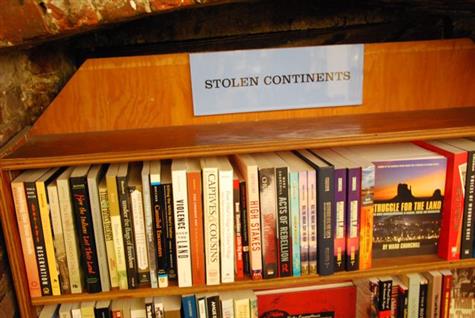
Above: Melissa Fong took my graduate seminar a few years ago. She patiently tried to teach me, then she went off to find the real, genuine professor.
"I was in New York for the Left Forum and, of course,
I could not pass up the chance to meet David Harvey!
... we ended up at a pub and talked about his activist-past!"
Below: "The East Village. I think it's supposed to be 'artistic-political.' They have rotating sayings on the chairs everytime I go."
Images ©Copyright 2009 Melissa Fong
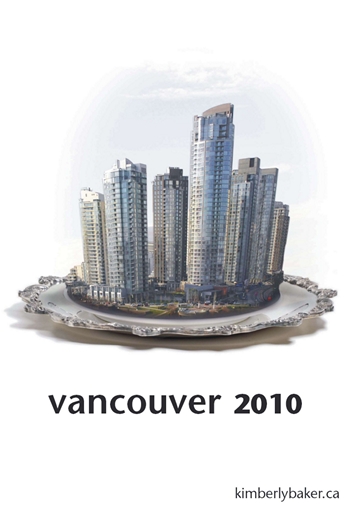
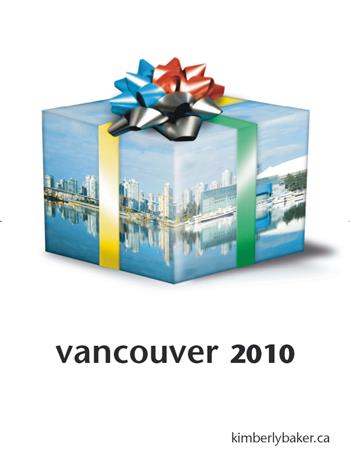
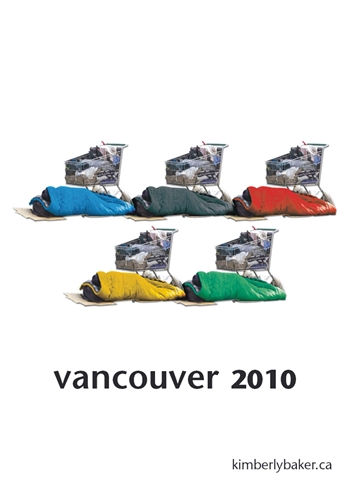
Olympic Artography
Kimberly Baker took Urban Studies 400, "The City as an Entertainment Machine," in the Spring of 2007. Part of her work in that seminar was devoted to her growing interest in "Artography," an art and craft which has become her profession. "The discipline of Artography explores the ways visual arts and pedagogy can integrate arts-based research, art criticism, and relational and ethical inquiry." Kimberly Baker (2009). "About the Artist." World Wide Web Page, "Kimberly Baker," at http://kimberlybaker.ca, last accessed September 20. Kimberly's work in the Urban Studies seminar was devoted to a critical analysis of how the bid and planning phases for Vancouver's hosting of the 2010 Winter Olympics was transforming the city. The city is offered as a consumable product to the demanding global audiences of (potential) visitors and investors, altering the visual and material means by which key features of the urban environment are highlighted, interpreted, or hidden.
It should come as no surprise that Kimberly's artography has collided with the ever-aggressive copyright policing mechanisms of Olympic Organizing Committees. For further information, see some of the press coverage highlighted at Kimberly's web site.
The three images below are copyright ©2007 Kimberly Baker, all rights reserved; posted here with permission.
"I first heard about Canada's new Bill C-47 as I was printing off my series of Transit Shelter posters for the Emily Carr Institute 2007 graduation exhibition. My intention for this body of work is to create a visual narrative that encourages and engages public dialogue concerning the current issues of the Vancouver 2010 Olympics, such as homelessness, the environment and the representation of place as a consumable commodity. As they were running off the printer the technician said to me, 'You know that these are illegal?'
I replied that I had been very careful of the copyright restrictions, I had used a different Pentium color and font for the text, so I wasn't infringing upon any copyright laws.
'What I mean is VANOC has copyrighted the numbers 2010.'
At that moment I was completely floored. 'How can you copyright a number?"
Kimberly Baker (2007). "The Art of Protest." Unpublished manuscript, available at Kimberly Baker, http://kimberlybaker.ca, last accessed September 20, 2009.
Note: the people you know and the things you read may very well lead to scrutiny. In the anxious insecure homeland of Canada's preparation for the 2010 Winter Olympics, knowing academic trouble-makers apparently qualifies as sufficient security risk to warrant visits from VanOC's Integrated Security Unit. See CBC(2009). "Olympic Security Follows Protester's Friend." October 6. Vancouver and Ottawa: Canadian Broadcast Corporation; and
if you're inclined to risk guilt by reading association, read Christopher A. Shaw (2008). Five-Ring Circus: Myths and Realities of the Olympic Games. Gabriola Island, BC: New Society Publishers.
Update: February 23, 2010, amidst the heart-warming hype and global-warming-melting heat of the Games, Kimberly Baker offers this:
"Hello All,
Freedom of Expression is one of our most cherished values of Canadian culture. I am writing to you to let you know that this week I have posted 600 of my vancouver2010 posters throughout the city streets. My intention is to engage the public about the impacts of the Olympics upon our city. I don't know long they'll be up for before they are taken down, so for your reference I have attached some images. Also, I am giving out my Olympic art for FREE! All people need to do is email me at info@kimberlybaker.ca and I will send them a pdf of their requested image.
Sincerely,
Kimberly Baker, Artographer"
Cartography copyright ©2009 Fred Sham.
"The decent docent doesn't doze
He teaches standing on his toes
His students dassn't doze and does
And that's what teaching is and was."
David McCord (1945), What Cheer, quoted in John Bartlett (1968). Familiar Quotations. London: MacMillan, p. 1040.
Students
This page is a brag sheet -- but not for me. It's a celebration of the creativity, contributions, and achievements of the many students who have been sufficiently kind and patient to teach me. If you're looking for information on one of the classes I teach, go here.
"Non est ulla studorium satietas."
There is no satiety in study.
Erasmus, Colloqiua, quoted in Sir Gurney Benham (1948). Benham's Book of Quotations, Proverbs, and Household Words. London: George G. Harrap and Company, Ltd., quote from p. 644.
Markus Moos (2010, forthcoming). "The Globalization of Urban Housing Markets: Immigration and Changing Housing Demand in Vancouver." Urban Geography 31.
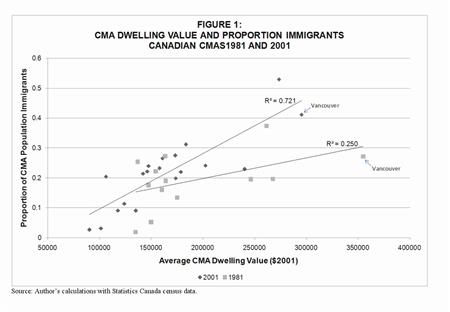
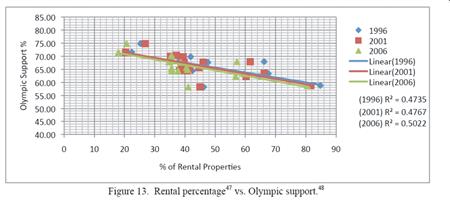
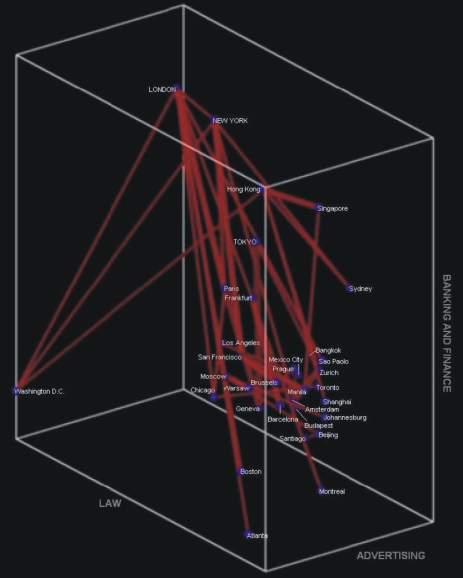
World cities in the space of producer-services history and evolution. Each city is plotted in a space defined by the number of times prominent global firms mention the city in their official histories of incorporation, growth, and mergers and acquisition.
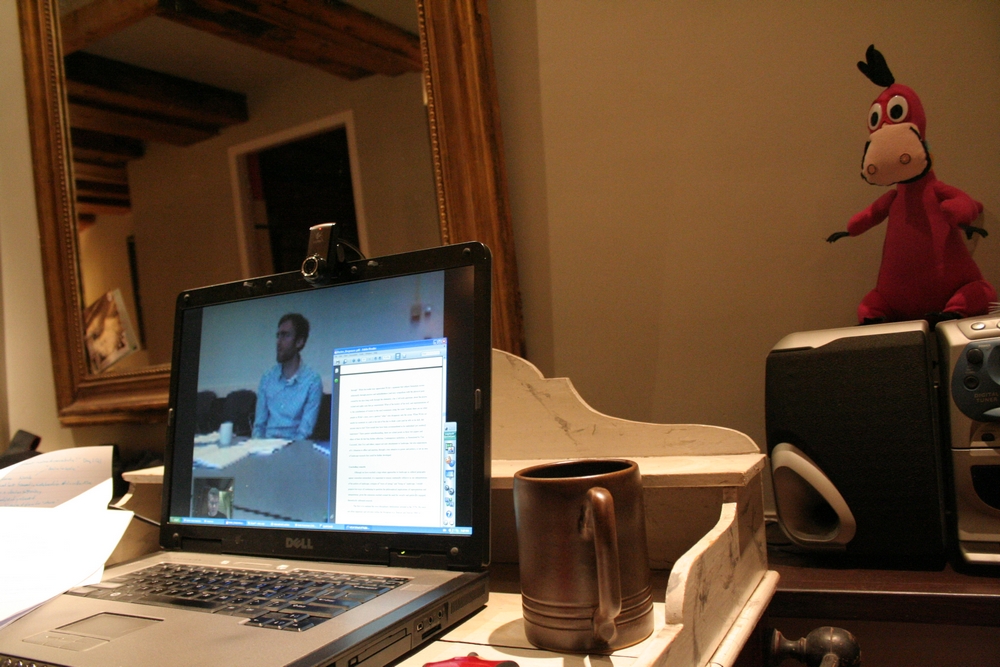
Skype™Scholarship? For at least a century, "the invisible college" has been a familiar phrase denoting the imperative that genuine scholarship and pure inquiry must be unconstrained by borders, boundaries, categories, or any other arbitrary restriction on the search for truth. Today, the invisible college is under assault by a variety of forces seeking to commodify knowledge and to manufacture consent, but there are encouraging possibilities to transcend the borders and boundaries if we can find time in our schedules and coordinate the time zones. December, 2009: comprehensive Ph.D. oral examination for Lachlan Barber, UBC Department of Geography, from Prinsengracht, Amsterdam, via Skype. I'm on research sabbatical, with lots of travel, reading, writing, meeting new colleagues, and many other adventures; fortunately, though, I was able to take out two hours one evening to meet with Lachlan, David Ley, and Abidin Kusno for a wonderful discussion. Dino asked really tough questions about the Jurassic.
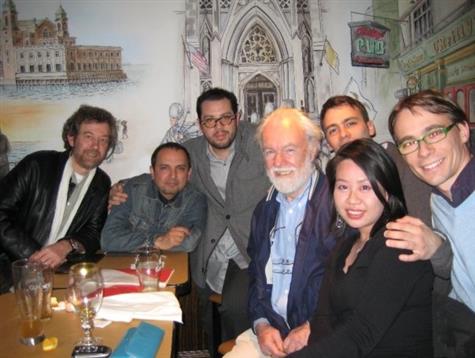

In Case You Wondered Where They Went...
or,
Why Radical Geography Matters
City Lights Bookstore, San Francisco, CA, August, 2009
Image ©Copyright 2009 Elizabeth Lee
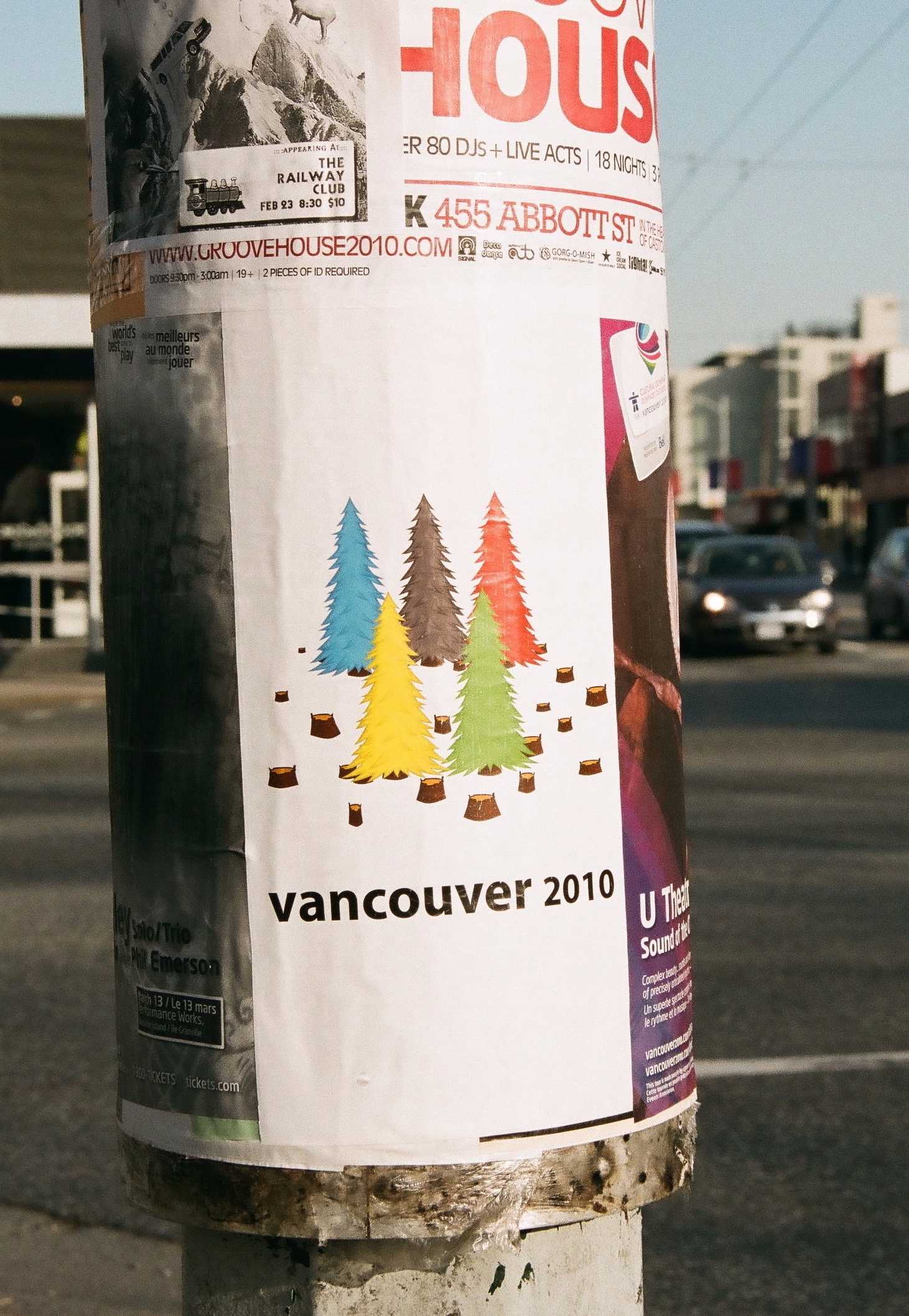

Images ©Copyright 2010 Kimberly Baker
From left, back: Sara Jackson, Bjoern Surborg; middle: Jean McKendry, Liz Lee, Pablo Mendez, Gina Wang; front: Lachlan Barber, Kristin Olson, and Kathy Sherrell.
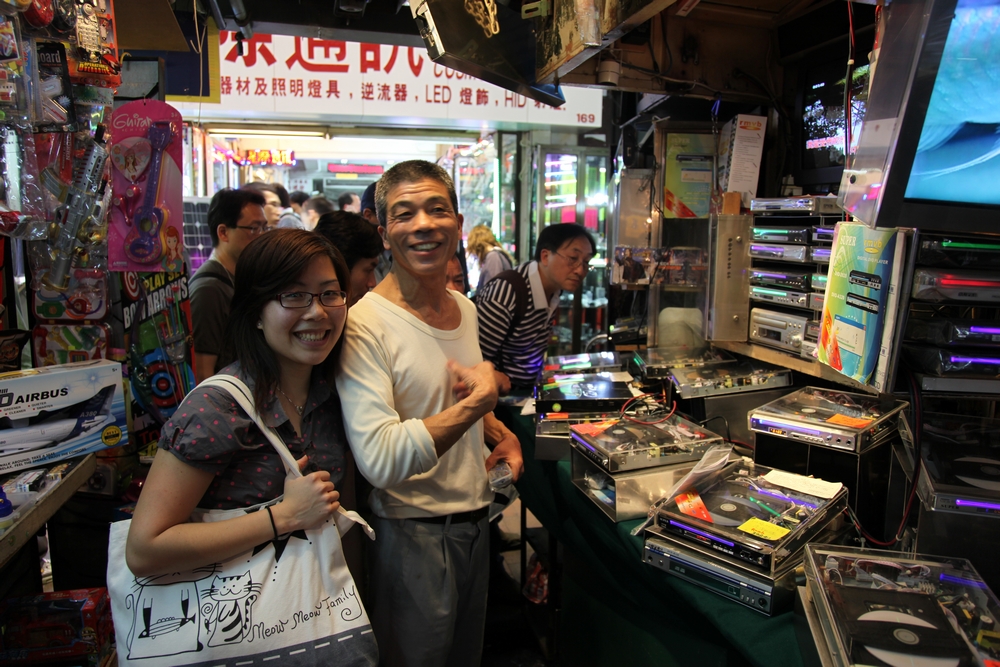
Below: Sandy Chan with her father, in Sham Shui Po, Hong Kong, February 2010. Sandy took Urban Studies 400 in the Spring of 2005, and subsequently earned a Master's in Planning from the University of Hong Kong. She now works in the Hong Kong Planning Department. "Power over the landscape has always determined what will be seen or not seen, who will occupy certain spaces, and what or who will be relegated to the margins. The formation of landscapes has linked economic and cultural power in framing an urban vision desirable for a specific use. The city is seen as an 'entertainment machine' that relies on the symbolic economy," and the localized acceleration of retail sales "is nothing less than the transformation of an industrial civilization based on the creation of concrete goods into a society selling abstractions (Clark, 2004). Under this condition, the cultural power to frame a vision does not just express economic power; it is presumed to create economic power (Sanders, 1996). Architects are asked to increase the economic value of space, to make that space secure, and to provide a coherent image of life in that space (Zukin, 1995)." Sandy Chan (2005). The Manipulation of Urban Image: Strategies for City Revitalization. Final paper for Urban Studies 400, April 26. Vancouver, BC: Urban Studies Program, University of British Columbia, quote from p. 8.

Above: Ted Kilian, in the Mid-Levels, Hong Kong, February 2010 (Elvin Wyly). Ted wasn't "my" student -- and in any event, we should always be suspicious whenever such hierarchical possessives enter the scholarly discourse. But he was certainly my teacher! I had the privilege of serving on Ted's doctoral qualifying examination and dissertation committee at Rutgers University in the 1990s. For one of my questions, I borrowed an approach sometimes used by Roger Miller, at the University of Minnesota. Roger would look through your reading list for about five or six of the most famous figures, and then he'd write a narrative of a particular scenario that would put them all in the same room to debate a particular issue. Susan Fainstein and Karl Marx and Michel Foucault and Karl Polanyi and Milton Friedman, for instance, might all find themselves in the same room, and Roger's question would say, "Write a transcript of the conversation." So I tried this on Ted. Ted's essay was brilliant. He got right to the heart of some of the key urban and economic issues that his examinations were designed to illuminate, and he did it with charm. I can't remember all of the names of those whose mouths he had to stuff with various words. But I do remember that Marx was one of them. And Ted's transcript had Marx introducing himself with something like, "Well, I'm glad to be here to speak with you, because, well ... I'm dead, and it's nice to be back. And I'm grateful for the generous support of a Dead Scholars Grant for financing my travel here." I just about fell out of my chair with laughter when I read that one. There was one other figure that Ted wasn't quite so confident on -- reading lists are often ambitious and unrealistic promises that are sometimes impossible to keep, aren't they? Was it Milton Friedman, or was it Brian Berry? To Ted's credit, he did the best he could. His transcript and narrative of the conversation had the guy nodding off to sleep in the corner, only to wake from his slumber from time to time to throw in a disruptive attack into the ongoing conversation.
Ted's doctoral work focused on public and private space in the dramatic post-1989 national and urban transformations in Eastern Europe. Ted also authored a landmark book chapter:
Ted Kilian (1998). "Public and Private, Power and Space." In Andrew Light and Jonathan M. Smith, eds., Philosophy and Geography II: The Production of Public Space. Lanham, MD: Rowman & Littlefiled, pp. 115-134.
Ted's chapter emphasized the mutual constitution of public and private as categories through which to understand space and spatial relations, and it was subsequently cited by influential reviews and other articles in Cultural Geographies, Political Geography, Environment and Planning A, Urban Geography, the Journal of Early Modern History, and at least a dozen other books and journals.
While writing his doctoral thesis, Ted proposed, obtained approval for, designed and delivered a course on multimedia geographies. Keep in mind, this was way back in the dark ages of the 1990s, with Netscape and dial-up, before anybody had heard of "Web 2.0." The students absolutely loved the course. Ted subsequently accepted a position at Sapient, a strategic research and marketing company with a motto emphasizing "The Business of Transformation."
*
I'm inspired by the next generation, and also the previous one. Not long after I wrote the tidbit above about Ted's comprehensive exams inspired by an approach I learned from Roger Miller, I was heartbroken to learn that we had lost Roger. See this:

Above: Manu Kabahizi, at the Ivanhoe on Main, August 2010 (Elvin Wyly). Manu played a central role in our lending research. He helped build the literature survey of recent advances in cluster analysis, a key methodological component of our analysis of the intricate geographies created by predatory credit practices in the great American housing boom of 2002-2007. He also kept a close eye on Congressional hearings and regulatory proceedings in the struggle to update the disclosure systems that help us monitor evolving credit market conditions. For a small sample of the research made possible by Manu's work, see Elvin Wyly, Markus Moos, Daniel Hammel, and Emmanuel Kabahizi (2009). "Cartographies of Race and Class: Mapping the Class-Monopoly Rents of American Subprime Mortgage Capital." International Journal of Urban and Regional Research 33(2), 332-354. After completing his degree at UBC, Manu returned to Rwanda and launched a start-up company specializing in business-process development and information arbitrage -- helping small- and mid-size firms to enhance the speed and efficiency of their sourcing and logistics functions.
Update from Manu, December 2010: "The UN approved the attached report, which I coauthored for them. ... I thought a lot about your lectures, writings, and conversations we shared while writing this report. The subject is essentially democratization of market data in agriculture. ... so rare does one get to flirt with policy ...!" See Clement Uwajeneza and Emmanuel Kabahizi (2010). Development of a Framework for the Strengthening of Market Information Systems in Rwanda. Geneva and New York: United Nations / FAO.
Thank you, Manu -- I always learned more from you than you from me!
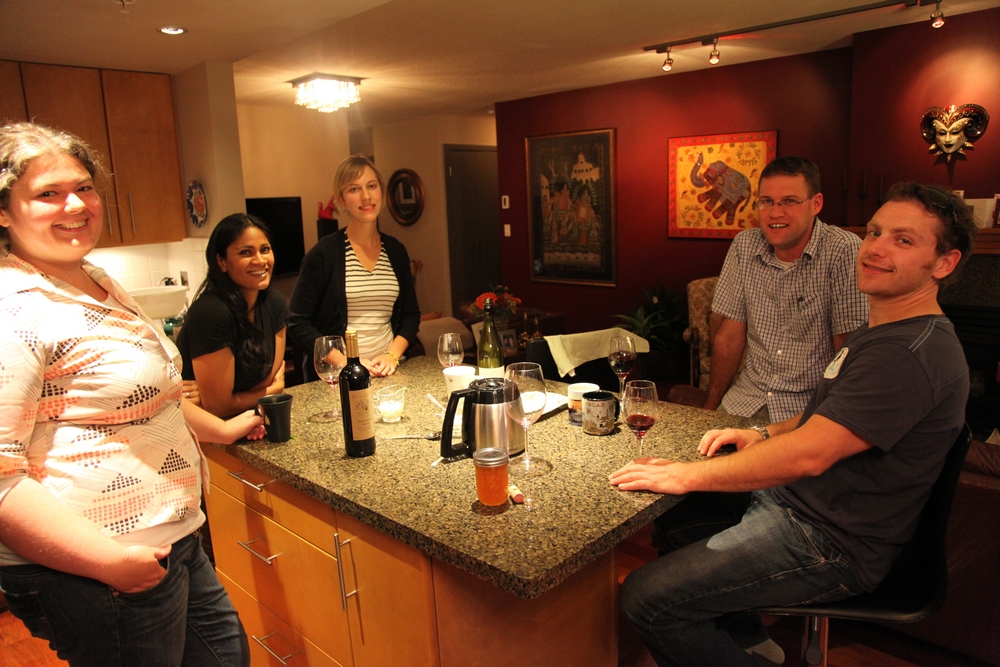
From left: Sage Ponder, Ren Thomas, Emily Rosenman, Bjoern Surborg, and Nicholas Lynch, Vancouver, September 2010.
Geography and a New Urbanism
Polly Ng, August, 2009
"When I tell people that I majored in Human Geography, their response is usually, 'what's that?' Some people will try to take a stab at inferring what it is by its name. My favourite is when people hesitantly ask whether I spent four years studying how to map the body.
The problem was, I didn't really know how to describe Human Geography either. I was innately drawn to the powerful language and intriguing discourses, yet I was always at a loss as to how to condense this instinctual understanding into a one-liner that I could serve at cocktail parties. I even consulted The Dictionary of Human Geography in the GIC, which described the titular subject as 'viewing the world through time and space,' but found that its definition often drew even blanker looks.
It took me several years of conversations to come to the realization that geography is a way of making sense of the world. It is the prism through which we refract the maelstrom of our sensations and experiences into stories about the ways and places in which we live. Human Geography taught me to see and describe the powerful social, cultural, economic, psychological, and historical undercurrents that shape our societies, cities, and selves. It brought the world into focus.
What I see is that sustainability will be the greatest challenge of our era. More specifically, the big quesiton is whether or not we will be able to make our cities sustainable. The growing majority of the world lives in urban environments. As such, the globalized extractive economies that are leaving climate change, increasingly dysfunctional ecosystems, shrinking life support systems, and other environmental problems in their wake are oriented to feed the needs and demands of cities and their denizens. Sustainability will require us to remake our cities.
What we need is a New Urbanism. I will certainly not take the credit for coining this word or giving it meaning but I will add my two cents and say that what we need is something more than a green gloss over the status quo. We need a rethinking of how we, as a species, shape and structure our societies and economies. This not only means a rethinking of our relationship with the land and the earth, it should also mean a rethinking of our relationships with each other. New Urbanism should benefit all people, especially those who have been and are the most disenfranchised from wealth built on overconsumption and injustice. I am not sure what this will look like or how we will get there, but I am eager to see how this story unfolds and do what I can to pen some of those pages."
Polly Ng (2009). Personal Statement, for Admission to the School of Community and Regional Planning. Vancouver: Urban Studies Program, Department of Geography, August 4. Excerpted and quoted with permission.
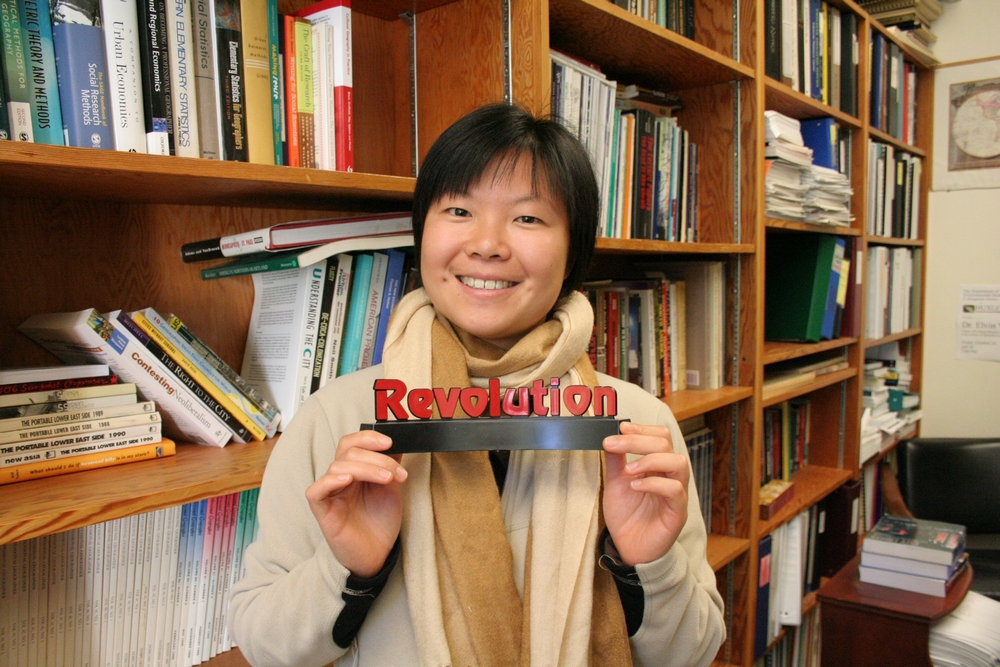
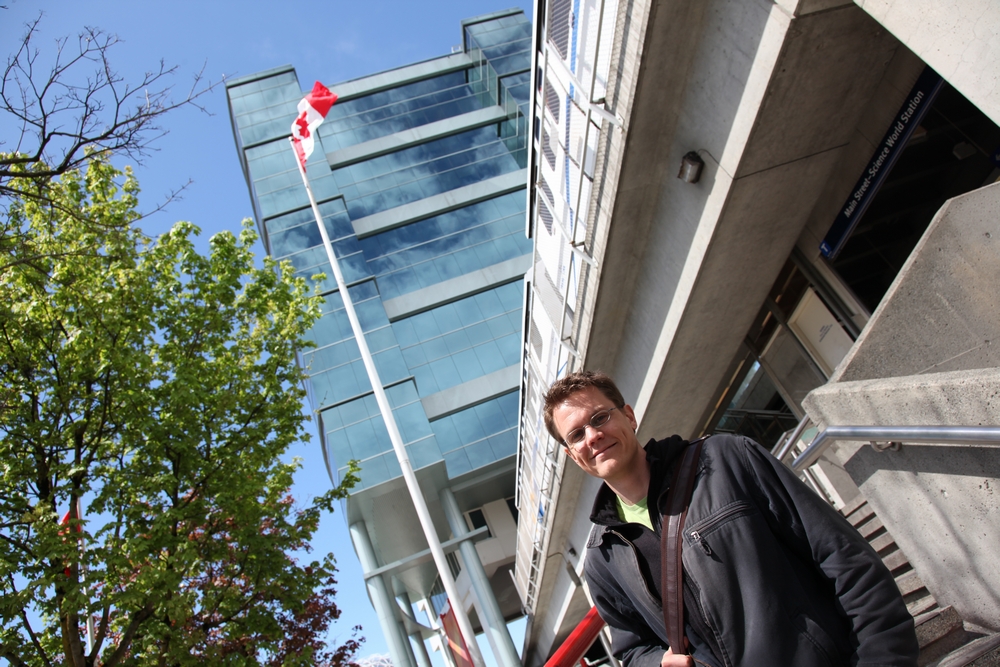
Markus Moosoutside one part of the infrastructure of mobility in the metropolis, the metropolis analyzed with such penetrating insight in Markus' ongoing research.
August, 2010
Mona Atia on Egypt
Mona Atia played a crucial role in our research here at UBC between 2003 and 2005, before completing doctoral work at the University of Washington. She is now Assistant Professor of Geography and International Affairs at the George Washington University. Her research focuses on Egypt, and when street protests spread from Tunisia to Cairo in late January, 2011, she was called upon to comment on the fast-changing situation. See:

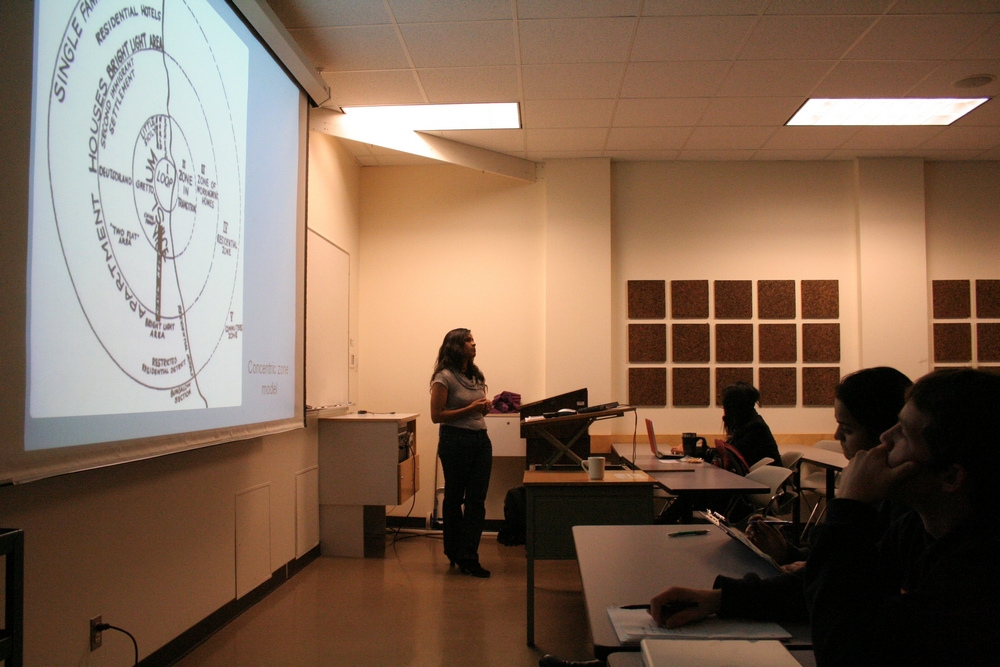

Alan McConchie
Delivering a stunningly brilliant lecture, "Future Urban Geographies." Geography 350, December 2, 2010. Alan's slides are here.

The Right to the City: The Case of Little Mountain
Tommy Thomson, delivering a powerful and eloquent analysis of the history of place and the dispossessions wrought by harsh neoliberal housing policy. Guest lecture in Urban Studies 200, Cities, November 25, 2010.
above: "The City as an Entertainment Machine," Urban Studies 400, April 5, 2011.
The image in the background is a graffiti mural of Martin Luther King, Jr., on King Street in Newtown, Sydney; the image was part of a brilliant presentation by Professor Geoff DeVerteuil, from the University of Southampton, UK, visiting UBC. Zoe Siegel (standing to Geoff's right) quite literally wears a bit of urban theory: "More Jane Jacobs, Less Marc Jacobs." The manifesto comes from a graphic designer in New York City, Mike Joyce, who was inspired to launch a guerilla campaign in Greenwich Village. "I guess what finally did it for me was watching about twenty of my favorite restaurants going out of business or being driven out by rents doubling and tripling," Joyce told an interviewer; "This is a sad and direct effect of the franchises like Starbucks, Ralph Lauren, and Marc Jacobs moving in." [quoted in Jeremiah Moss (2009). "More Jane, Less Marc." Jeremiah's New York: A Bitterly Nostalgic Look at a City in the Process of Going Extinct. New York City.]
Zoe sometimes wears the shirt while strolling down Robson Street (Vancouver's preeminent luxury retail strip) and sometimes at UBC. "When I'm on Robson, people ask, 'Who's Jane Jacobs?' When I'm at UBC, people ask, 'Who's Marc Jacobs?"

Ren Thomas,
delivering a brilliant guest lecture on urban spatial structure and the socio-spatial dynamics of ethnicity, immigration, and urban transportation for Geography 350, November 2011. Burgess would have learned a lot if he had listened to Ren before drawing that famous map. Also see:
Ren Thomas (2011). Resiliency in Housing and Transportation Choices: The Experiences of Filipino Immigrants in Toronto. Ph.D. thesis. Vancouver: School of Community and Regional Planning, University of British Columbia.
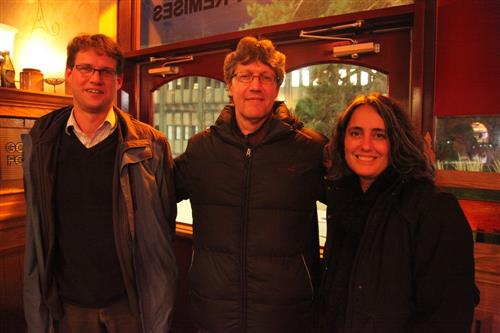
Doctor, Doctor-Doctor-Professor, and Doctor
Dr. Björn Surborg, Professor Jim Glassman (armed with a double-barrelled Ph.D. that is definitely not the sawed-off type), and Dr. Kathleen Sherrell. Vancouver, February 2012.
Current graduate student reading: a FredFest, a FredNick!
April 2012
The equation of brilliance and eloquence is
Nicholas Lynch (2012). Altared Places: The Re-Use of Urban Churches as 'Loft Living' in the Post-Sacred City. Vancouver: Ph.D. Thesis Draft, Department of Geography, University of British Columbia.
*
Fred Sham (2012). The Urban Political Ecologies of Vancouver. New York: M.S. Thesis Draft, Urban Planning, Columbia University.
=
Frednick Shamlynch
which I gotta tell ya is really more genuinely wow than ShamWow. Really impressive work, and the coauthorship / readership going on in my head makes Frednick Shamlynch =
Elvin Wyly * Jason Hackworth = Elworth Wyhack
or
James DeFilippis * Elvin Wyly = JaEl Wyflip
(but Jason suggests: Jelvin Wefilippy)
and in this FredFest, we all miss J.K. Gibson-Graham, and Fred Lukermann...
CopyLeft 2018 Elvin K. Wyly
Except where otherwise noted, this site is
"As my ideas get bigger, you get smaller."
This is what the six-year-old son tells his mother, Nell Casey. The boy's on to something. My goal as a teacher is to help you grow your ideas, until I become so small that I escape notice entirely!
Nell Casey (2012). "The Imaginative Arts." New York Times Book Review, April 8, p. 22.
Dr. Pablo Mendez (left), Dr. Ted Rutland (center), Distinguished University Professor Trevor Barnes (right), April 12, 2012.
WHWBP
Walter Hardwick Would be Proud
Ted Rutland, Ph.D, 2012 (left), Geore Rahi, B.A. 2012 (riight), Vancouver Olympic Village Housing Protest, May, 2010. September, 2012: George is starting the MA Program in Geography at UBC.
Fall Classes and the Curriculum of the Shopocalypse!
September, 2012: George Rahi, who's just starting the Master's program here at UBC, just returned from the Burning Man Festival. And whom did he see there? Among many others, Reverend Billy and the Church of Stop Shopping! "Amongst all the huge art works at Burning Man this year," George reports, "was a simulacrum of Wall Street, which was set ablaze near the close of the event. Inside some of the mock-up banks were tellers charging people fees for using pens and breathing air."*
*These thoughts are brought to you by EVERY ORIGINAL REV ELEGY, Inc. Upon reading these words and thinking about the implications, you hereby agree to a recurring charge of $1.00 Cdn, billed to your credit card after one month of thought, followed by a re-billing cycle of one week, then one day, then one hour, then one minute, then the currently prevailing LIBOR bid-speed of Wall Street's high-speed trading algorithms. All funds will be used to support UBC Geography Graduate Students for Another World is Possible.
Photograph by George Rahi, posted by permission.
Benjamin Jelsma maps Alonso for the Twenty-First Century. The urban planner William Alonso, and the geographer David Harvey, documented in the 1960s the essential paradox of the urban land market: poor people live on expensive land, while wealthy people usually live on cheap land in the spacious suburbs. Benjamin did a remarkably rigorous, empirically detailed, and analytically careful internship and Geography 448 Directed Studies project on the way this paradox plays out in the Nashville area.
Source: Benjamin Jelsma (2012). "Affordable Housing Assessment: Hamilton Springs." Nashville, TN: Nashville Area Metropolitan Planning Organization, 33pp. Posted here by permission.
Sam Johns (left) and Liam McGuire, Vancouver, November 2012
Liam completed his MA in Geography in May, 2012, and just delivered a guest lecture in Geography 350 on his work on the "Ten Cities of Toronto." Sam's immersed right now in fieldwork and writing on his MA thesis, under the joint supervision of 1) Canada's most highly cited geographer (David Ley) and 2) the bizarre autodictactic-enigmatic-neoLuddite cyborg-HTML-coder presently tapping out these words. Sam delivered a truly brilliant talk at the 2012 "Decolonizing Cascadia" conference: "First World Problem: The Aesthetic Athlete and Alienation from Self." Taylor, Kierkegaard, Foucault, T.S. Eliot, and the complex trajectory of the weekend warrior self in an age of sensation ... powerful and eloquent, so stay tuned for the thesis and the screenplay. This is Hollywood North, after all...!
And yet another update: Liam has been awarded the 2012-2013 J. Lewis Robinson Memorial Scholarship. From the citation: "This scholarship is offered every year to a graduate student with high academic standing studying Human Geography with a Canadian focus. The awards are made on the recommendation of the Department of Geography in consultation with the Faculty of Graduate Studies. The scholarship has been endowed by the family of J. Lewis Robinson and by his friends and former students to honour his life and achievements at UBC. Dr. Robinson was the first professional geographer employed by the federal government in 1943. He went on to become the founding head of UBC Geography."
Source: Ian McKendry (2012). Letter to Liam McGuire Re: J. Lewis Robinson Memorial Scholarship, November 2. Vancouver: Department of Geography, University of British Columbia.
Absolutely brilliant!
above: Emily Rosenman, Emma Abdjalieva, and Rebekah Parker
...amidst a wide-ranging discussion of the ongoing housing and speculative capital crisis of U.S. urbanism, the politics of quantification, the expansion of a Foucauldian surveillance infrastructure that is changing writing (see this), and the reconstruction of community and sense of self on the transnational social network...
December, 2012
Sam Walker in action ...
"Urban Geographies of Food Deserts," in Geography 350, Introduction to Urban Geography, November 2012.
Emily Rosenman
"Demolishing the City to Save It? Destruction in the Name of Renewal in U.S. Cities."
Guest lecture to "Cities," Urban Studies 200 / Geography 250, November 2012.
Ivanhoe Pub, June 2013
Iain Marjoribanks, Gurtej Tung, Kevin Chan, Hannah D'Souza, Molly, Tomi Ihalainen, and Pierson Nettling
Natalia Torres Condia and Joseph Daniels, hard at work in the new Urban Studies Commons, Geography Room 126
June 2014: Lachlan Barber, Ph.D.!
Lachlan Barber (2014). A Relational Geography of Heritage in Post-1997 Hong Kong. Vancouver, BC: Department of Geography, University of British Columbia.
Office Hours at the Salt Building
(suitably brewery-ized at the Olympic Village)
June, 2015
Water and sewer municipal financialization in Alabama and Mississippi, retail spectacularization in Singapore's real estate investment trusts, ... and a few good beers.
Above: Dr. Björn Surborg, Vancouver, July 2015. Dr. Surborg is Principal Adviser for Climate Finance Governance at Deutsche Gesellschaft für Internationale Zusammenarbeit, based in Dhaka, Bangladesh. In his work here at UBC, above and beyond his cutting-edge analysis of the contemporary transnationalized staples economy of global mining firms, he mobilized a series of multi-method, interdisciplinary analyses of the community response to the planning for Vancouver's 2010 Winter Olympic Games. See, for example: Van Wynsberghe, Rob, Bjoern Surborg, and Wyly, Elvin (2013). "When the Games Come to Town: Neoliberalism, Mega-Events and Social Inclusion in the Vancouver 2010 Winter Olympic Games." International Journal of Urban and Regional Research 37(6), 2074-2093 and Surborg, Bjoern, Rob VanWynsberghe, and Wyly, Elvin K. (2008). "Mapping the Olympic Growth Machine: Transnational Urbanism and the Growth Machine Diaspora," City 12(3), 341-355.
"On the second full day of a campaign already deemed endless, Conservative Leader Stephen Harper appeared in Toronto Tuesday to promise help for those who economists say mostly don't need it. In the heart of Toronto's overheated housing market, where the average detached home now sells for more than $1 million, Harper vowed to make life better not for those struggling to enter the market, but for those who already own their own homes." Richard Warnica (2015). "Harper Pledges Help for Homeowners." National Post, via the Vancouver Sun, August 5, p. B2.
While in the Graduate School of Journalism at UBC, Richard took our seminar, Critical Measures of Urban Inequality, several years ago.

Chiyi Tam
upon graduation and with the world in her hands
September 2015
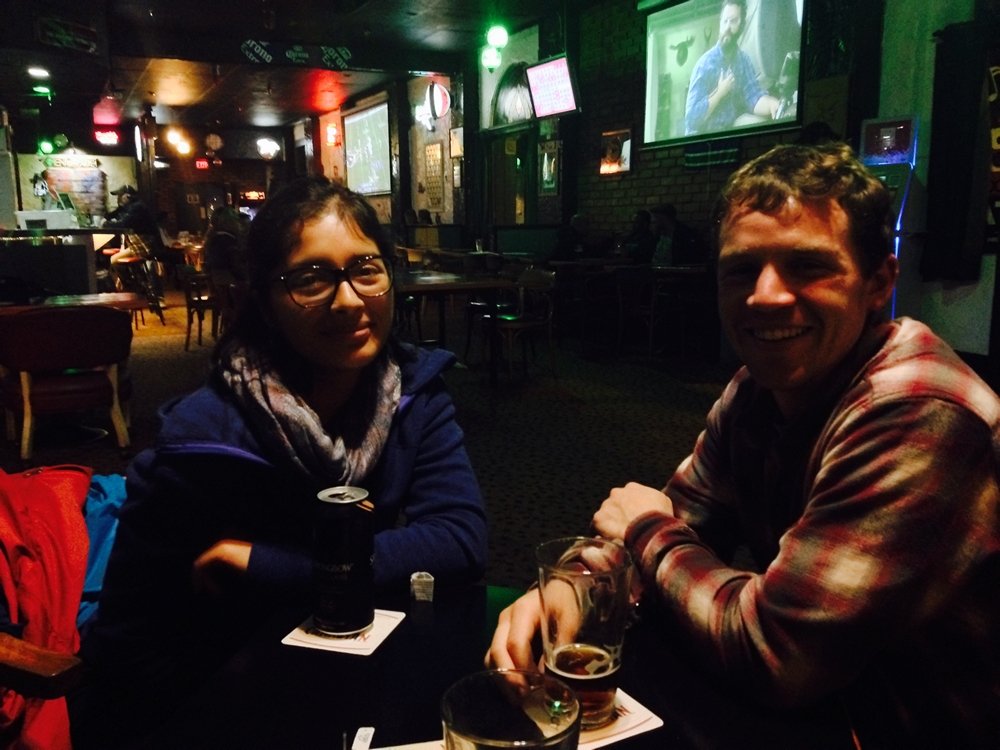
Claire and Liam McGuire, Vancouver, October 2015. Fire me, hire them!
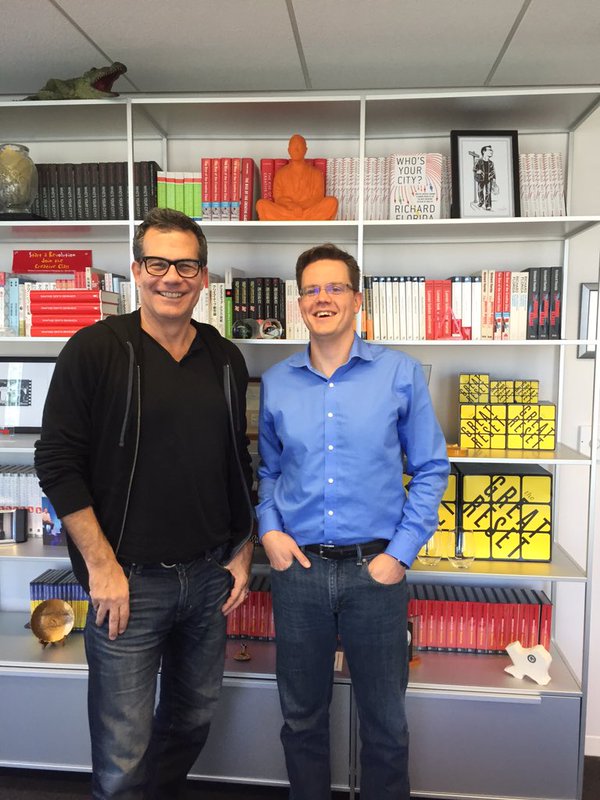
Richard Florida and Markus Moos, January 2016
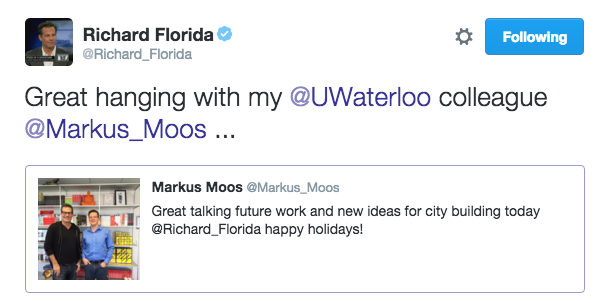
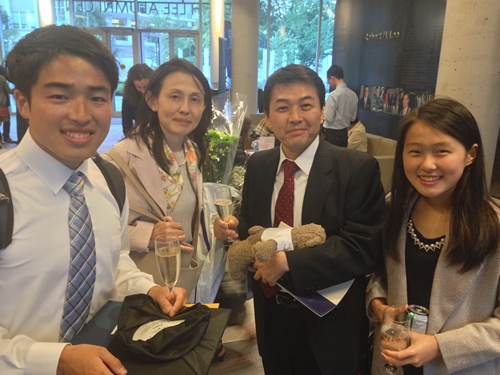
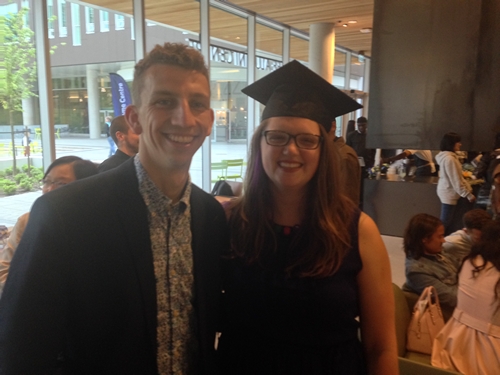
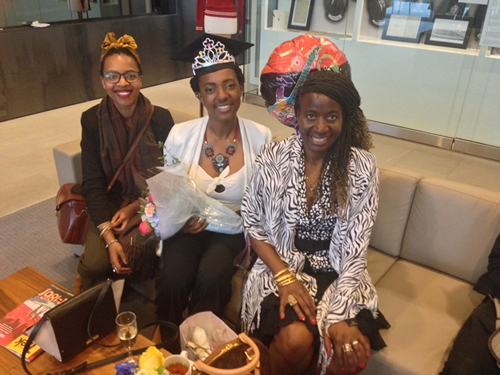
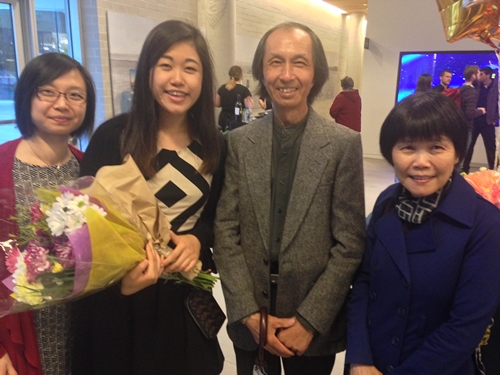
Tinthi Tembo
Emily Huang
Anne Kessler
Ryo Kawanishi
Graduation 2016!
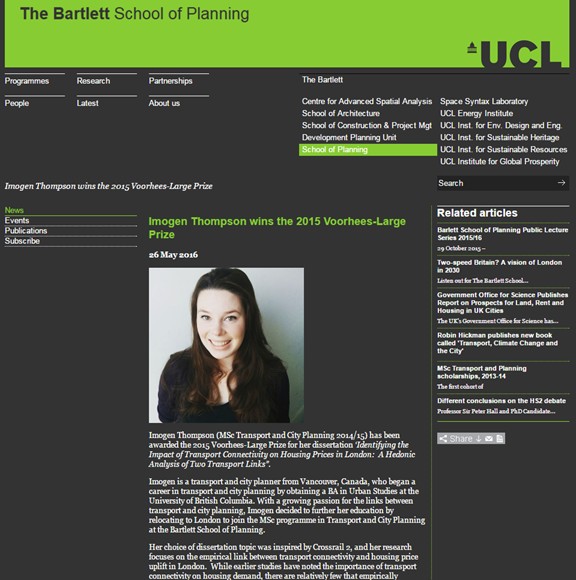
Imogen Thompson wins the Voorhees-Large Prize at The Bartlett School of Planning, University College London. The Prize is awarded for the best dissertation submitted by a UK resident studying for a Transport Master's degree.
"Imogen Thompson (MSc Transport and City Planning 2014/15) has been awarded the 2015 Voorhees-Large Prize for her dissertation 'Identifying the Impact of Transport Connectivity on Housing Prices in London: A Hedonic Analysis of Two Transport Links'.
Imogen is a transport and city planner from Vancouver, Canada, who began a career in transport and city planning by obtaining a BA in Urban Studies at the University of British Columbia. With a growing passion for the links between transport and city planning, Imogen decided to further her education by relocating to London to join the MSc programme in Transport and City Planning at the Bartlett School of Planning.
Her choice of dissertation topic was inspired by Crossrail 2, and her research focuses on the empirical link between transport connectivity and housing price uplift in London. While earlier studies have noted the importance of transport connectivity on housing demand, there are relatively few that empirically investigate the variety of factors that contribute to this phenomenon . Imogen's research analyses and tests the empirical link between housing prices and connectivity, and provides evidence that lends strength to future transport and housing business cases, appraisals, and policymaking in London. Using hedonic modelling, her research compares an original database of 28 variables across 16 London Boroughs. The results demonstrate the impact value of each variable on housing prices in London, and provide evidence of a tangible link between London transport projects and housing price increases.
Graduating from UCL with Distinction in September 2015, Imogen joined Transport for London as a Graduate Transport Planner. She is putting her research to good use, working on Crossrail 2, with a focus on evaluating the development potential and the strategic impacts Crossrail 2 will have on transport, housing and jobs in London.
On being told she had been awarded the Voorhees-Large Prize, Imogen said:
'I am extremely passionate about my career and my field of study, so winning the Voorhees-Large Prize is a huge honour for me. The recognition of my work by the Brian Large Trustees will support my research and its applications in the field of transport planning going forward. Beyond the impact this award will have on my research and its professional applications, it is also a great honour for my work as an academic to be recognised in the UK. This prize is a testament to my decision to move across the world to expand my education and knowledge in my field of study.'
The Voorhees-Large Prize
The Voorhees-Large Prize, which is worth £500, is awarded by the Brian Large Bursary Fund
for the best dissertation submitted by a UK resident studying for a Transport Masters. It will
be presented to Imogen at the Transport Practitioners' Meeting's Awards Dinner in
Nottingham on Wednesday 29 June.
The prize complements the Brian Large Bursaries which the Fund awards to UK transport Masters students. This year, three students studying full time for transport Masters at Leeds and Salford Universities are being helped in financing their studies.
The Brian Large Bursary Fund is a registered charity, formed by Brian Large's family, friends and colleagues to keep his memory alive following his death in 1989.
'The Brian Large Trustees are very pleased to award the 2015 Voorhees-Large Prize to Imogen. The Voorhees-Large prize remembers Al Voorhees, who was a leader in the early days of transport planning and had a particular interest in the links between transport and urban development, and Brian Large, who spent the first part of his career working for the Greater London Council. Each of them would have been fascinated with Imogen's work.' -- Martin Richards, Brian Large Trustee
Latest Update from Manu!
"The map plots the locations of students attending a McMaster University course called "Finance for Everyone" being distributed through Coursera. I'm looking forward to participating in this global exchange about finance and how it relates to decisions, environment, value, debt, human rights, etc... I hadn't quite fully appreciated the global reach and some clear underrepresentation, at least from African continent."
Below:
Ren Thomas
June 17, 2016
at the launch for her landmark edited collection, Planning Canada: A Case Study Approach. UBC's Faculty of Applied Science media relations folks covered it this way: "A panel that included 10 of the authors -- including faculty, adjunct faculty, and graduates of the UBC School of Community and Regional Planning (SCARP) -- answered questions about their research and the state of the art of planning in Canada." The book "presents a series of case studies, driven in a non-specialist-centered language, that will be accessible to students in disciplines beyond planning and engages the reader with real-world solutions, failures, and thought-provoking realities. Claire Kiernan (2016). Book Launch: Planning Canada Takes New Approach to Preparing Students. Vancouver: Faculty of Applied Sciences, University of British Columbia.
Explosive Brilliance in the Networked Noösphere
Joe Daniels successfully completed his Comprehensive Doctoral Exams today. It was a wonderful, wide-ranging discussion inspired by Joe's written examinations -- six eloquent, thick scholarly analyses of multiple literatures in political economy, financialization, and alternative economic futures. The discussion was facilitated by the ever-improving planetary communications-consciousness infrastructure: Joe and Trevor Barnes in Vancouver, Canada; Sarah Hall and Andrew Leyshon from Nottingham, England; and then, midway between on the time zones but a bit South, me Skyping in from Santiago de Chile. Below: my view of the Noösphere from the office kindly loaned to me by Ernesto Lopez-Morales and other brilliant colleagues at Universidad de Chile. A tiny excerpt from one of Joe's amazing essays, that suddenly brings me back to conversations with Julie Graham so many years ago: "Class is recuperated from its fixed position of 'structural' Marxism by connecting the overdetermination of class to feminist intersectionality, such that class becomes a way of reading for difference in and drawing attention to the diverse ways in which 'surplus value', being necessary for all economic geographies (Lee and Leyshon 2003; Lee 2006), is allocated. It is from this sea of difference that 'alternatives' are birthed. But they are birthed not because they are intrinsic (Jones 2010), but because they are made, or performed. They are performed from the (local) intersections, that is the 'space between the Being of present Capitalism and the Becoming of Future capitalism as the place for the indeterminate potentiality of noncapitalisms' (Gibson-Graham 1996:90-91)..."
Avatar links for a few of the students past and present who've been teaching me...
Emily Rosenman, Ph.D., 2017
An absolutely amazing analysis, from a leader of the new generation of critical cartographers of 'moral' and 'ethical' capitalism, of a capitalism monetarizing and valorizing everything (even, especially, the best of intentions), creating a new world urban system of 'moral rent gaps.'
THE SPACES OF SOCIAL FINANCE: POVERTY REGULATION THROUGH THE “INVISIBLE HEART” OF MARKETS
Abstract: Social finance is a style of investing organized around the theory that private profitmaking can create positive benefits for society. It is practiced through a diverse range of financial instruments that invest in welfare and anti-poverty services, making the “social” into the object of financial investment. In the wake of the financial industry’s crisis of legitimacy after the 2008 global financial meltdown, social finance attempts to reframe finance as a force for, rather than barrier to, social good. As governments embrace social finance and as new investors flock to the sector, this dissertation asks whether social finance uses profit to engender a more holistic range of values – as argued by the movement’s proponents – or whether it marks a further entrenchment of financial logics into existing models of poverty regulation. The research questions explored here are: 1) what are the institutional configurations of the industry, 2) how does social finance represent financial and social value, and 3) what are the relational connections between what I call the ideology of social finance, its models and calculative practices, and the governance of poverty interventions? I answer these questions through a commodity-chain approach, analyzing social finance models in relation to case studies of how investments in the American subsidized housing sector are marketed and made. The project draws from multi-sited ethnography, participant observation, and document analysis. I find that social finance appropriates existing models of poverty alleviation in what I argue is a process of financialization. To attract new capital, social finance operates through shifting the governance of the anti-poverty industry toward profit logics and prioritizing investor decision-making over funding priorities, muting the role of government and NGO service providers in determining social needs. The success of social finance projects depends on segmenting people and places into those deemed more or less deserving of investment; profits rely on expanding the infrastructure of contracted-out intermediaries that have facilitated private investments in welfare since the 1970s. In practice, social finance marks more a shift in the governance of anti-poverty programs than a shift in the practices of the financial industry.
Idaliya Grigoryeva, MA, 2017
Abstract: The housing market in Vancouver is the most unaffordable in North America. Although extensive research has been done on price drivers and general trends, there is little understanding of how the price increases spread out through Metro Vancouver. To better understand the spatial spread effects in the local housing market, this study quantitatively examines spatio-temporal price diffusion by mapping price changes for detached houses over the last decade across the metropolitan area. Using median selling prices for single-family homes, additional measures of volatility and cycles of price peaks and troughs are constructed to identify spatial price diffusion patterns. Volatility and break-point analysis is supported by cross-correlation estimates of interconnectedness between non-central price dynamics and the price changes in the metropolitan center, where new price impulses arrive. Finally, multiple linear regressions for price changes in both central and non-central regions are estimated in several specifications: individual equations by municipality and a joint panel data equation for 15 non-central municipalities. Both specifications, as well as estimation methods (OLS and fixed effects), indicate the presence of a ripple effect from the highest-priced central regions (Vancouver West and West Vancouver) to the peripheral suburban regions up to Abbotsford and Mission in the Fraser Valley with the result being robust for both monthly and quarterly data. The ripple effect is observed across contiguous and non-contiguous areas making the entire Greater Vancouver area susceptible to price shocks that occur at the center.
Rachel Brydolf-Horwitz, MA, 2017
If you're reading these words, there's only a 51 percent chance you're a human. Bots are on the verge of outnumbering human beings on the internet. To make matters worse, too many of those humans online seem to be devolving towards something pre-human, in a deeply retrograde, brutish recrudescence of Neandertal violence. The futuristic frontiers of augmented reality are co-evolving with a backward-looking misogynistic cybernetic patriarchy.
It's a frightening, violent landscape. But we desperately need cartographies of this new hybrid cybernetic territory. Rachel Brydolf-Horwitz is our guide, helping us navigate through the valley of the shadows of digital death towards a more emancipatory world of empathy, care, friendship, and community.
Abstract: Technology-facilitated violence faces a dangerous combination of attitudes: that such violence isn’t serious and that it can’t be regulated. I look at linked events – the experiences and suicide of a young woman, and the passage of Canada’s first standalone anti-cyberbullying legislation – to analyze the workings of the Canadian justice system and the consequences of thinking about the digital as ‘not real life.’ The young woman, Rehtaeh Parsons, came to symbolize the dangers of cyberbullying, but her case involved sexual assault, the distribution of a photograph of that assault, and lengthy navigation of the justice and mental health systems in addition to the abuse directed her way via technology. In trying to understand how violence ‘online’ is naturalized and why the harms of technology-facilitated violence receive uneven recognition, I look at the roots and consequences of assumptions that orbit Rehtaeh’s case. I illustrate how as a young woman, her allegations of sexual assault were disclosed and confronted institutionally in an environment and culture steeped with longstanding discriminatory myths and stereotypes, especially around gender, alcohol, consent and sexuality. The distribution of the photograph of this traumatic night and the abuse around it were similarly invisibilized. They did not represent to the police an incident of tangible, corporeal harm because of a number of beliefs about digital technologies. In addition to the persistent partition of online and offline, with offline envisioned as ‘real life,’ I discuss how the widely used metaphor of the Internet as a frontier zone locates it on the edge of or just outside of the reach of the law. In effect, while greater attention to cyberbullying holds the promise of increasing recognition of technology-facilitated violence, there remains a disconnect between the embodied experiences of technology-facilitated violence and legal and social recognition of harm.

Samuel Johns
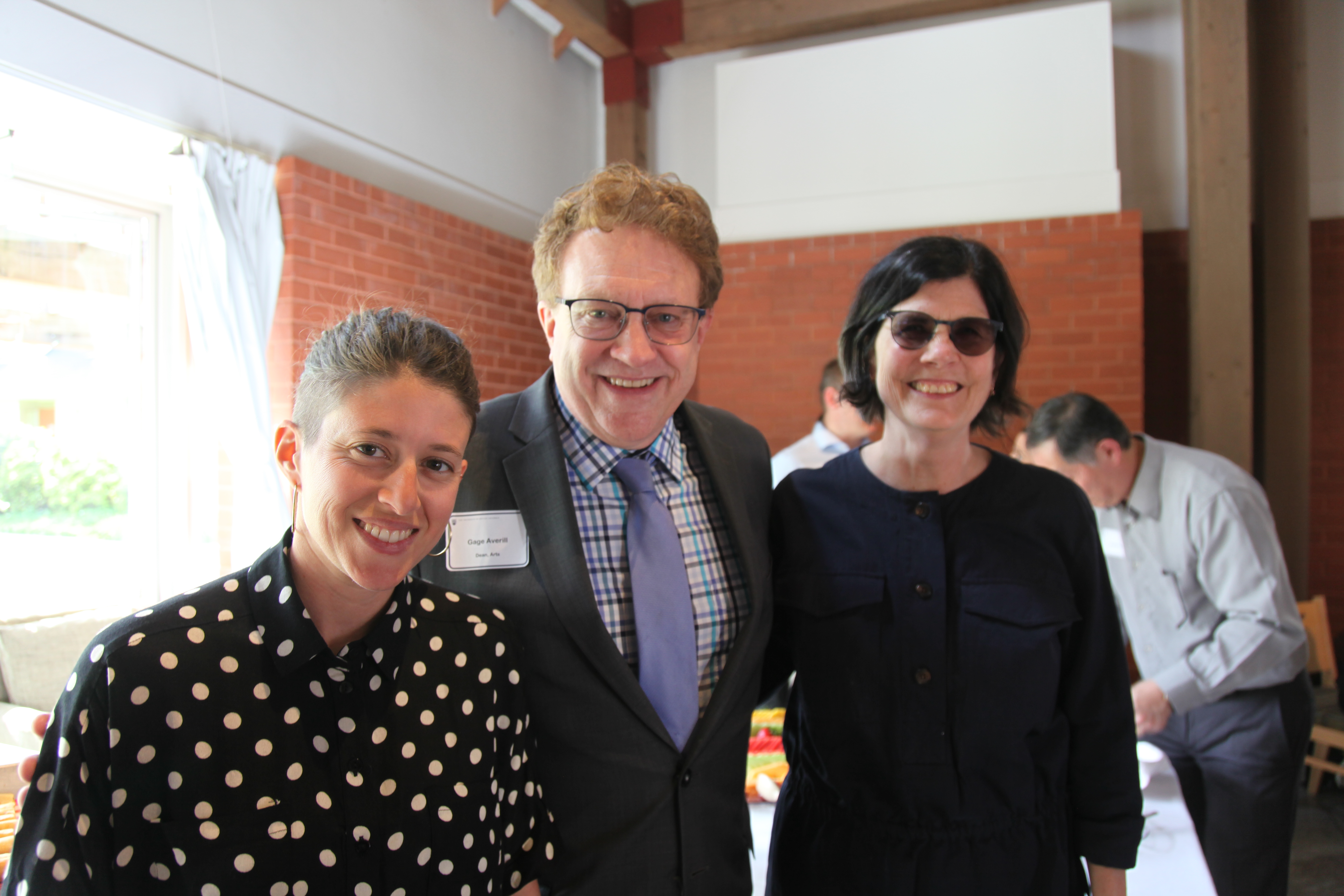
Rachel Brydolf-Horwitz
With UBC Dean of Arts Gage Averill and Canada Research Chair Geraldine Pratt, April 2018
Rachel won the prestigious Killam Graduate Teaching Assistant Award, 2018
The Brilliance of Mount Pleasant Philosophy
Anson Ching taught us an enormous amount a few years ago in his work in Urban Studies and Geography; along the way, he won the prestigious Sir Peter Hall Prize in Planning Futures for his truly remarkable paper, "Virtualia as Urbanity's Wild West: The Unbounded-but-Gated Landscape in the Last Frontier." It's an impressive analysis of how contemporary technologies of virtual reality and augmented reality carve out new, multidimensional spaces of altered urban perceptions -- while also re-producing some dangerous competitive, unequal dynamics from the earliest generations of industrial colonial urbanization. Anson's subsequent work in Political Science has been impressive indeed, and on the side, Anson also volunteers with heritage tours in Vancouver's Mount Pleasant. What a joy to explore the neighbourhood and learn from him -- and, along the way, Anson educated me on Plato, Kant, Nietschze, Hegel, Locke, Hobbes, Rorty, Arendt ...


"For many on Monday, the experience came in a blur of white and a loud crash. Dozens of people, of all creeds and races and ages, rushed to help. But for others the realization of what happened, of what they had seen, only came later."
Richard Warnica, on Alex Minassian's horrific van rampage in Toronto, which killed ten and injured sixteen more. While completing a Journalism degree years ago at UBC, Richard took one of our urban geography seminars. Jake Edmiston and Richard Warnica (2018). "Taking a Walk Down Yonge." Vancouver Sun / National Post, April 28, NP1, NP2.

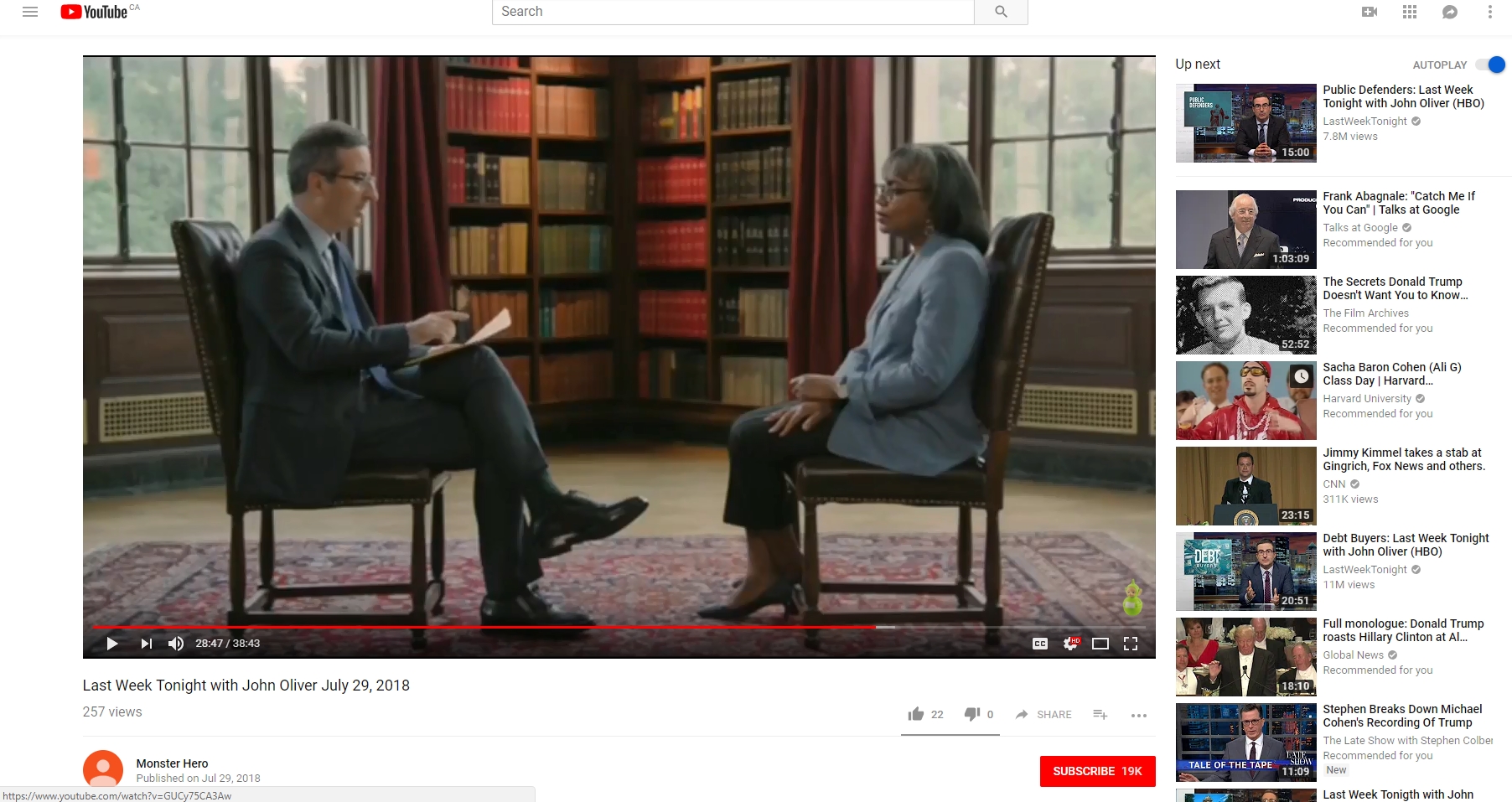
Anita Hill on John Oliver!
July, 2018
Congratulations to Sherry Yang, upon completion of her Comprehensive Doctoral Examinations, March 2019!
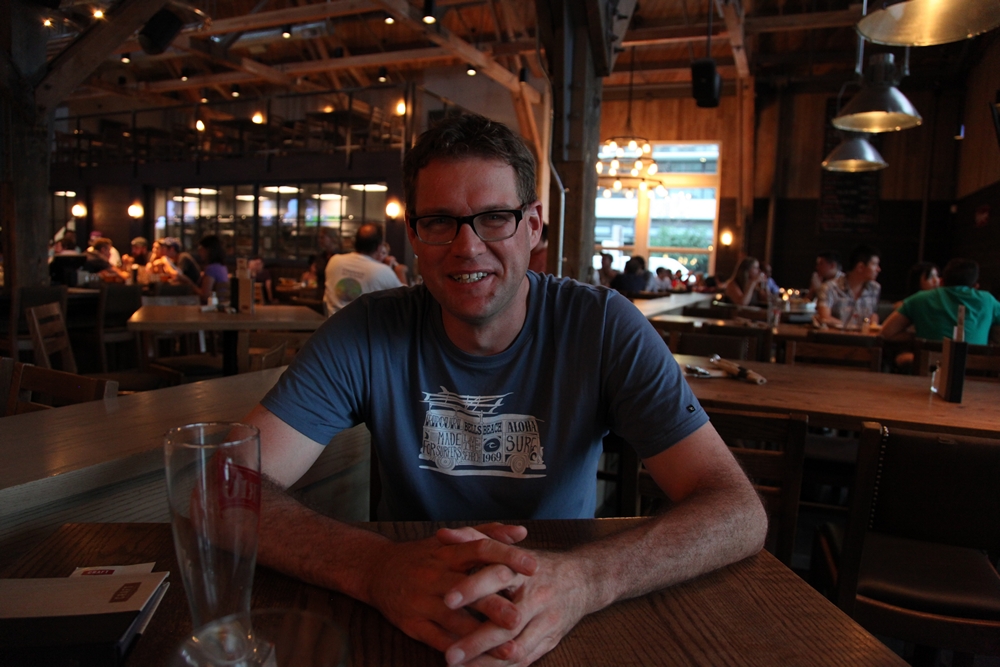
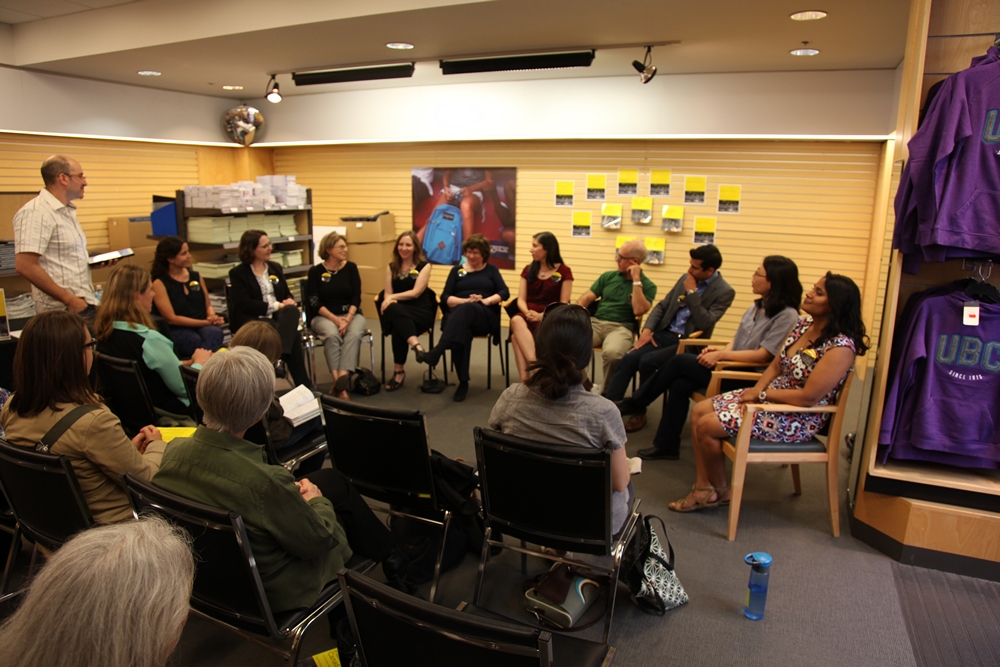

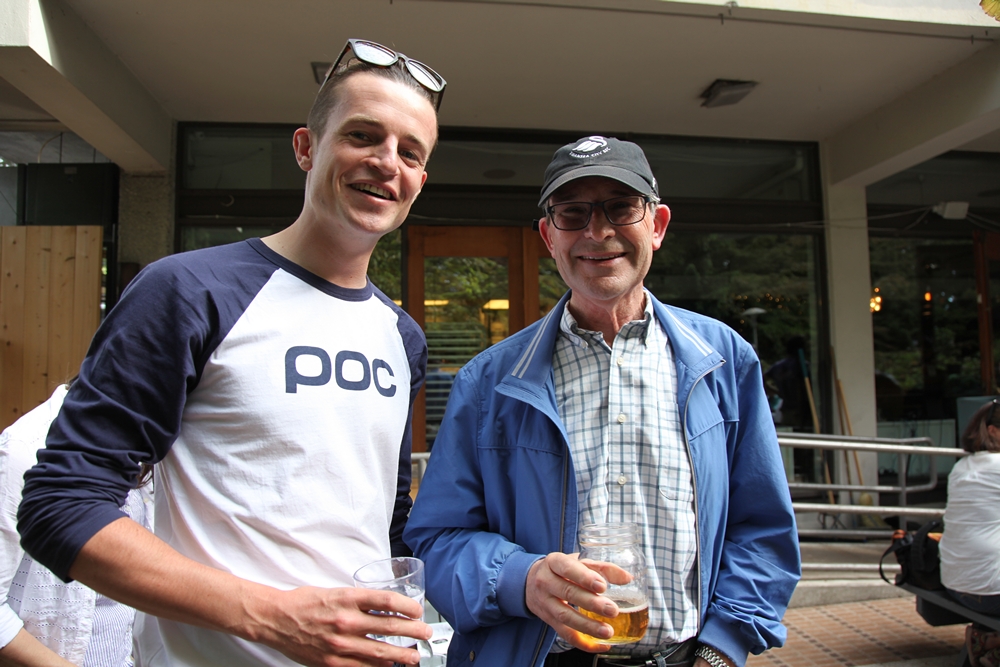
Sam Johns, of the Partnership for Sustainable Development Nepal, returns for a short visit to UBC Geography, with Professor Emeritus David Ley, June 2019
Noriko & Jun Ishiyama, Jason Hackworth, and Quinn, Winnipeg, July 2019
Check out Liam McGuire's brilliant multivariate sociospatial analyses of Toronto and Ottawa!

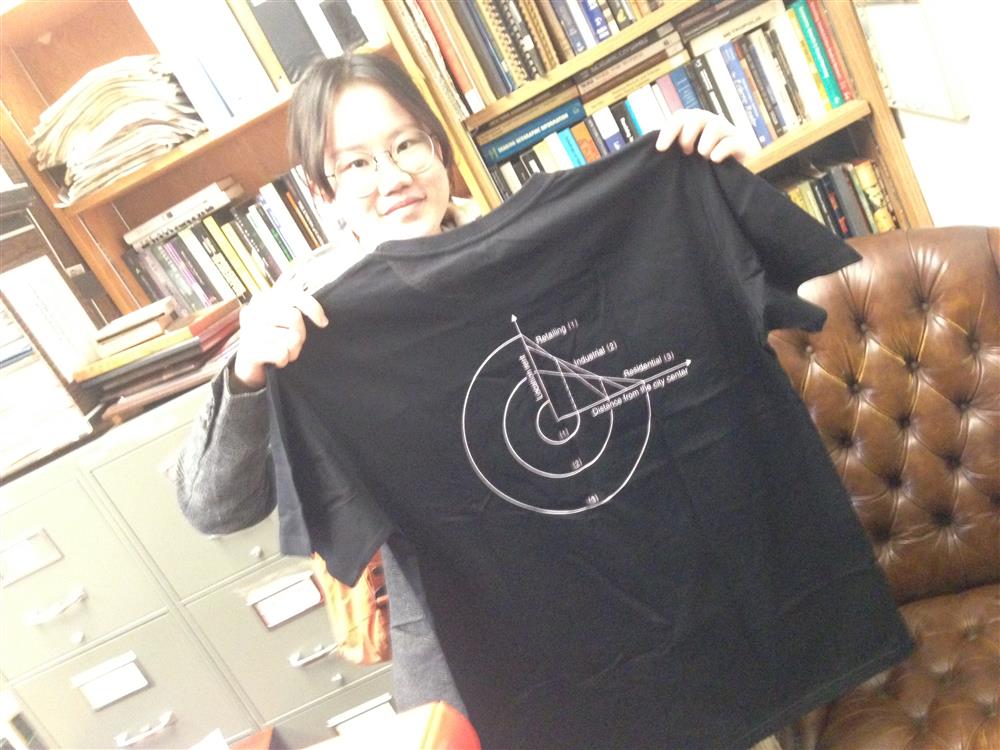



How a scholarly citation and a quote from the literature comes alive for new generations seeking to build Social Justice in the City! Courtesy of the brilliant River Sun, who earned the Walter G. Hardwick Scholarship in Urban Studies, completed a B.A. in Geography at UBC before heading off to Cambridge for graduate work! Here's how a citation from Harvey (1973, p. 137) comes alive...!
Nico Jimenez
MPhil, Geographical Research, Cambridge, 2020, and alum of Political Science and Human Geography (Honours), UBC, 2018. For just one small sample of Nico's brilliance, see Jimenez, Nicolo (2018). "Driving Innovation: Fueling the Transition from Rust Belt to Brain Belt." Trail Six 12, 71-82.
*


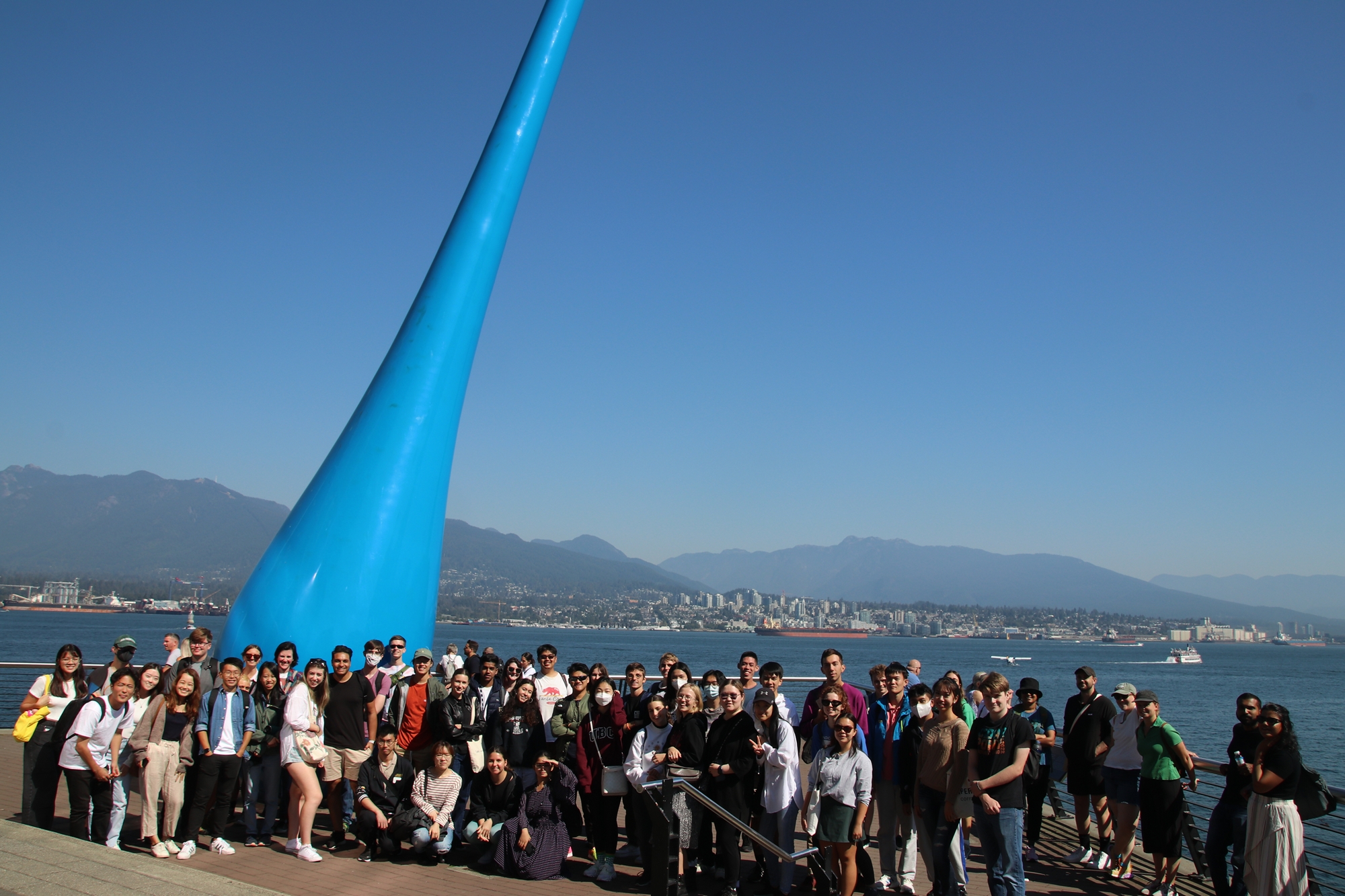
Students
